Robert "Bobby" Smith - He didn't come home.
April 26, 2024
By Lola Guess (Information from an article by Charles Lay)
“Smitty was in the foxhole next to mine. I am pretty sure that we were both on the same chopper that took us out of a hot LZ. He was not alive and for some reason I was. Smitty and I were in the same squad. He is one of the few guys I remember.” This is part of a statement posted by a fellow serviceman describing the fateful day Robert Lewis Smith was killed by enemy fire during the Vietnam War.
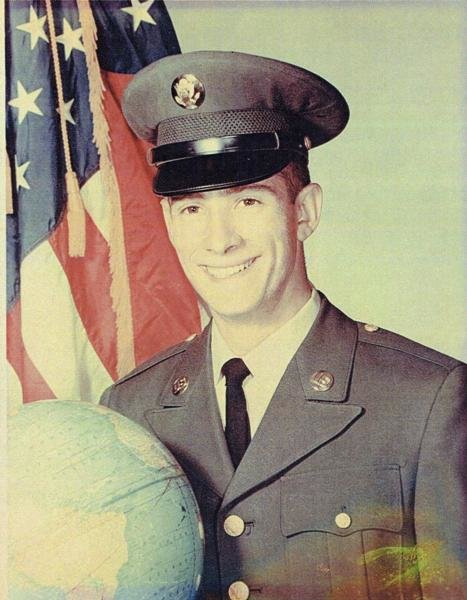
PFC Robert Lewis Smith
Bobby enlisted in the Army on October 19, 1967. He was soon sent to the Republic of South Vietnam and started his tour on March 28, 1968, in Military Zone 1, in the Quang Tri Province. Quang Tri was the site of some of the fiercest ground fighting and was subjected to the heaviest bombing in the history of the world.


Medals awarded to Bobby
Vietnam Veterans Memorial in Washington, D.C.

PFC Smith was killed by artillery/mortar/rocket fire on Thursday, June 6, 1968. This attack occurred just 70 days after his arrival in Vietnam. He was only 20 years old.
Bobby was the son of Chester and Ruby Smith. He was born on April 5, 1948, in Livingston County. His family included a sister, Judy, and brothers, Terry, and Timothy. He was a 1966 graduate of Livingston Central High School. Bobby’s funeral was held at Livingston Chapel United Methodist Church on June 20, 1968, with burial in Ferguson Cemetery.

Photo by Teresa Bragg Rice
JOY GROCERY STORE
April 19, 2024
By Lola Guess
In the early morning hours on Wednesday, June 21, 1996, Carrsville resident, Virginia McDonald Quertermous’s phone started to ring. When the owner of the Joy Grocery Store answered the phone, she was shocked to learn the store was on fire. Virginia hurried to the scene to find the grocery store burning to the ground.
When Burna Assistant Fire Chief J. L. Culver arrived at 2:45 a.m., he stated that the store was already engulfed in flames and there wasn’t anything the fifteen volunteer firefighters could do.
Henry Myrick was the first person to own a store in Joy. Bill Kiebler was also an early storekeeper. In fact, this was the second time a store had burned at Joy.
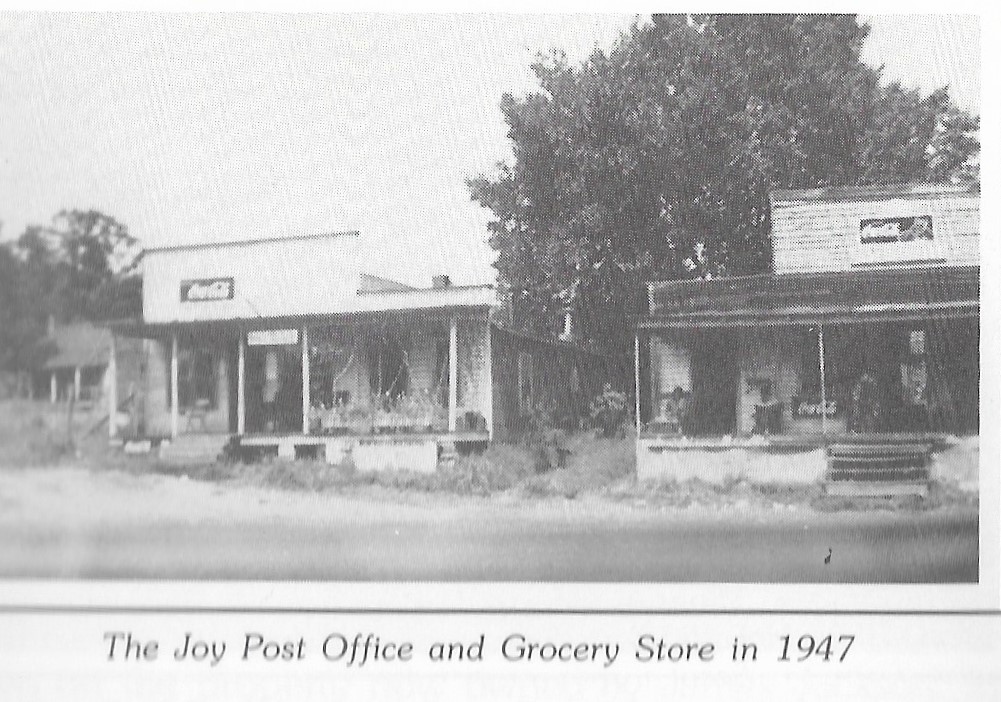
In 1996, Virginia Quertermous had been the owner for the past eleven years. As in most small towns, the general store was more than a place to buy groceries. It was a meeting place where people gathered daily around the stove for sandwiches, a cold drink, or just to talk and tell “tall tales.” Virginia rented videos, had a tanning bed, ran the deer check station in hunting season, and began cooking breakfast for the hunters before daylight. Motorcycle groups passed through Joy following the route of the “Trail of Tears” and often stopped there for lunch.
Virginia served full plate lunches including pizza, chicken and dumplings, chicken and dressing, pies, cakes, soups, and cornbread. A bowl of soup and a slice of cornbread was $2.75 and drinks were fifty cents.
Without delay, the store was rebuilt and opened again for business in November 1996, the same year it was destroyed. Although Virginia worked long hours, she stated she has wonderful memories of the Joy residents and the people that came from far and near to Joy.
Two years after the fire, Virginia was ready to retire for the time being. She sold the store and it stayed open for business until 1999 when the Joy Grocery finally closed its doors.
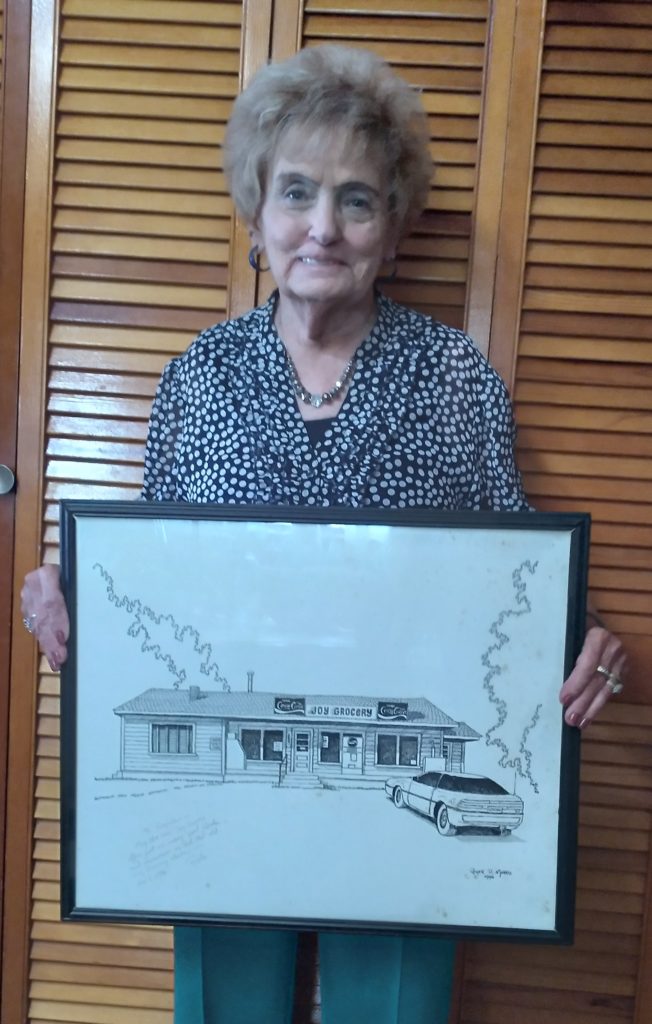
Virginia treasures the drawing of the original store a local artist, Roger Morris, gifted to her.
The Rock Room
April 12, 2024
By Lola Guess
The Livingston County Historical Courthouse Museum is open for the 2024 season. Please check the Museum page for dates and information. We have a lot of things planned at the Museum and at the Historical Society for this year. We will be making announcements soon. There is so much to see, experience, and learn at the Courthouse Museum.
The mining industry in Livingston County was at its peak in the early 1900’s. The “Rock Room” in the Museum showcases this era with information about the mines, rocks, minerals found in and around Livingston County. The beautiful rocks and minerals on display includes fluorspar, calcite, fluorite, iron ore slag and many other categories. The pictures below feature specimens that fluoresce under a black light. This makes these already fascinating rocks stand out even more.

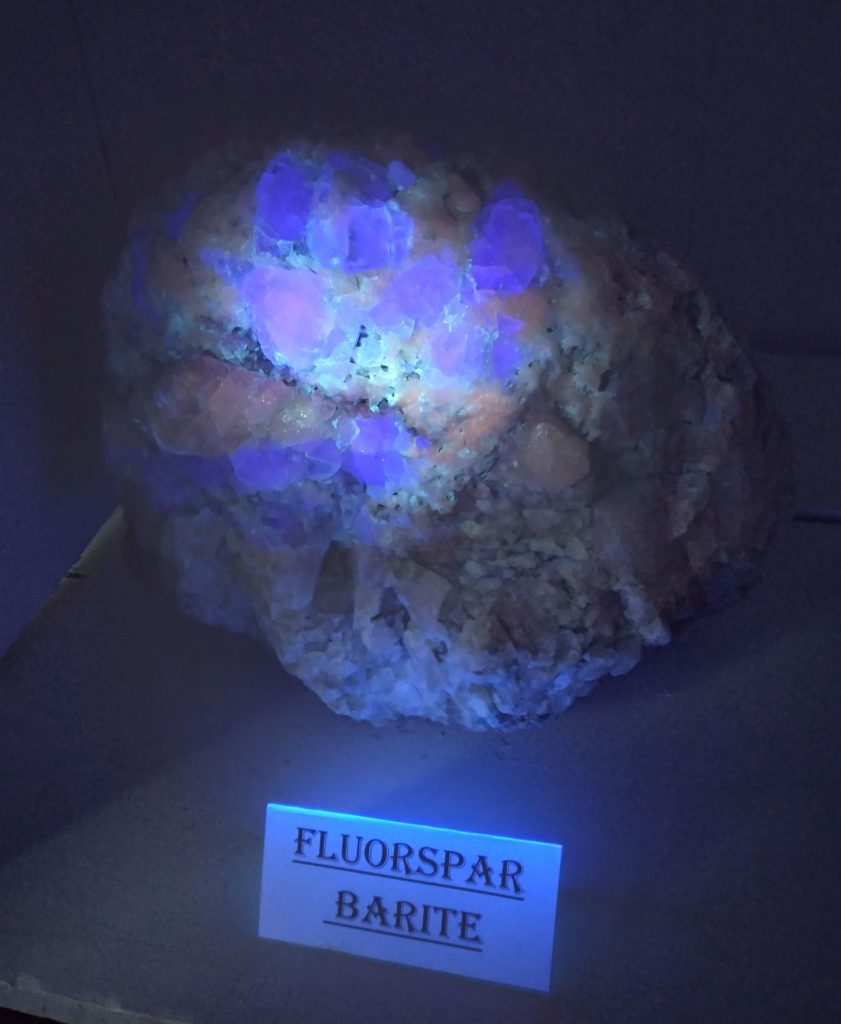
Frank Boyce Moodie IV and his wife, Terri Moodie, have been instrumental in making our displays come to life and giving us the knowledge and background on the specimens. The Moodie family has been in mining for generations and we appreciate their professionalism and the information they have shared with the Historical Society. The generations of mining began with Frances Berrien Moodie who came to Livingston County in the 1870’s. He would scout the county for mineral formations and buy mineral leases. His son, F. B. Moodie Sr. (1874-1955) followed in his father’s footsteps. They were both interested in geology and owned fluorspar mineral mines scattered around the county including the Royal Silver Mine which was the oldest mine in Livingston County. The Klondike Mine, also owned by the Moodie’s, employed 500 people during the Great Depression. F. B. Moodie Jr. (1907-1979) continued in the family business and passed the mining legacy to his son. He was described in a Paducah Sun article as “maybe the most independent man in his county and if you know Livingston County, that’s saying something.”
Frank Boyce Moodie III, the fourth-generation operator in the Western Kentucky and Southern Illinois fluorspar industry was born in 1935 and passed away in 2018. His tombstone reflects his dedication to the family business. It reads “Rock Star – The rocks spoke to me, and I understood.”
We look forward to your visit at the Museum in 2024!

Boyce Moodie III in the 1970’s
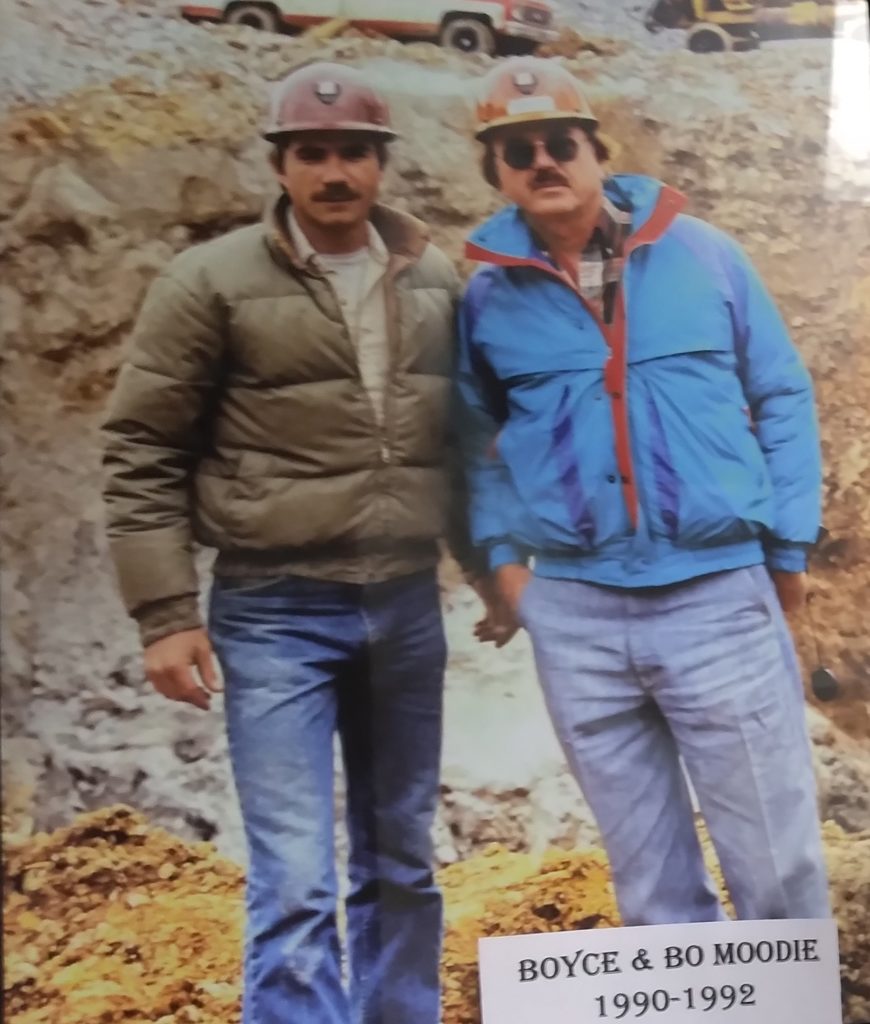
DANA KOLB
March 22,2024
By Lola Guess
If you have never seen any of Dana Kolb’s murals, it should be on your bucket list! The large murals she painted in the Courthouse Museum are amazing. She also has a mural in the entrance of the Justice Center in Smithland, Kentucky. In Providence, Kentucky, Dana was commissioned to paint an outdoor mural depicting the coal mining industry, a mural is in the Senior Citizens Center in Smithland, and various other places as well.
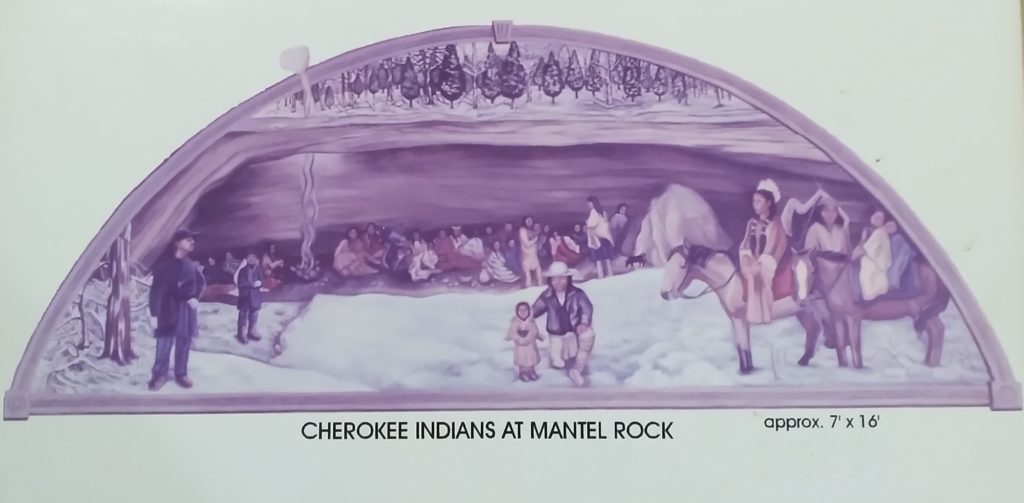
Dana has been featured in newspaper articles, magazines, art shows, and has received awards for her paintings. She not only paints – she also works in textiles, clay, mixed media, grows flowers, grows a vegetable garden, and keeps busy with other diverse talents.

The Livingston County Historical Society is privileged to have Dana’s expertise and expert abilities to create displays in the Museum. Not only are her murals a prominent piece of the Society’s collections, but she has also created mannequins or statues in the Museum that are detailed and lifelike.
Dana Kolb is a gifted artist, a devoted grandmother, and a loving family member. She lives in Tiline, Kentucky, with her husband, Freddie Kolb. Dana can be contacted on her Facebook page, through the Historical Society, or at (270) 963-0977

“Dahlias” by Dana Kolb
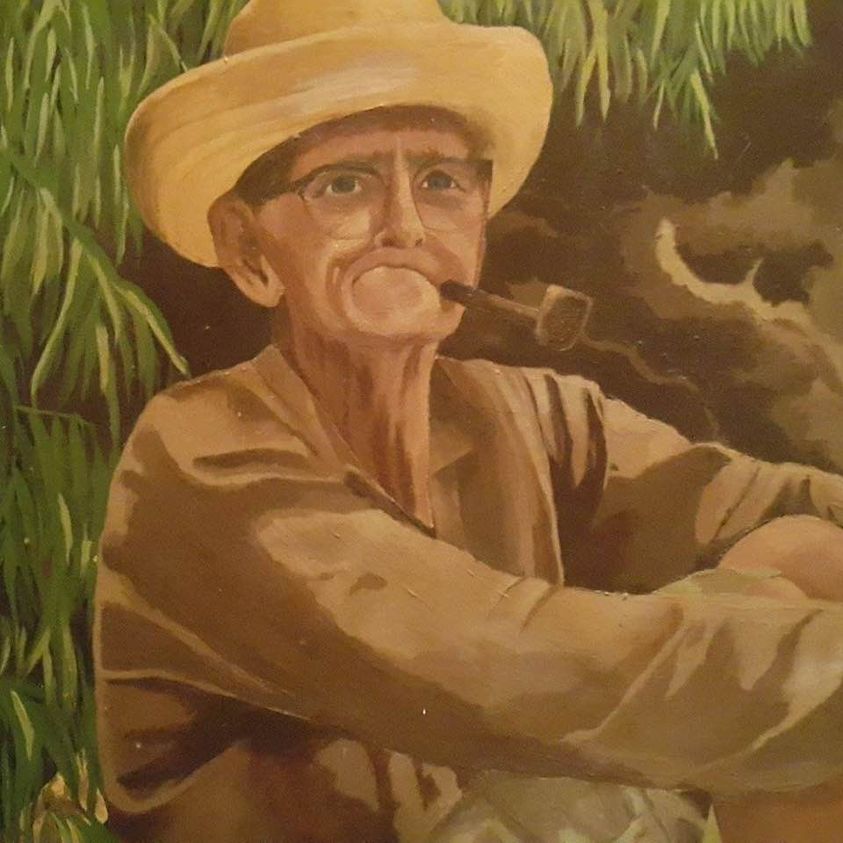
A portrait of Dana’s grandfather, “Freeman Guess”

“Gina Guess Croft” portrait by Dana Kolb
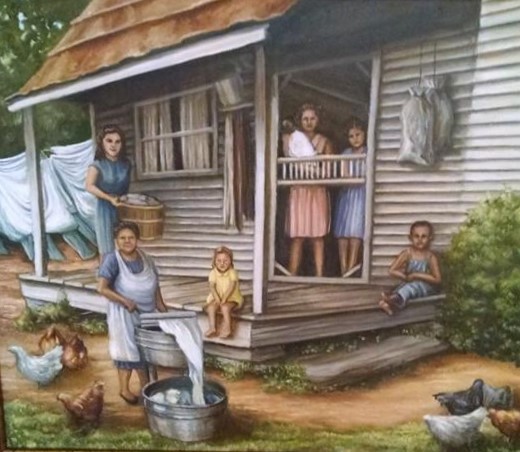
“Wash Day” by Dana Kolb


SALEM HOSPITAL AUXILIARY
March 15, 2024
By Lola Guess
On July 18, 1975, the Salem Hospital Auxiliary was launched. The non-profit organization was composed of twenty charter members from all parts of the county. These women worked in two-hour shifts volunteering their services to the hospital and patients.
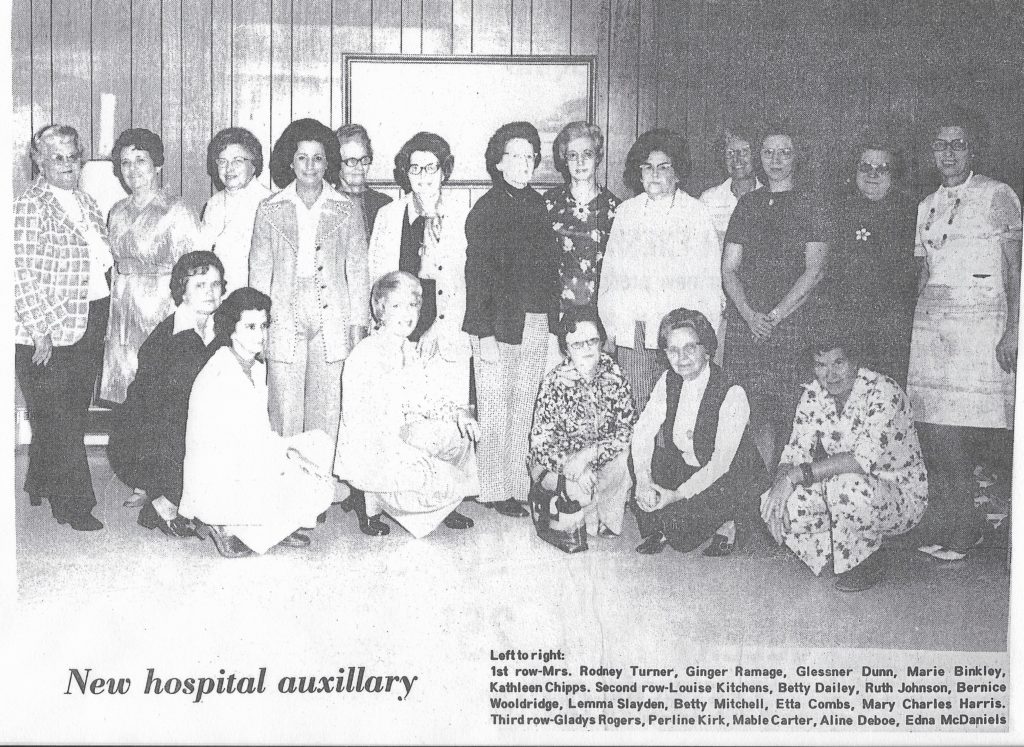
Their first step was to place a reception desk in the lobby where they directed visitors to patient’s rooms. The volunteers delivered mail, read to the patients, fed them, and performed many other useful deeds for patients as well as staff members.
The auxiliary members filled rolling gift carts with useful items such as Kleenex, toothpaste, snacks, and other “goodies” some of which were handmade by the volunteers. They rolled the carts from room to room and provided these items for sale in the lobby to visitors who had friends or relatives in the hospital. This service was provided before a permanent gift shop was established at the hospital.
Fund raising activities through the years have included the Annual Easter Egg Hunt, bake sales, Christmas Bazaars, and various other activities. The money raised goes toward a scholarship program, medical equipment, and items for patient’s rooms such as recliners, wheelchairs, and televisions.

The Womanless Wedding
March 7, 2024
By Lola Guess
A “womanless wedding” was sometimes held as a community fundraiser and involved men of the community dressed up in bridal outfits for a mock wedding ceremony. Men in gowns and dresses played the roles of everyone in a wedding party including bridesmaids, flower girls and the mother of the bride. Brides sometimes had beards or moustaches and flower girls were portrayed by grown men. Such an event was held in 1946 in Salem by the Lions Club of Livingston County.
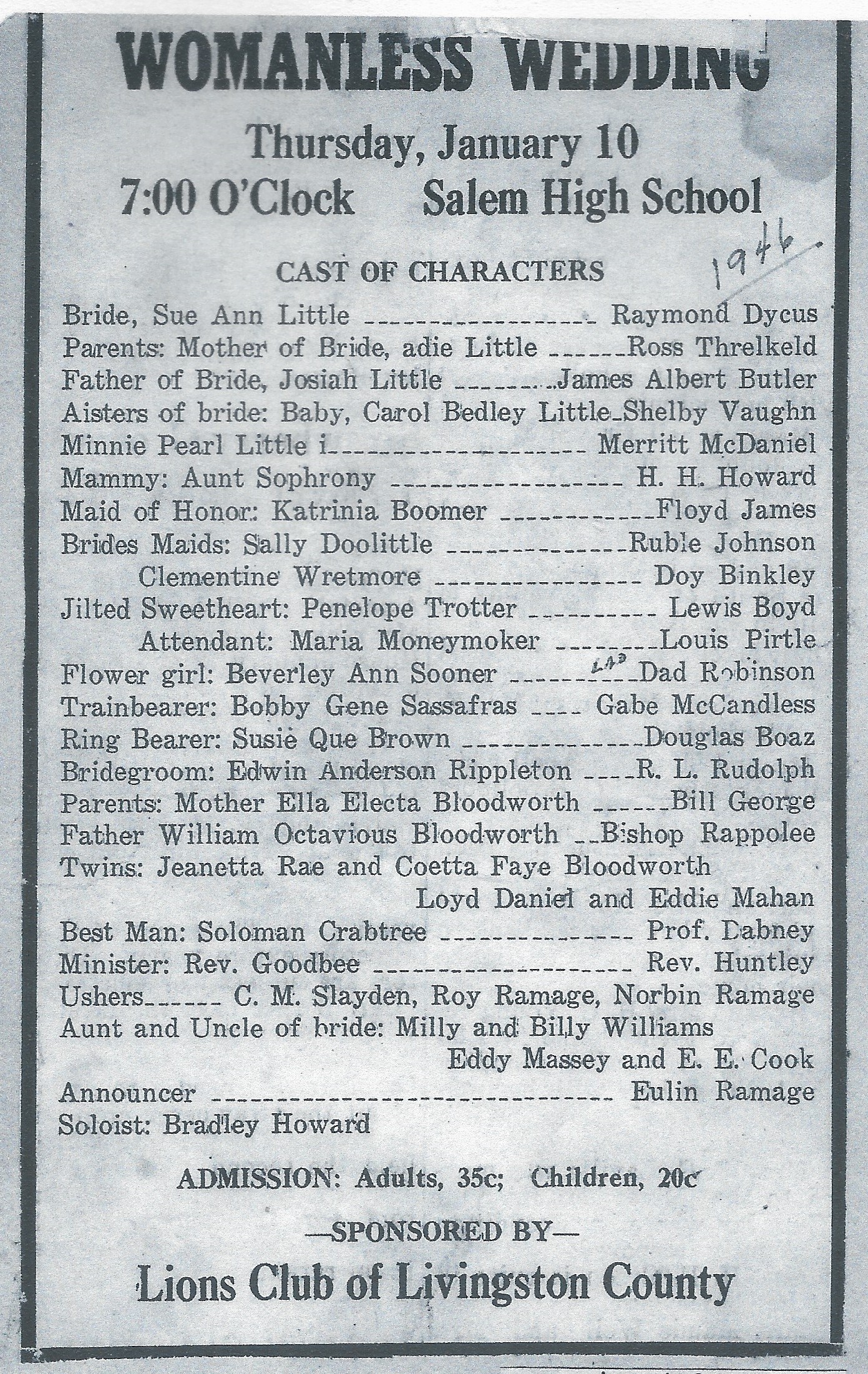
“Sue Ann Little,” bride at this event, was none other than Smithland Attorney Raymond Dycus.
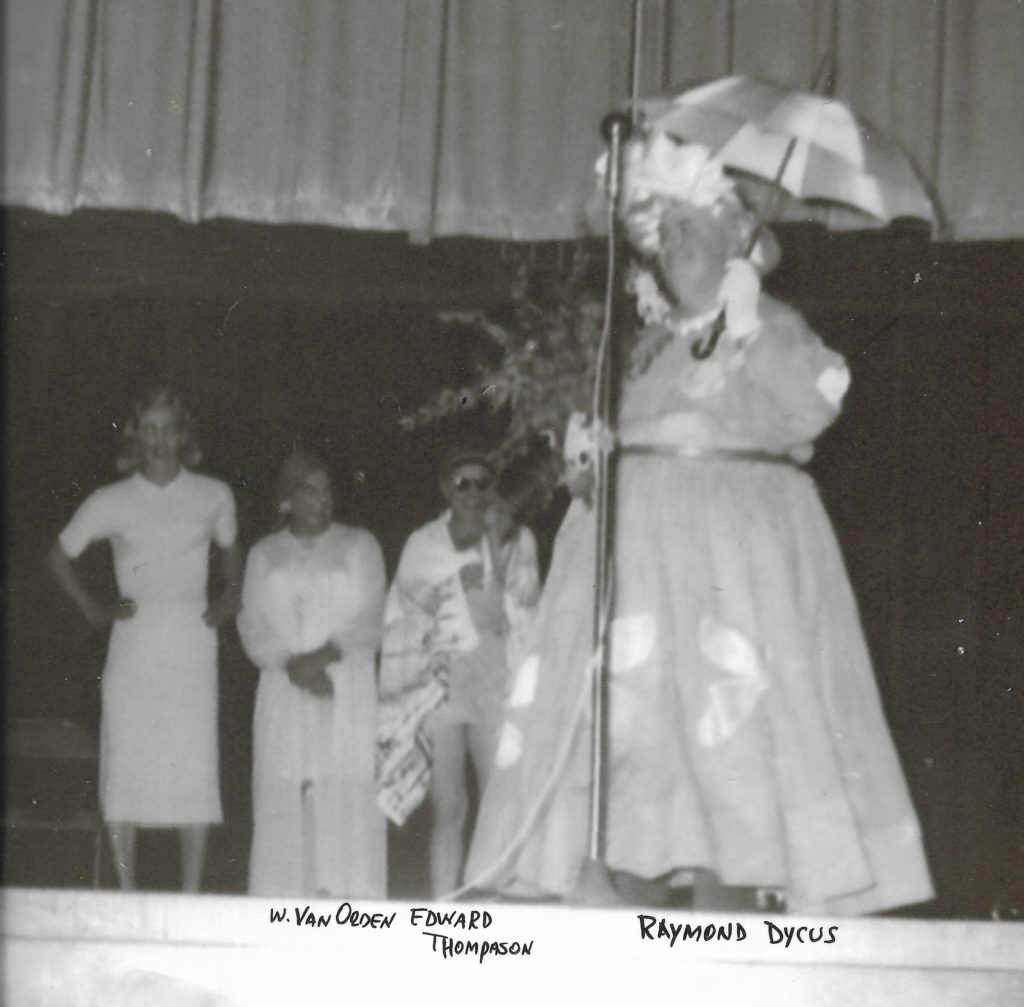
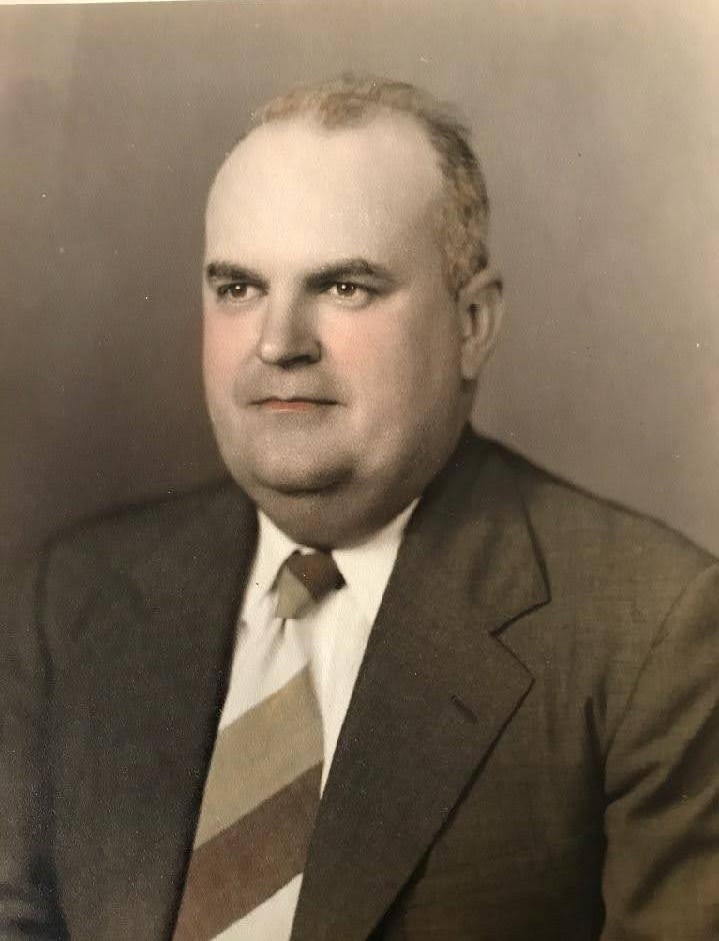
This picture of Attorney Raymond Dycus is on display at the Historical Courthouse Museum in Smithland, Ky.
Ralph Smith Judge - Sheriff
March 1, 2024
By Lola Guess – Condensed from Newspapers
Ralph L. Smith was born in Tiline, Kentucky, on March 19, 1924, to the late John K. and Clara Wolfe Smith. After he moved to Iuka when he was four years old, he told folks he began politicking. During his youth, he enjoyed riding the ferry across the river. The ferry man would give him a nickel and he would buy a soft drink.
He graduated from Livingston County High School in 1943 and began his lifelong pursuit of farming and raising cattle. Even when he lived in a nursing home, his faithful driver took him out to visit his black angus cattle and “count heads.”
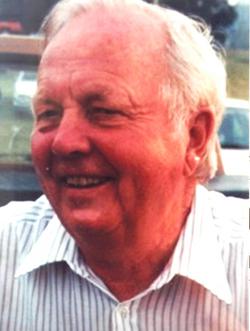
Ralph operated the Smith-Land Stables where he owned and trained many winners in harness racing in the 1980s. In 2006, he was proud to see his grandson’s filly win the Lexington Breeders’ Classic and the Kentucky Sires Stakes at the Red Mile in Lexington, Kentucky.
He rode on the 1988 Trail of Tears Wagon Train in remembrance of the Cherokee Indians who were driven from their homeland and relocated to Oklahoma. Always adventuresome, Hiram and Ann Smith and he, participated in the annual South Texas Trail Ride, a horse and wagon trail ride from Corpus Christi to San Antonio, Texas.
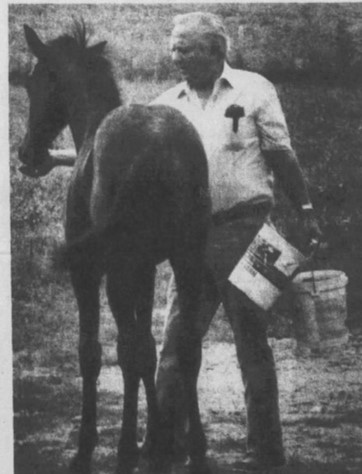
Ralph Smith was sincerely dedicated to public service and to the people of his county. At one time, he was the youngest sheriff in Kentucky, however, when he retired, he was the oldest county judge in Kentucky. Smith’s first term as sheriff was in 1954, with a salary of $400 a month and from that amount he had to hire his own deputy and use his personal vehicle. Because there was a provision in the Kentucky Constitution that prohibited succession, he would go back and forth between the office of sheriff and county judge. When the law changed regarding succession, he was elected County Judge-Executive in 1982 and held that office until he retired in 1999. For years, he held an annual barbeque with horse races on Labor Day for the people of Livingston County. He was also a charter member of the Kentucky Sheriffs’ Association.
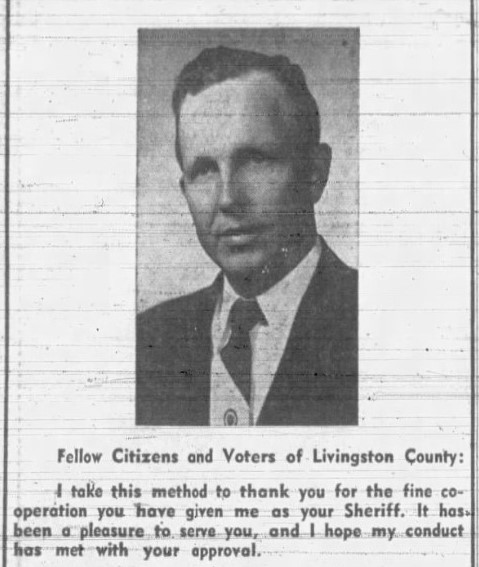
1957 - Campaign Ad
He was honored when the I-24 Cumberland River Bridge which connects Lyon and Livingston County was renamed the Ralph Smith Bridge. In all, he spent 16 years as sheriff and 25 years as the county judge-executive. During his career span of 41 years, he served under twelve governors, but what truly set him apart as a county official was his sincere love of Livingston County residents.
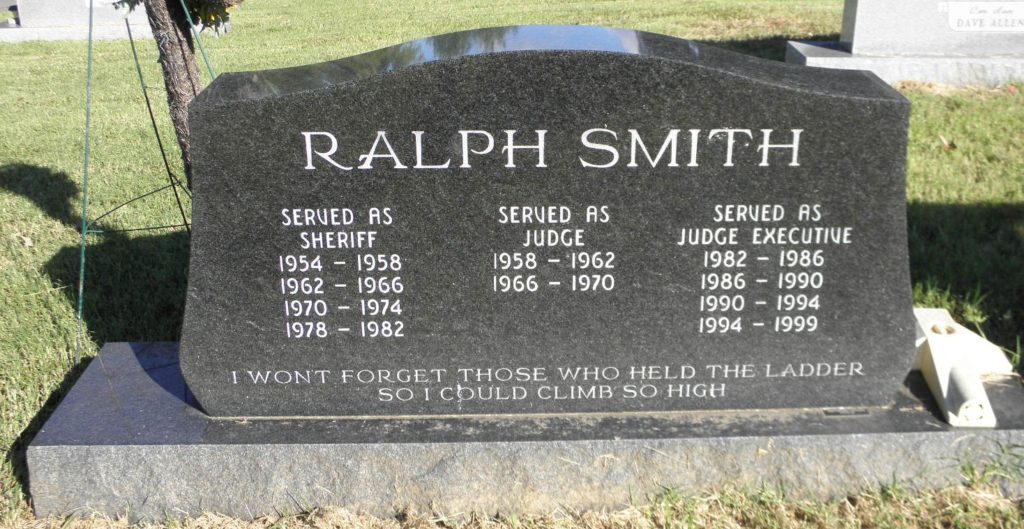
Andy & Marcy Fox - Their Historic Home
February 23, 2024
By Lola Guess
Andrew Scott Fox and his wife, Marcy Loveless Fox, live in Salem, Kentucky, in an historic home. Andy is Vice-President and co-owner of Boyd Funeral Directors. The Boyd Funeral Home was established over 104 years ago in Carrsville, Kentucky. Andrew S. Fox, son of Charles and Alberta Fox, joined the funeral home as a licensed funeral director and embalmer in 1999. Andrew graduated from the John A. Gupton School of Mortuary Science.
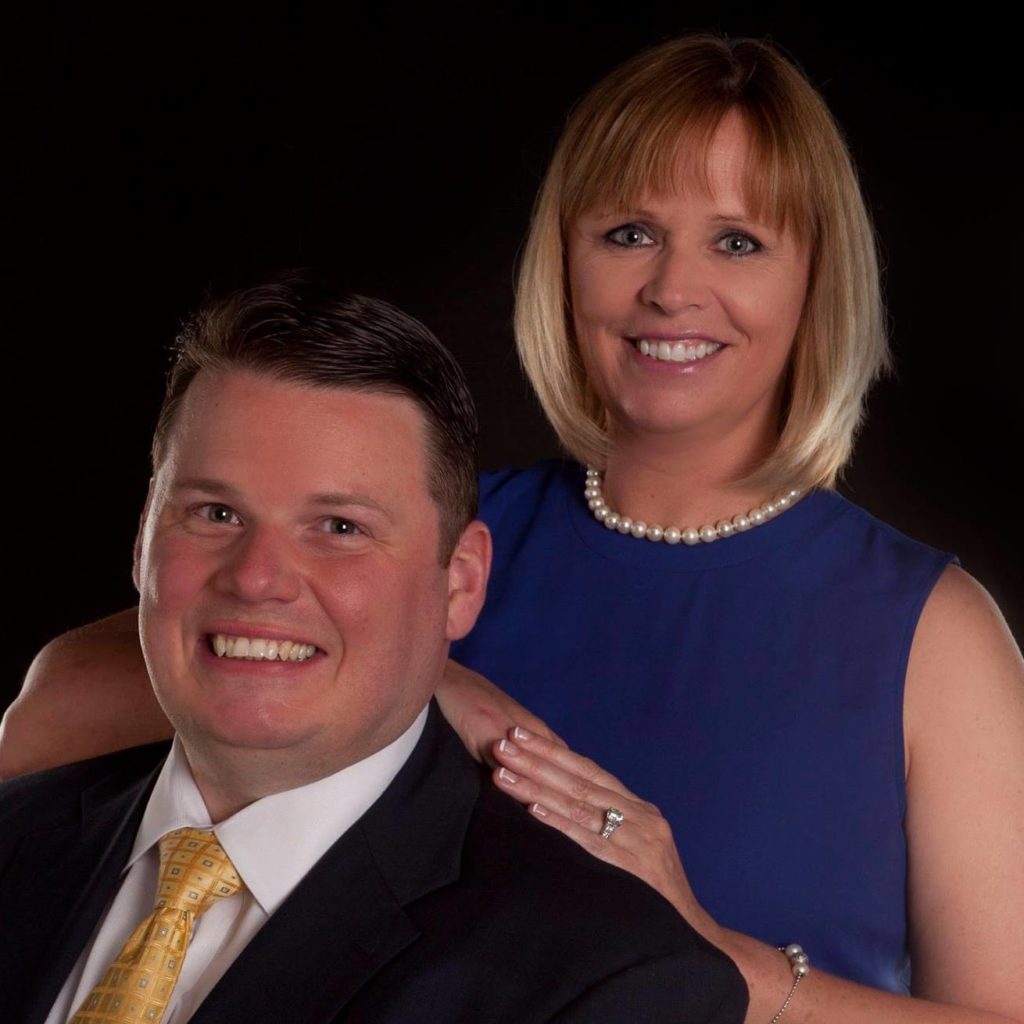

Robert and Mary Lou Hollowell also lived in this house beginning in the early 1900s. The house has had other owners through the years and has undergone more than one renovation. Mary Lou Hollowell is described as the person that ended the Night Rider era. In the early morning hours in May of 1907, a band of armed Night Riders wearing masks and on horseback surrounded Robert and Mary Lou’s house shot Mary Lou in the face with bird shot and knocked her unconscious. Robert was beaten and whipped. Their twelve-year-old son, Price Hollowell, witnessed the attack. The shooting was in retaliation because she had testified against the Night Riders who had burned the tobacco warehouses in Princeton. She went to court and eventually was awarded a settlement of $35,000.00. Other details about the Night Rider events and Mary Lou’s involvement is another story for another time.
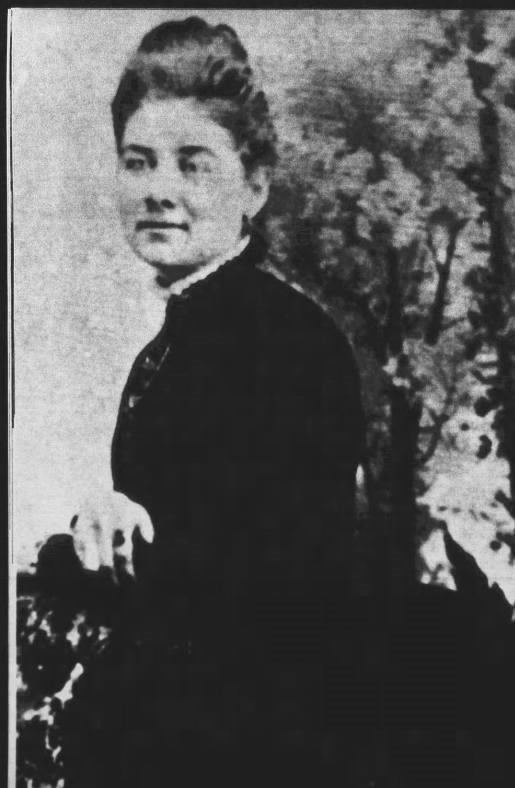
Mary Lou Hollowell

Kenneth C. Crotser
Joy, Kentucky
1932 - 2000
February 16, 2024
By Lola Guess
Frank and Virginia Crotser had two sons named Maurice and Kenneth. The family made their home in the town of Joy, Kentucky. Maurice married Rose Sledd and lived in Reidland, Kentucky. Kenneth, the younger brother by about eleven years, wanted to pursue an education.
At the age of seventeen, Kenneth became a “teacher” before he was a teacher. There was a teacher shortage at the Carrsville Grade School and Kenneth being a knowledgeable person was given the task of teaching the other students. This was in the late 1940s.
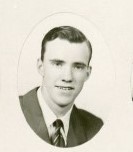
Kenneth Crotser graduated from Salem High School in1950 and from Murray State University in 1964. Governor Ed Breathitt spoke at the graduation ceremony when Kenneth received his M.A. degree.

With a degree in hand, Kenneth was soon employed by the Livingston County School System. He taught American History at Livingston Central High School for approximately twenty years and was also Assistant Principal retiring in1985.
Kenneth passed away at the age of sixty-seven on July 25, 2000, at Lourdes Hospital in Paducah and is buried in Bethel Cemetery in Joy where he spent much of his life. Kenneth Crotser was loved by the students and fellow teachers. One of his colleagues remarked that she loved to listen to Mr. Crotser in his classroom teaching history.


George Washington had Several!
February 8, 2024
By Lola Guess
We have all driven down roads and found crumbling houses from another time with a small vine covered tiny wooden dilapidated structure a few yards away in the back of the house. These are what most people called “outhouses.” And yes George Washington’s home at Mt. Vernon on the Potomac River had several. His own personal “necessary” as it was called by President Washington was a three-seater which was not the norm in rural areas. Were other dignitaries invited to accompany George? Did the President and other founding fathers hold discussions about the future of America in this three-seater?
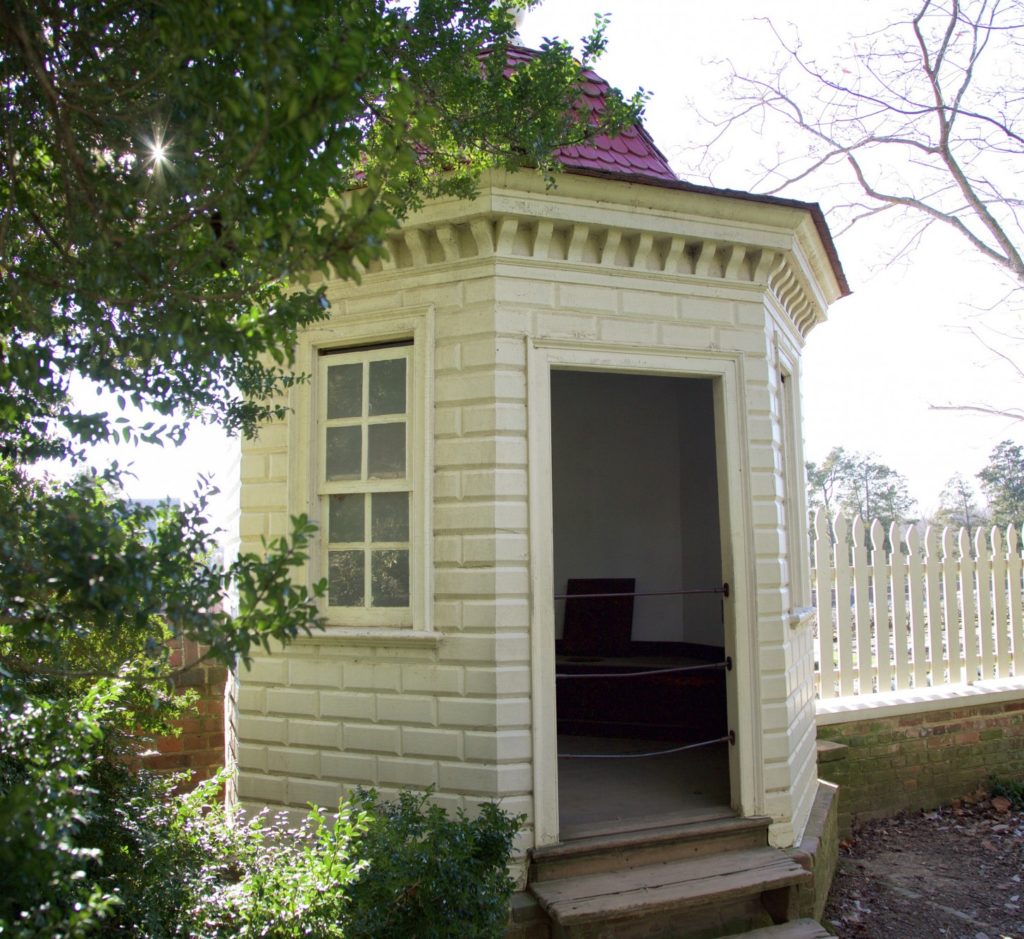
The restored “necessary” at Mt. Vernon.
George Washington’s “necessary.”
Outhouses commonly had a crescent moon or a star carved out at the top of the door. A star indicated a male outhouse and a crescent moon was for female visitors. If there was only one “privy” it usually had a moon symbol. These cutouts also allowed light to get in. If there were two seats, one might be bigger for adults and a second smaller seat would be for children.
The Sears and Roebuck catalog and corn cobs were the next important part of living with outdoor facilities. Upon receiving the Sears Catalog every year, families would pour over the pages for weeks deciding on Christmas wishes and practical needs for the household. When the catalog was outdated, it was moved to the “john” with pages ripped out as needed until it was gone. A sack of corn cobs was used for the same purpose as well as leaves, but the user better be sure there were no poison ivy leaves. Don’t forget the problem of wasps in the summer and the bitter cold in the wintertime.
Outhouses are actually illegal now in Kentucky as well as other states. Some still exist of course. The sport of outhouse racing became popular in Gravel Switch, Kentucky, in 1993. Participants in the races built replicas of outhouses, set them on wheels and raced through the streets trying to win the trophy. There was the “sport” of tipping over outhouses which usually occurred on Halloween night by groups of teenagers. Their favorite target seemed to be the “schoolhouse outhouse” which is also a famous phrase in the hit song “Nutbush” by the late rock star Tina Turner. Last but not least was the fun practical joke of locking the door from the outside when the outhouse was occupied.
There are outhouses still in use today. In these modern times, we have upgraded to the term “porta potties.” Thankfully, the difference now is they are moved away when full or when the event is over.
Hazel Demery
February 2, 2024
By Lola Guess
Not many people can say they stayed in the same job for fifty-eight years. That is exactly what Hazel Demery did. Hazel began working for Reed Crushed Stone as a nurse in 1951 and continued until her retirement in 2009 at the age of eighty-five. She began her nursing career at the Old Blytheville City Hospital School of Nursing in Blytheville, Arkansas, where her parents lived at the time. Hazel graduated in 1941 and worked as a nurse in Arkansas, Tennessee, and other towns in Kentucky until finally accepting the position as the industrial nurse for Reed Crushed Stone when she and her husband, James, moved to this area. When the quarry was sold to Vulcan Materials in 1990, she continued in the same position.
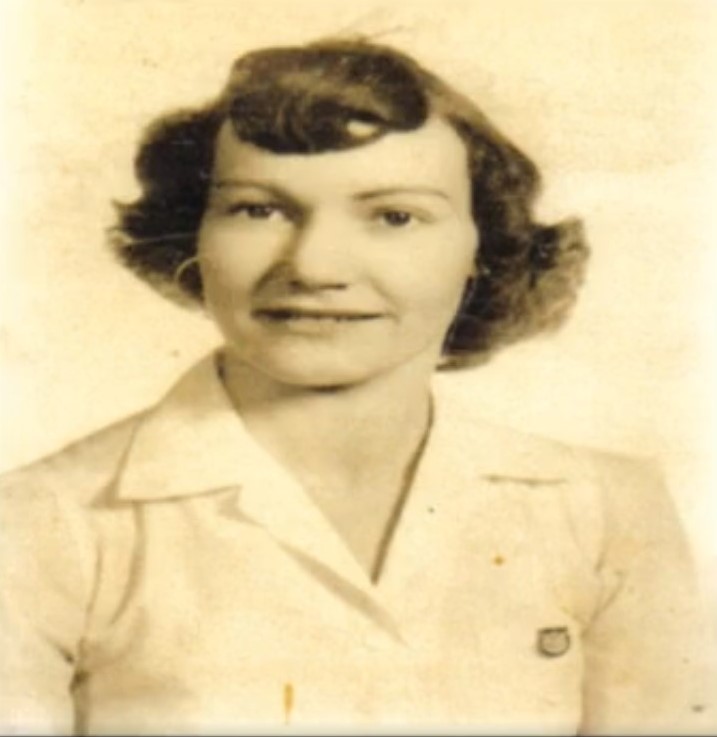
For over sixty years, Hazel Demery was the Red Cross Bloodmobile Chairman for Livingston County. She spearheaded too many blood drives to count. She was there to set up the Red Cross locations and worked tirelessly to ensure the success of these events.
Hazel was the recipient of numerous awards. She received awards and recognition from various political organizations for her work in Livingston County as well as on the national level. She was a Kentucky Colonel, a Kentucky Admiral, and a Duchess of Paducah. She served on the Pennyrile Area Development District Board of Directors for twenty years. Mrs. Demery received the Distinguished Service Citation from the Office of Kentucky Attorney General. Also add to this list the fact that she was a Deputy Sheriff in Livingston County during her career.
Another honor bestowed on Hazel by the city of Grand Rivers occurred when a street in Grand Rivers was named “Hazel Demery Boulevard.” She was chosen as the 1982 Grand Marshall of the Grand Rivers Hunter’s Moon Festival. Hazel held the honor of christening a boat bearing her name. In 2012, Vulcan Materials purchased a tugboat naming it the “Hazel Demery.”
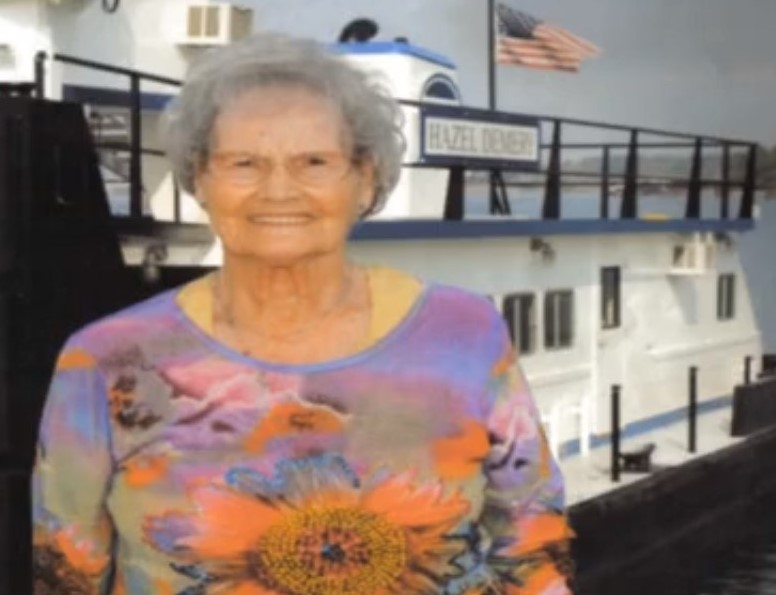
Being active in political events led Mrs. Demery to the national conventions. She was a delegate at the 1996 Democratic Convention at the United Center in Chicago, Illinois, and the 2000 Convention at the Staples Center in Los Angeles, California. The Los Angeles Times featured this picture of Hazel in August of 2000.
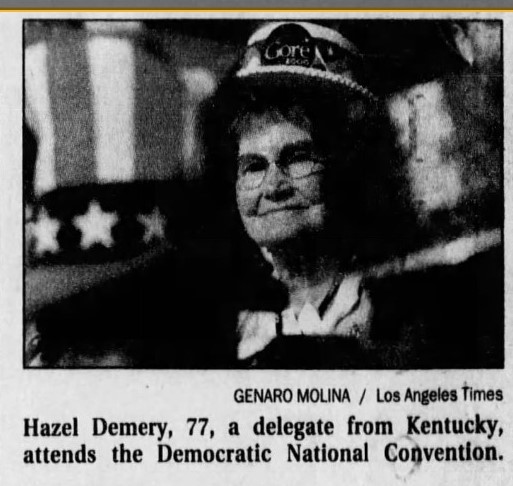
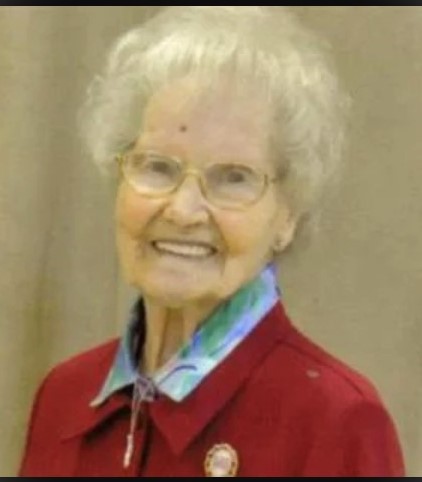
Mark Trail - Artist

January 26, 2024
By Lola Guess
Mark Trail is a loving son, photographer, artist, painter, animal lover, researcher, designer, and diligent worker. There are many sides to Mark and he excels in all of them. The first picture is an example of his awe-inspiring photography skills. He has hundreds of photos that he has taken of historic sites, nature scenes, and events that come to his attention. Could Mark have captured a scene on the right that was experienced by the Cherokee in the winter of 1838-1839 when they were stranded at Mantle Rock on the Trail of Tears?


Mark restores vintage bicycles, license plates, and rescues other historical objects such as clocks with precise workmanship. He rides miles and miles around the county (taking pictures as he goes) and sells these antique bikes to collectors. He does meticulous work as you can see.

The multi-talented Mark paints beautiful scenery and buildings. Along with acrylics, he also creates pencil drawings in black and white.


If that isn’t enough, he constructs amazing miniatures of historic buildings. His miniatures are accurate and detailed. Mark has also built a steamboat replica. The Museum is enormously proud to have a collection of these recreations on display for the public to enjoy.
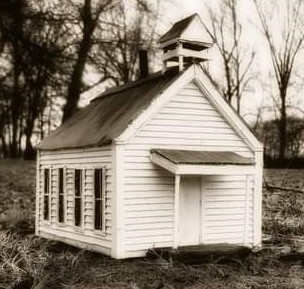

Mark is an avid researcher. He has a wealth of historic information stored in his files. Mention a subject and Mark can show you a picture and is willing to share the facts he has uncovered. He is always there at the Historical Society if work needs to be done. He has moved boxes, created displays, painted, arranged collections, ran errands, and helped on countless other projects. Because he is knowledgeable in the history of Livingston County and with his creative imagination and talent, Mark is a valuable and generous member of the Historical Society. His artistic abilities were showcased in a Crittenden Press newspaper article dated March of 2023.
Mark Trail was born on December 28, 1990. His parents are David and Wanda Trail. The family resides in Ledbetter, Kentucky. Another hobby Mark takes pleasure in is a family of Guinea pigs he keeps. Three of them are named Mr. Reesie, Chief, and Queen Rosie. If you see Mark Trail around Livingston County or somewhere on a bicycle, you can be assured he is doing something productive with his day.


Orville & Elsie Cox
January 19, 2024
By Lola Guess
There was a jail in Livingston County in Smithland for 159 years. Records show that the first jail was built in 1846. In 1892, the jail pictured below was built with the outer shell added in 1950. In this picture, Jailer James Allen Martin is shown on the right and an unidentified person on the left. The picture is believed to have been taken in 1931. Jailer Martin and his son are shown in the picture on the right.
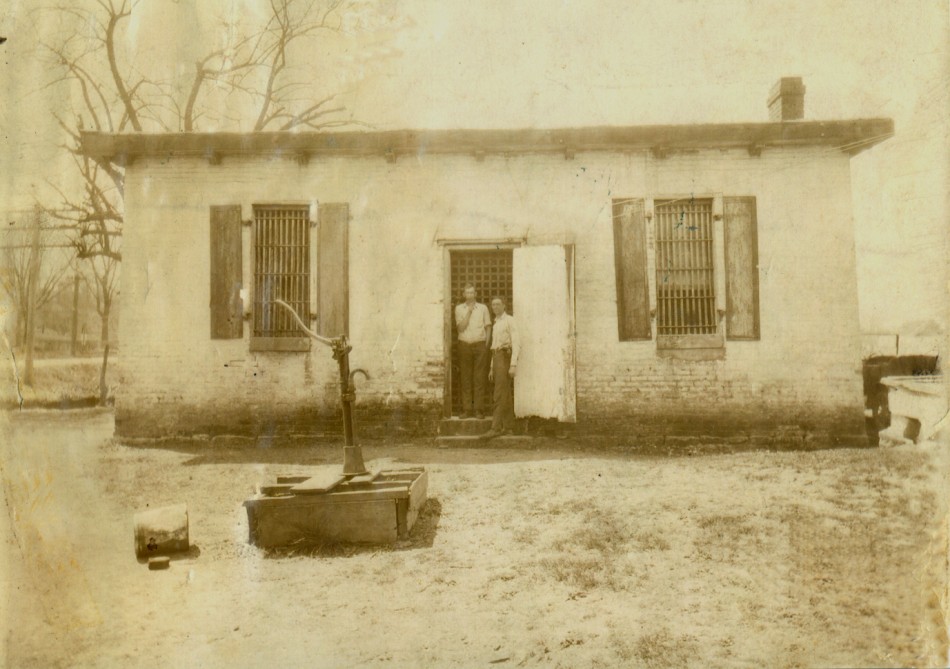
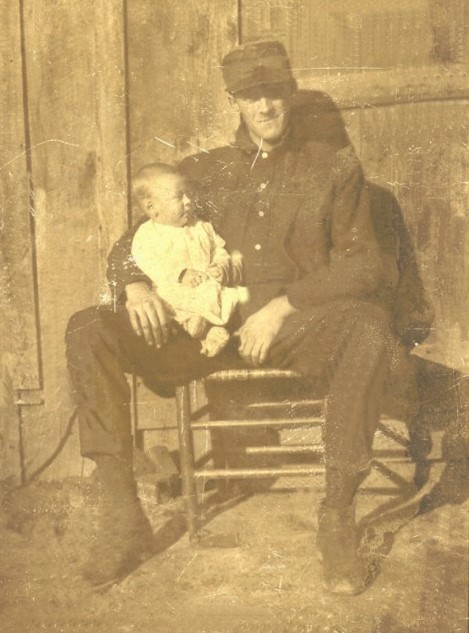
This is a list of jailers posted on the Livingston County Jail website:
Benjamin Guill • 2003 – Present
Lannie Hall • 1982 – 2002
Orville Cox • 1966 – 1981
Spurlin Taylor • 1958 – 1965
G.W. Hosick • 1950 – 1957
W.J. Woodyard • 1946 – 1949
Eugene Myrick • 1942 – 1945
C.B. Scarborough • 1938 – 1941
Jim Martin • 1930 – 1933
C.N. Stringer • 1926 – 1929
J.S. Bennett • 1922 – 1925
Felix B. McGrew • 1914 – 1921
Fred Hardy • 1910 – 1913
L.T Worten • 1906 – 1909
There is no information shown before 1906. From 1910 to 1914, from 1922 to 1926,and
from 1933 to 1938, there are three gaps where no jailer is listed.
Jailer Orville Cox was elected to four terms. He and his wife, Elsie, took care of 4,902 prisoners. Elsie prepared approximately 15,500 meals and raised a garden to provide food for the incarcerated. Two escapes were made during his term in office and in one the prisoner knocked Orville to the ground and he came up shooting.
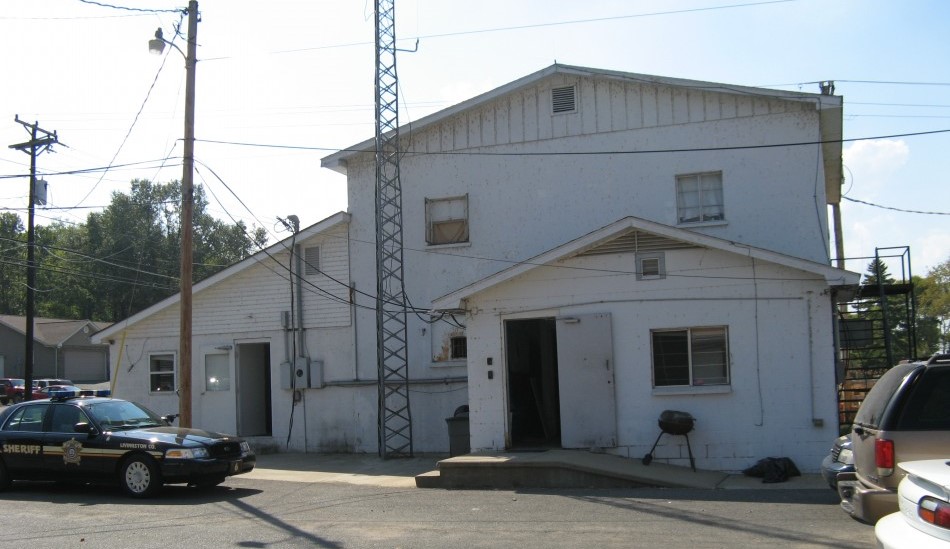
Livingston County Jail – Smithland, Kentucky
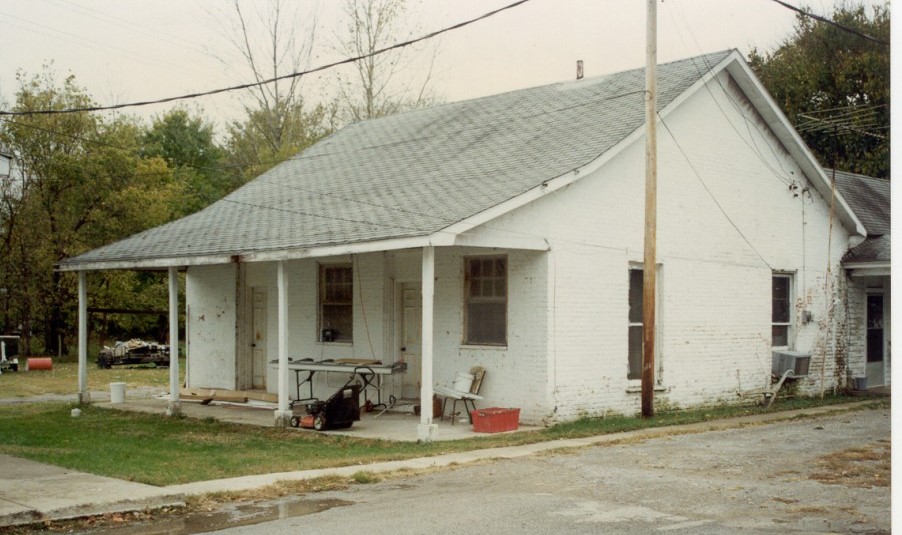
Jailer’s House – Smithland, Kentucky
Despite only having one arm, Orville was considered to be a capable as well as a fair jailer. He lost his left arm in an accident in the spar mines before being elected. The Cox family also provided meals and a place to stay in the jail for people who didn’t have a place to go. Eventually, the state stopped allowing persons who were not prisoners to stay overnight.
Sadly in 1983, the State declared the jail “too small and too old and unfit for human habitation.” County Court Clerk Gabe McCandless stated that “We’ve had a right good jail for a county of this size, in my opinion. We can’t put prisoners up like they were in the Holiday Inn.”
The jail was finally closed on May 16, 2005. Jailer Benji Guill began transporting inmates to other facilities and is responsible for bringing them back and forth to court dates.
Orville and Elsie were married in 1930 in Marion, Kentucky. They had four daughters named Louise, Hazel, Kaye, and Faye. Orville Paul Cox died at the age of 77 (1909-1986). Elsie Wright Cox was 87 at the time of her death (1913-2000). Both are buried in Tyner’s Chapel Cemetery in Crittenden County, Kentucky.
The Historical Society has two of the barred doors from the old jail. They will be on display in the Courthouse Museum.
Bid Southern
January 12, 2024
By Lola Guess
The family farm near Scotts Chapel on the Cumberland River has been in the Southern family for generations. Bid Southern was born on December 26, 1896. He married Edna Mae Cowan in September of 1917. By the age of 21, Bid had never been to Tiline which was only nine miles from the farm. After only eleven months of marriage, the quiet life in Scotts Chapel was interrupted by World War I. Four months shy of his 22nd birthday, Bid was drafted into the Army in August of 1918. He had eighty cents in his pocket when he traveled to Paducah, boarded a train, and was sent to West Point, Kentucky, for training.
This was the beginning of the four months that Bid Southern remained in the Army. After two months of training, Southern was admitted to the hospital with influenza. The 1918 influenza pandemic took the lives of many enlisted in the armed services. Bid was transferred to Camp Knox where he contracted measles. Eight days later he was sent to Camp Taylor Hospital with pneumonia. His condition did not improve and finally was put in a ward reserved for the dying.
Bid Southern was not dead of course, but the hospital help decided that he was deceased since he was unable to speak or move. The hospital moved him to the morgue and attached a card to his toe stating where to ship the body. Bid stayed there waiting for shipment. The hospital was overwhelmed by the number of influenza patients and was unable to properly care for the soldiers.
Fate intervened and Bid was saved from being buried alive by an alert attendant who noticed Bid’s eyelid flickering. The attendant immediately called a doctor, and Bid was soon back in the hospital ward. Recovery was slow and by the end of four months, Southern returned to Livingston County. His 80 cents had grown to $128.00. He had earned $18 by washing clothes for other soldiers, had saved $30 from his Army pay, and Mae had saved $80 of the money the Army had sent to her.
Bid lived a long and productive life in the Scotts Chapel Community. He passed away in 1988 at the age of 91. Mae died in 1993 at the age of 93. They are buried in Scotts Chapel Cemetery.
Hershel Southern was born in 1928 and married Patricia Vick. They had two children, Charlotte, and Charles Lynn. Herschel passed away in 2018 at the age of 90. Charlotte married Thomas E. Barnett and Charles married Dawn Crass.
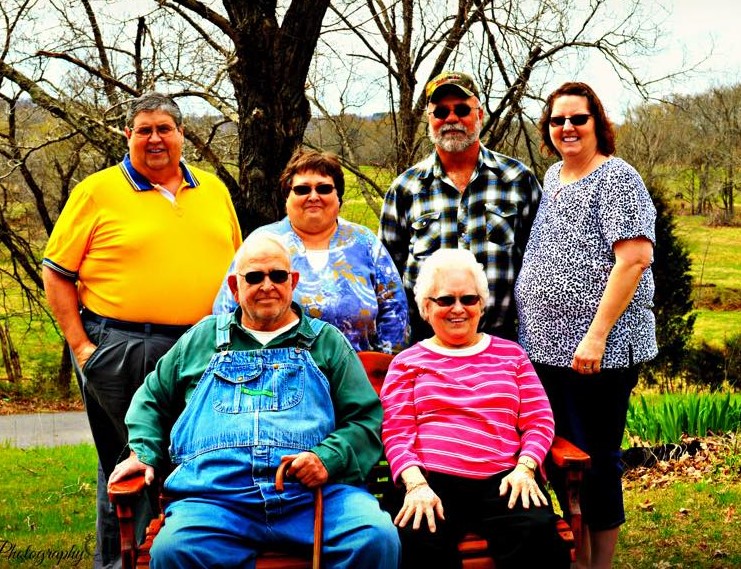
Front: Herschel & Patricia Southern
Back: Thomas & Charlotte Barnett, Charles Lynn & Dawn Southern
Charles and Dawn have two children, Kayla (Derek) Curnel, and Klay (Emily) Southern. The Southern family has continued to live on the farm until this day. Patricia Southern is 90 years old. Along with running the farm, Klay was elected Livingston County Magistrate in 2018 for the Fourth District and is currently serving his second term.
The Southern family has been generous in donating historical artifacts to the History Society. In 2023, Thomas Barnett published a book entitled “Smiles & Tears from Bizzell Bluff.”
The Next Generation
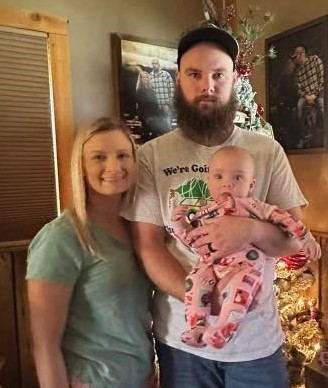
Klay, Emily & Kallie Southern
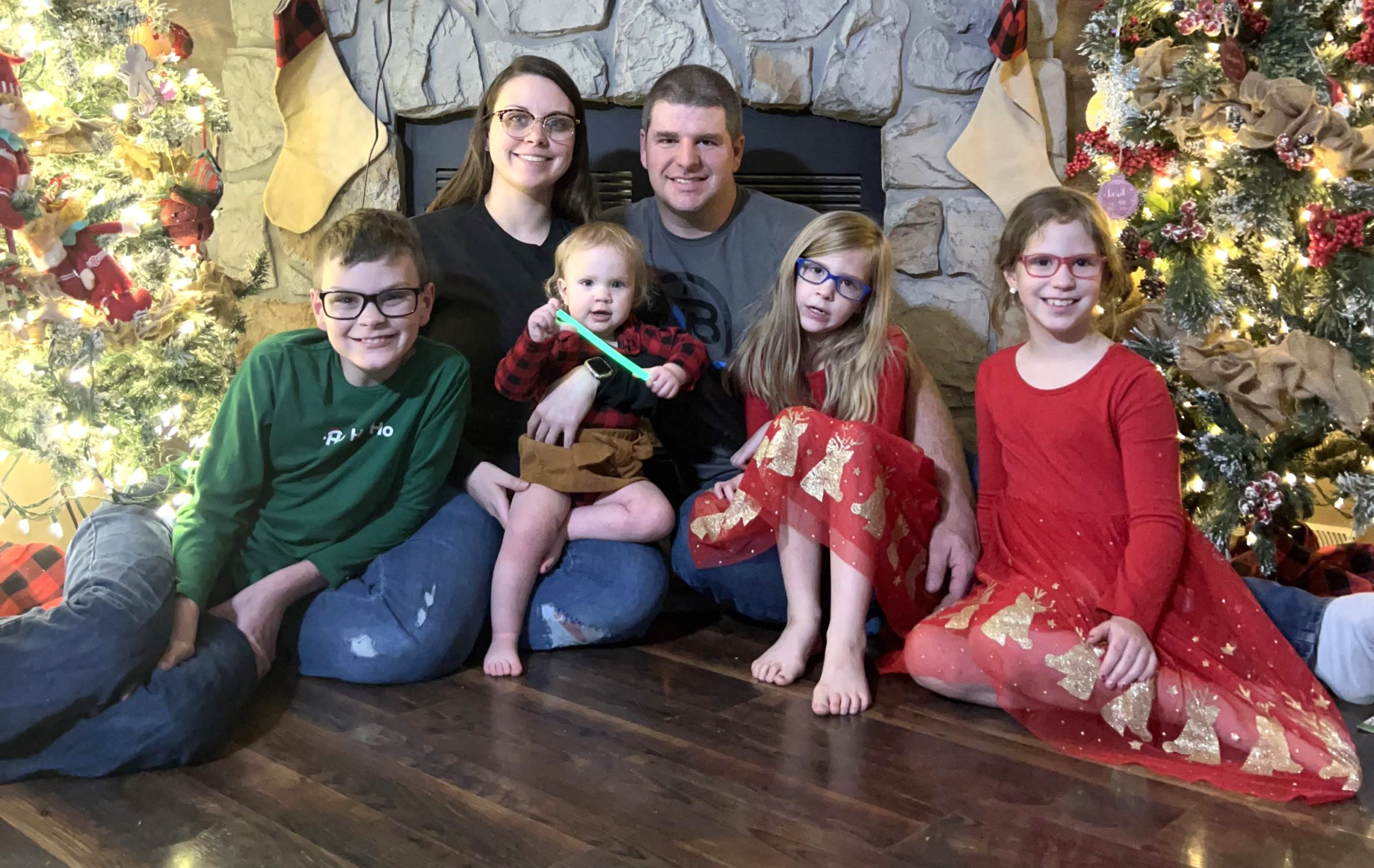
Front: Bryan, Brixlee, Bryza & Brylee
Back: Kayla & Derek Curnel
The 1959 State Basketball Team
January 5, 2024
By Lola Guess
The following is a picture of the 1959 Kentucky State Second Region Championship Team. This is the only team that has played in the Sweet Sixteen at the Kentucky State Basketball Tournament. The team was led by #44 Don Ringstaff who graduated in 1959, had 1,838 career points, and went on to coach the Livingston Central Cardinals from 1966 until 1986.
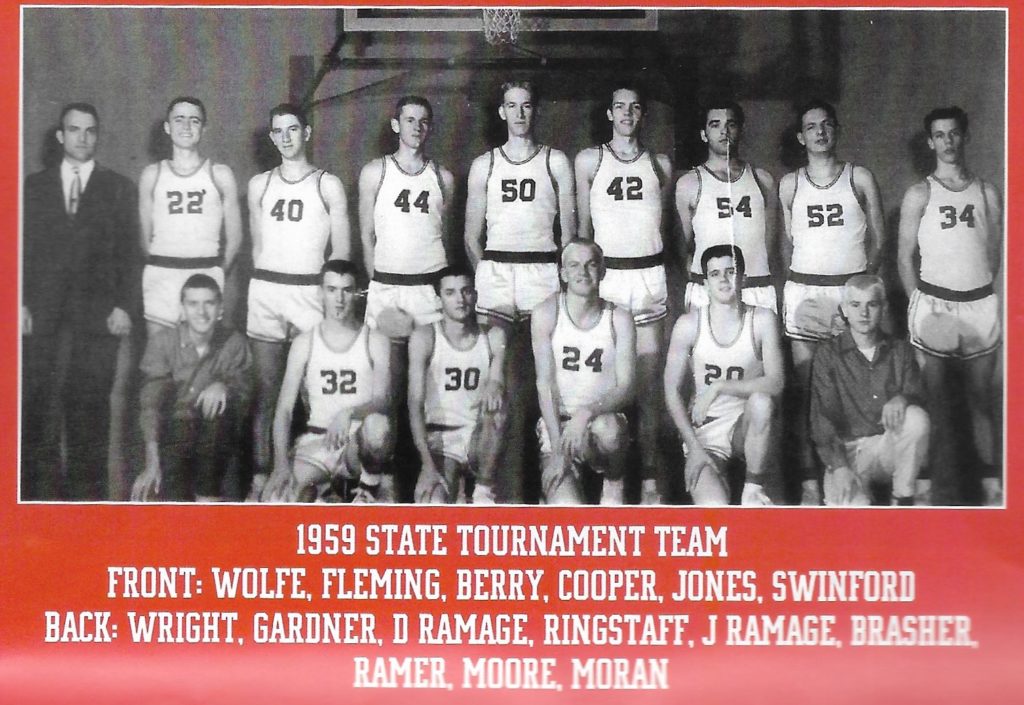
This is how the Cardinals got to the state tournament.
Livingston Central began the road to the state tournament by beating Crittenden County in the first game of the Fifth District Championship. In the second game against Lyon County, C.C. Brasher led the scoring with 26 points followed by Don Ringstaff with 17. On March 7, 1959, the third and final game of the district tournament, Livingston beat Trigg County by 5 points.
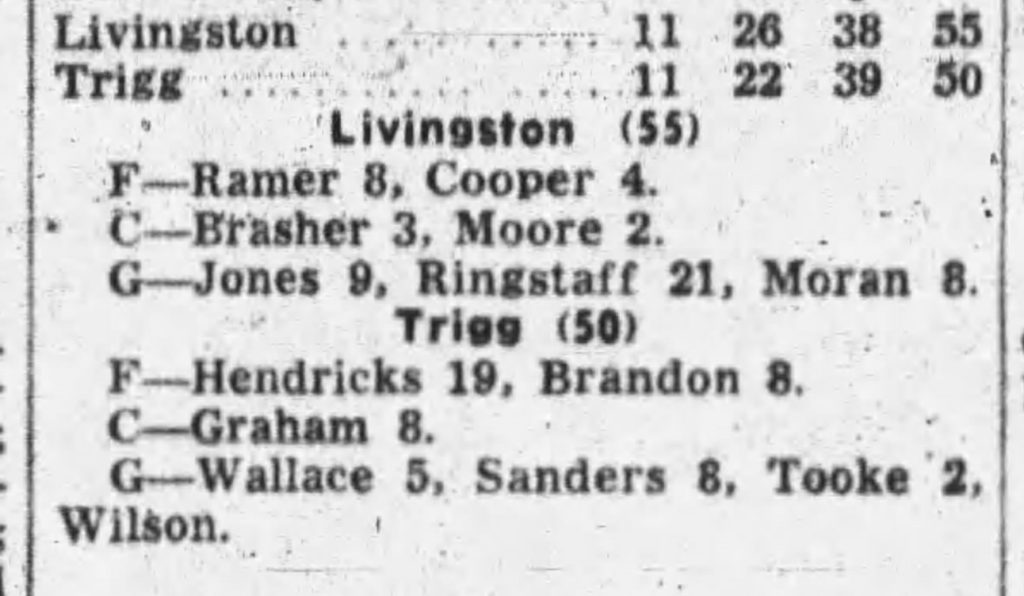
The Regional Championship began on March 12th with Livingston winning against Todd County by a score of 70 to 61. In the second game, Don Ringstaff led the scoring again with a win over Dawson Springs by only one point. And finally, the Cardinals beat Crofton by four points to earn the Regional Championship trophy.
The State Tournament- Thursday, March 18th, 1959, at 10:45 a.m. – Memorial Coliseum, Lexington, Kentucky Livingston Central Versus Olive Hill
The newly consolidated school’s team was considered a dark horse and was not given much of a chance against the 16th region’s powerful team from Olive Hill. The Redbirds arrived in Lexington late Wednesday night after a practice in Elizabethtown. The players stayed at the Phoenix Hotel in Lexington (the hotel closed in 1977). Coach Frank Wright had led the team to a season 22-12 record. “Wright indicated he would go down the line with his usual starting lineup. Versatile Don Ringstaff will get the nod at a guard position along with hustling Lee Jones. Big Charley Brasher will open in the pivot slot with Pat Cooper and Ed Ramer getting the call at the forwards,” as quoted in the Paducah Sun.
The Olive Hill Comets were described as tough and a top-bracket favorite. They had a 34-2 record for the season. Livingston stayed in the game for the first three quarters and then in the last half of the fourth quarter, the team was described as finally running out of gas. “Ringstaff turned in a crowd-pleasing performance that should have earned the 6-2 blond all-tournament honors…Little Freddie Moran, who had a big hand in getting the Cardinals to the big show, turned in a standout game as a substitute. The game is probably the swansong for Coach Frank Wright. The personable Wright turned in his resignation before the district tournament opened.” (The Paducah Sun, March 19th, 1959.) In the end, Livington Central lost to Olive Hill by a score of 88-78. Although no other Cardinal team has made it to the Sweet Sixteen, we are proud of all the Livingston Central sports teams and support them to the fullest.


Christmas in the Courtyard
Smithland, Kentucky - December 3, 2023
December 9, 2023
By Roger McGrew
The Preacher & the Song Leader
December 1, 2023
Author Unknown
There was a church where the preacher and the song leader were not getting along. As time went by, this began to spill over into the worship service. The first week the preacher preached on commitment and how we all should dedicate ourselves to the service of God. The song leader led the song “I Shall Not be Moved.” The second week the preacher preached on tithing and how we all should gladly give to the work of the Lord. The song leader lead the song “Jesus Paid it All.” The third week the preacher preached on gossiping and how we should all watch our tongues. The song leader led the song “I Love to Tell the Story.” With all this going on, the preacher became very disgusted over the situation and the following Sunday told the congregation that he was considering resigning. The song leader lead the song “Oh Why Not Tonight?” As it came to pass, the preacher did indeed resign. The next week he informed the church that it was Jesus who led him there and it was Jesus who was taking him away. The song leader lead the song “What a Friend We Have in Jesus.”
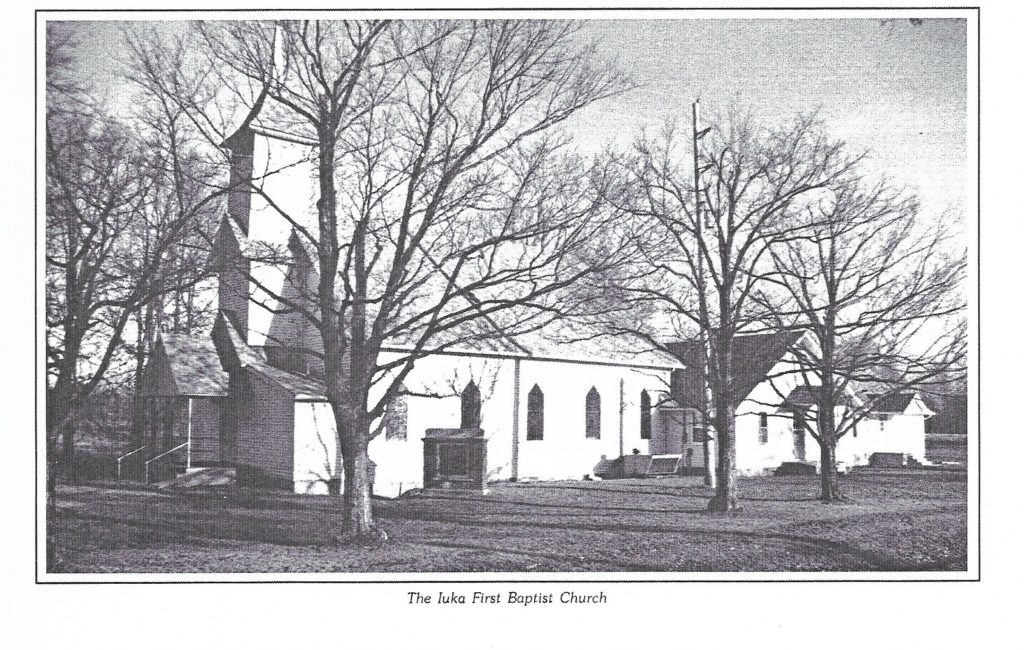
This church has nothing to do with the story. I just like the picture!
Muriel Dickerson - Interview
November 22, 2023
Every Piece of Land Has a Story
Medicinal Water Discovered Near Birdsville
November 17, 2023
By Lola Guess
In the year 1914, rain was hard to come by in Livingston County. Wells dried up, ponds and creeks ran dry. Such was the case on the farm of Mr. Edward V. Calvert which was two miles east of Birdsville and a mile and a half back from the Ohio River. Mr. Calvert was born in1858. His parents were N. B. Calvert and Sarah Reynolds Calvert. Edward and his wife Rosie were listed in Dyer Hill District 4 of the 1910 census. Ed’s occupation was listed as being a farmer.
Because of the drought in this area, Ed and Rosie Calvert needed to find a new source of water for their family and the livestock. Ed thought about the two springs only about seventy-five yards from his house that still had running water, but he needed a bigger flow. He placed dynamite in the larger spring and blew a hole that soon filled with water.
Mr. Calvert began using the water from the spring and soon began to notice that it had a laxative effect. When horses and cattle went to drink, they would turn away and only sip it. Ed had been told that the water no doubt had medicinal properties. Dr. Barney Markey told him to have the water tested. Ed sent a sample to the Kentucky Agricultural Experiment Station. The report listed the mineral contents and stated that it “was magnesium water and doubtless had laxative properties.”
Ed was elated. He felt the water was good for kidney and liver troubles because he had already benefited from drinking the water. He stated that others in his neighborhood had benefited as well. It was believed at the time that mineral water was good for torpid liver, biliousness, a purgative, sick headache, rheumatism, indigestion, and other ailments. The news spread and on one particular day there were fifty or more visitors at Mr. Calvert’s farm. Ed sold the water in jars and talked about blasting the spring again, building a hotel there, and opening a resort for the benefit of the county, state and elsewhere. The spring on the Calvert farm was said to be in a valley with high hills on both sides. The water ran over rocks and was clear.
I could not find any other articles about the spring other than the one dated August of 1914. Mr. Calvert died at the age of ninety-one and is buried in the Jameson Cemetery-1 in Burna, Kentucky.
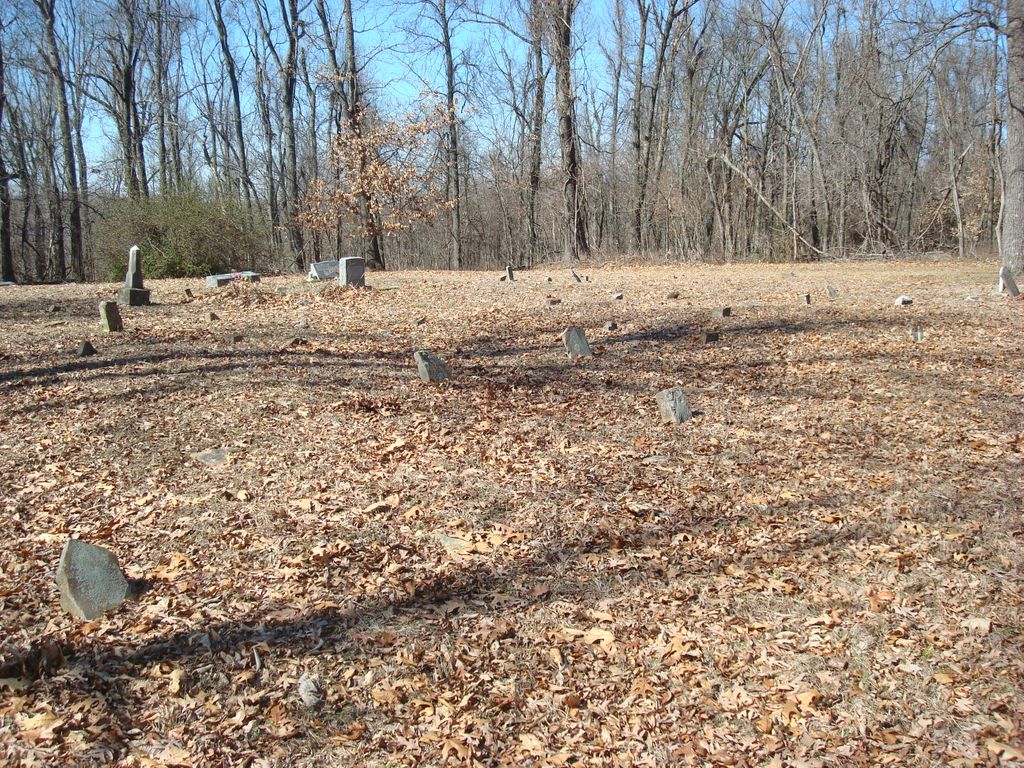
Dickie & Connie Berry
“Memories of Growing Up in Smithland, Kentucky”
By Dickie Berry
November 10, 2023
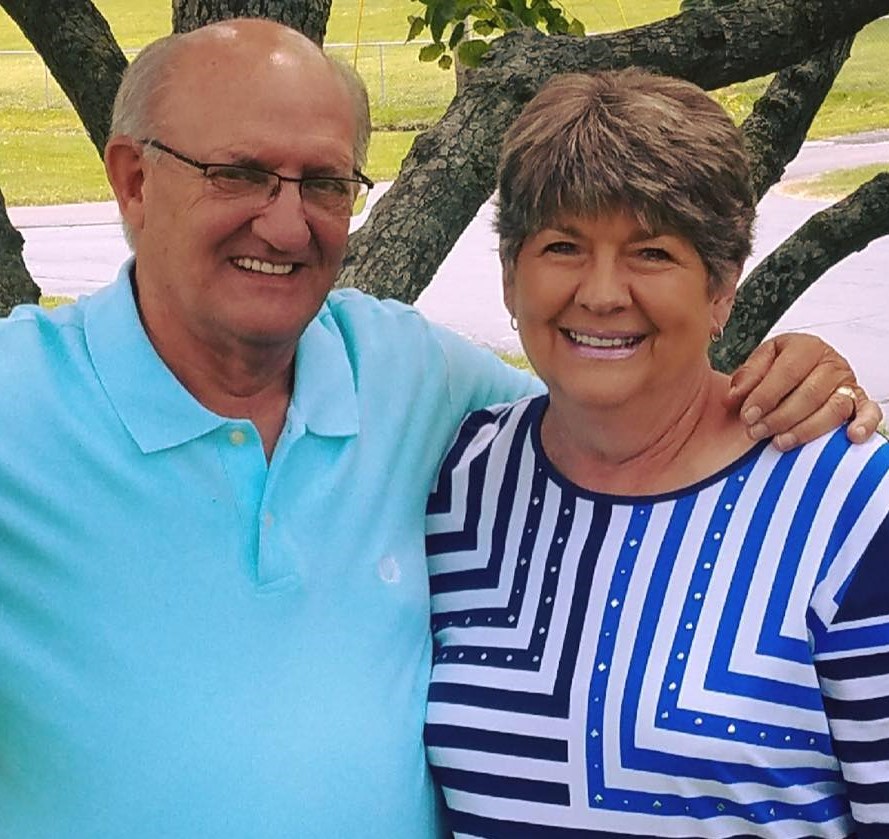
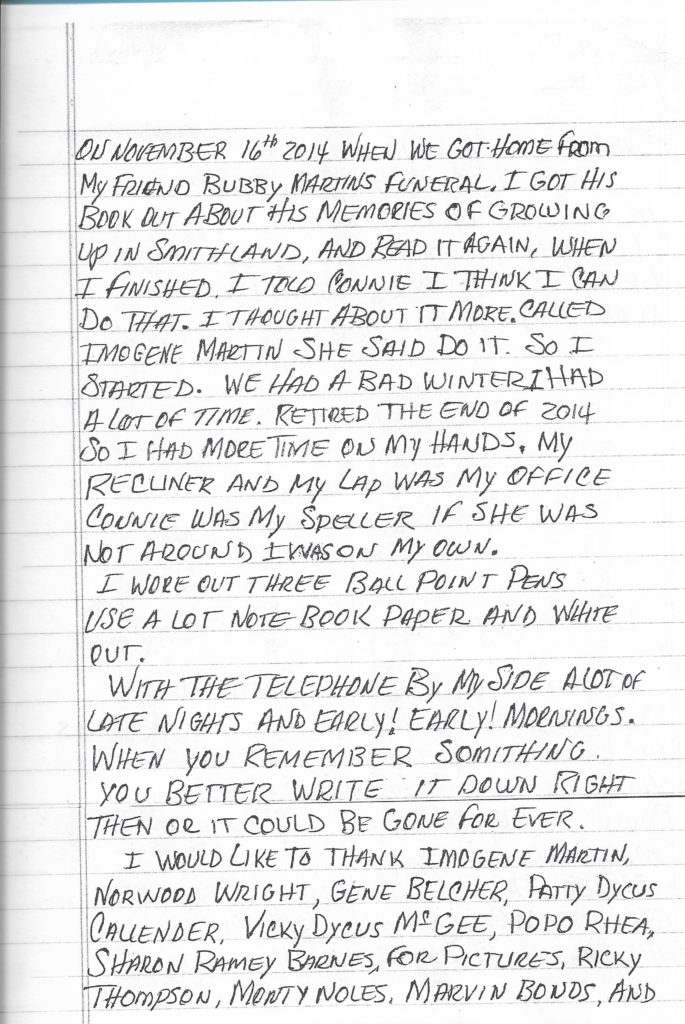
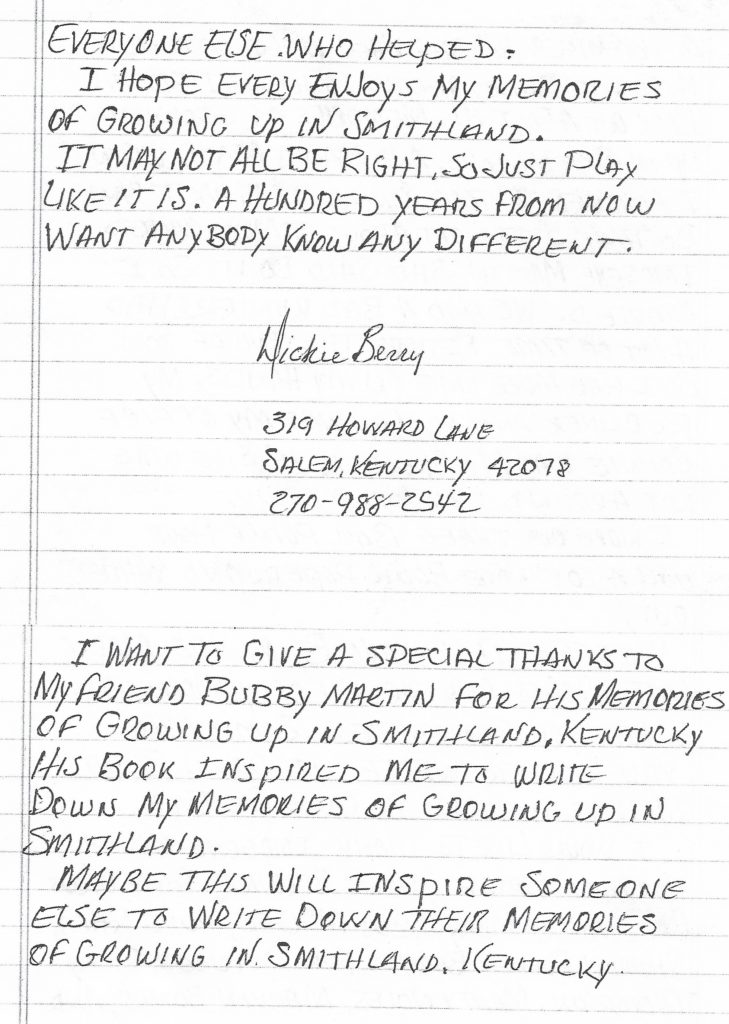
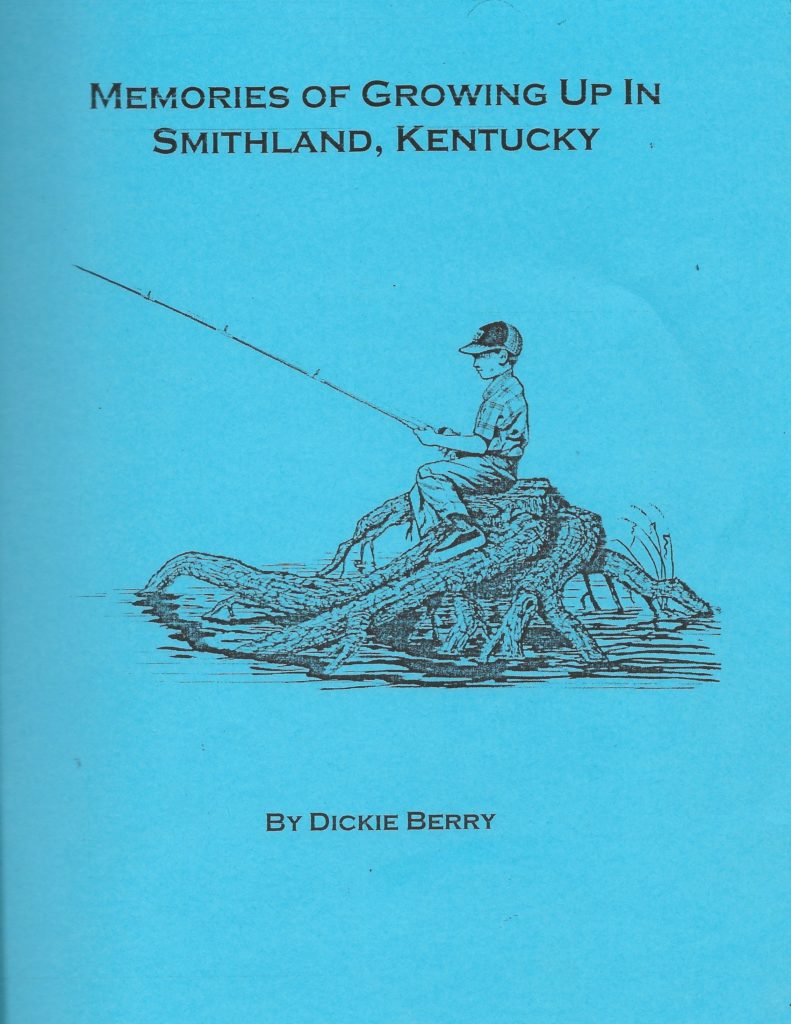
Contact the Livingston County Historical Society for your copy. Price $10.00
Sop it up with your biscuit!
Sop it up with your biscuit!
November 3, 2023
By Lola Guess
“Sop it up with your biscuit” is a term not heard much anymore. First of all, who has time to make biscuits and gravy in the mornings. Especially the big cathead biscuits that our grandmothers made. They were called cathead biscuits because they were as big as a cat’s head. After you finished eating, if there was any gravy left on your plate, it was perfectly acceptable to take your biscuit and “sop” up the rest of it. But then, if you wanted to add some sorghum and maybe a little home churned butter for a sweet treat at the end of breakfast, that was guaranteed to keep you full until dinner time.

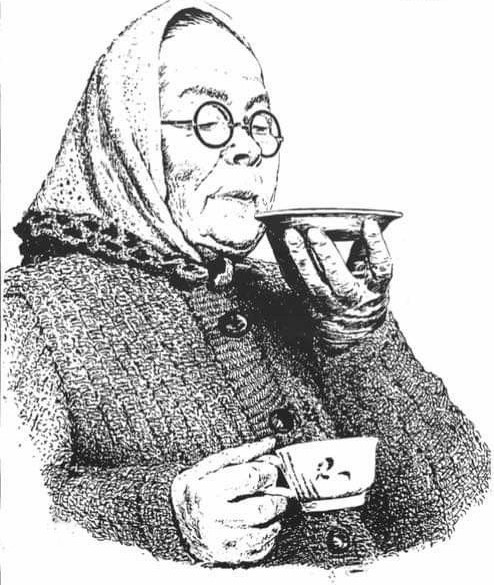

Then, there is the matter of drinking hot coffee. Did you ever see your grandparents pour a little coffee in the saucer, and blow on it and then “slurp” it up? That was perfectly acceptable too. First of all, who uses saucers now-a-days, and secondly now, it probably would be considered bad manners to slurp at the breakfast table.
When it was time for dinner (lunch now) you might sit down to a poke (polk) salad and crackling cornbread. Poke weed grows wild. It was cooked like any other greens. If there was no poke to be found, there might be some leaf lettuce ready in the garden. This was made into wilted lettuce which consisted of vinegar, salt, pepper, onions, and sometimes radishes with hot bacon grease poured over it until it was “wilted.” Crackling cornbread and wilted lettuce was the perfect combination. Cracklings are pieces of fatback that are cooked and crumbed into the cornbread mixture to give it a flavorful bacon taste. Dinner would be completed with beans and ham hock.



A glass or a mason jar full of buttermilk mixed with crumbled crackling cornbread might be all you would need for supper especially if relatives or neighbors were coming over to sit on the porch, pitch horseshoes, and make homemade ice cream. Although it took a while to hand crank the freezer long enough to freeze the ice cream, it was well worth it. When dark finally came, it was time for the kids to catch lightning bugs and finish up the day.

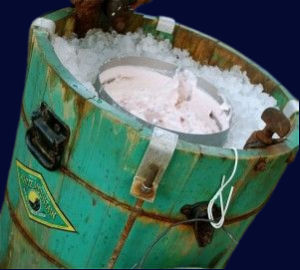

What memories do you have of food or entertainment back in the day? Going blackberry picking to make a cobbler? Shelling bushels of purple hull peas? Picking up hickory nuts to make a pie? Singing around the wood stove? Playing checkers?
McGrew Farms: 150 Years of Tilling the Land
October 27, 2023
By: Colton McGrew & Roger McGrew
The McGrew Family has a long history in Livingston County, dating back over 150 years. The Family arrived in America as part of the Scots Irish migration from Northern Ireland when Robert and Isabella McGrew stepped off a ship in Philadelphia in 1722. Over the course of the next century and a half, the McGrew’s moved around the back country of Pennsylvania and Kentucky before settling into Northern Kentucky in the years before the Civil War.
In 1871, George Newton “G.N.” McGrew and his wife Mary Elizabeth Rogers decided it was time for a change. The couple left their home in Spencer County and moved to Livingston County. Settling in Carrsville for a year, they were soon followed by G.N.’s brother Permanus McGrew, who became a banker in Carrsville. In 1872, G.N. and Mary decided to take up farming, moving a few miles down the river to a farm on the bluff above Bayou, then a prosperous port on the Ohio River known as Bayou Mills. Their newly begun farming operation produced cattle, wheat, and even an apple orchard. Continuing in the family tradition of innovation, G.N. employed the newest in farming techniques, eventually earning a place on the Kentucky Board of Agriculture.
After establishing their place in Livingston County, the couple soon welcomed three new additions to the family: their children Miller Almer, Joseph, and Georgia. Georgia eventually married Gus Edwards, a First World War veteran and Paducah businessman, and became a prominent local artist. Miller continued the family tradition, farming the family land and eventually moving into the family’s home upon G.N.’s death.
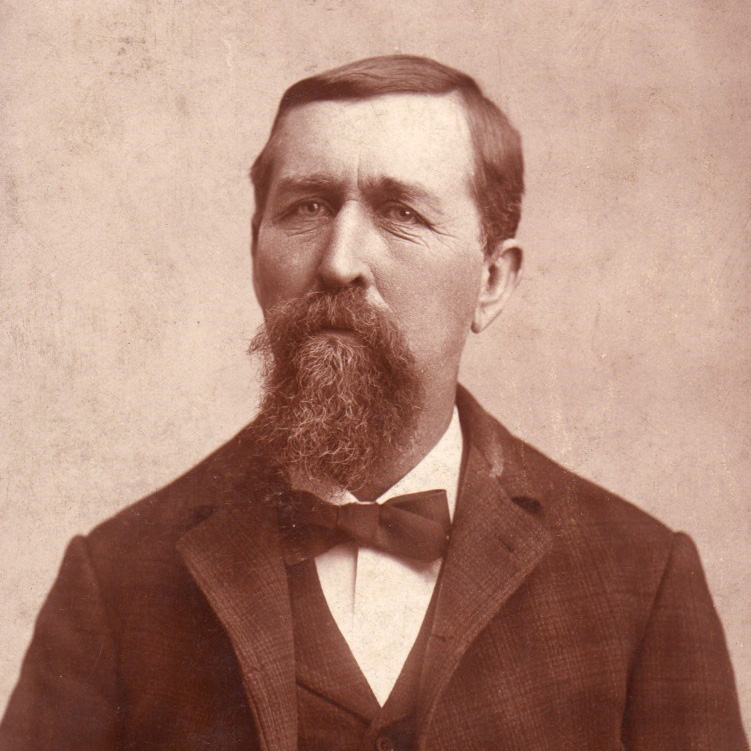
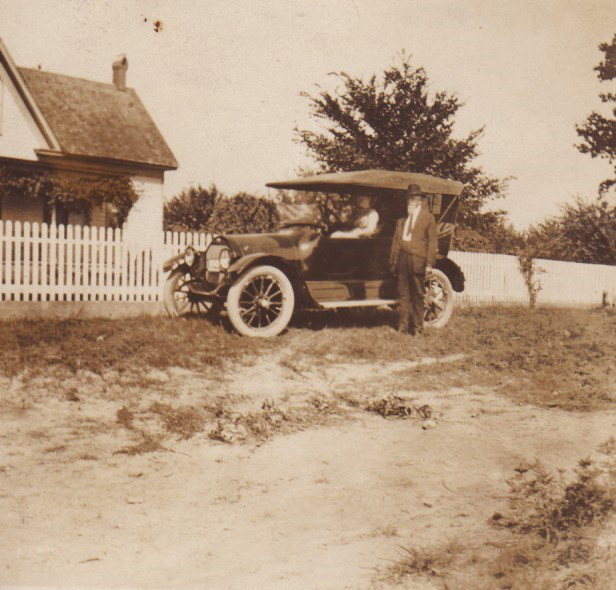
G. N. & Mary Elizabeth Rogers McGrew
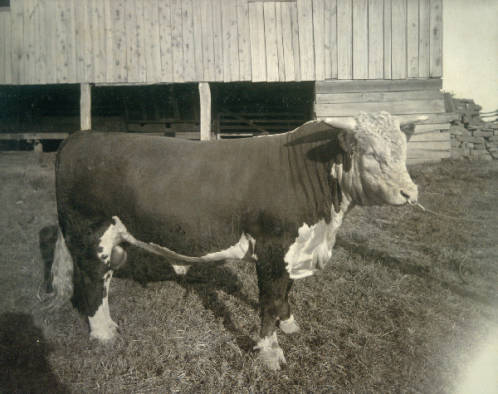
Farm Service Agency Photo Taken in 1930's
In the 150 years since the McGrew’s arrival to Livingston County, the family has continued to farm the land, expanding the farm, and continued to innovate employing the latest in agricultural science. Miller eventually married Linnie Belle Nelson, bringing three more children into the family: George Nelson, Mark, and James “Jimmie.” All three of the boys spent their childhoods on the farm before serving in the Second World War. After the war, each pursued their own paths in life. Mark, always a wild character, eventually bought a Piper Airplane and taught himself to fly. George and Jimmie stayed on the farm and carried on the traditional career of the family.
George would have one son, Roger, who embarked on a career in computer technology before retiring to return to Paducah. Jimmie would have two children: Carolyn, born about the same time as Roger, and Jeff, born later in 1960. Jeff had a successful career ranging from general contracting right out of high school, to a businessman operating a farm store in Smithland, and finally taking up the family tradition farming the land. After Jeff married Patty Croft, the fifth generation would arrive at the turn of the century: Colton and Masa.
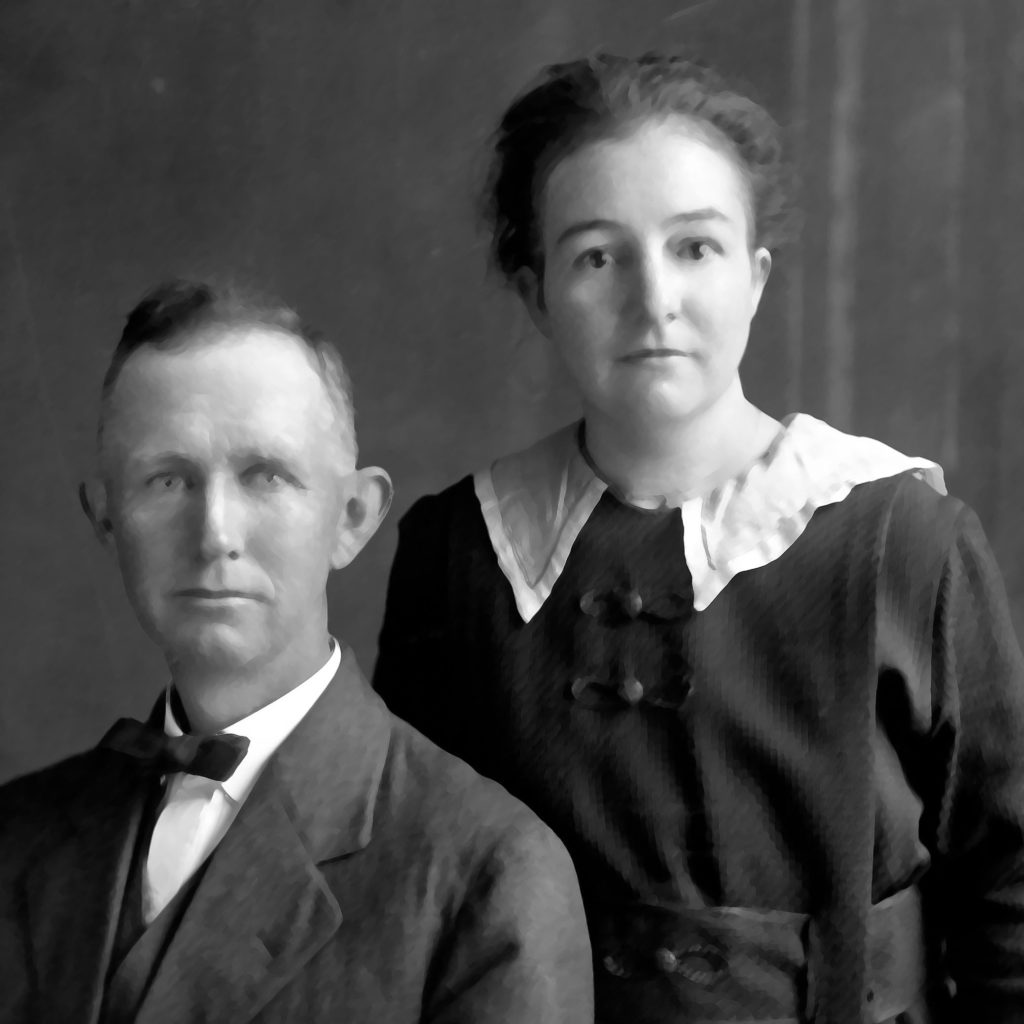
Miller & Linnie Belle Nelson McGrew
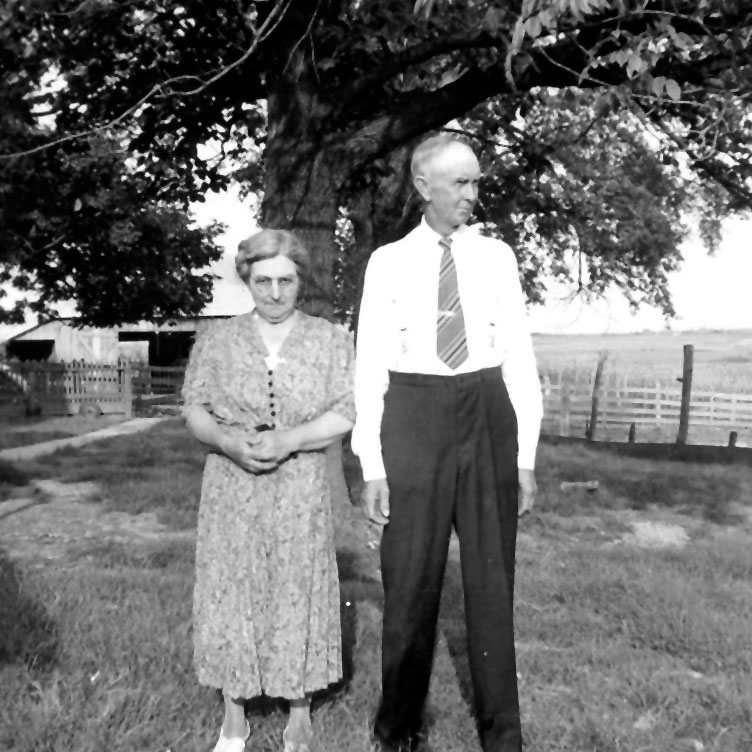
Linnie Belle Nelson & Miller McGrew
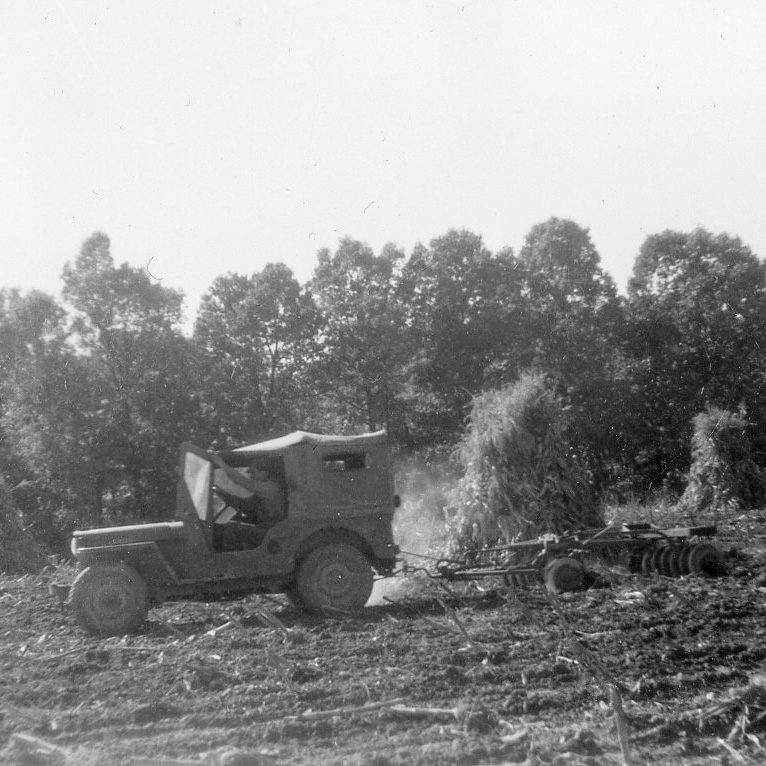
Disking with Jeep
Today, Jeff and Patty continue the old profession of the family, raising corn, soybeans, wheat, and hay on the family farm. Masa and her husband, Taylor Champion, raise cattle with Jeff and Patty. Colton is currently pursuing a law degree in Nashville, Tennessee. Roger and Carolyn live in Paducah and frequently visit the old family lands.
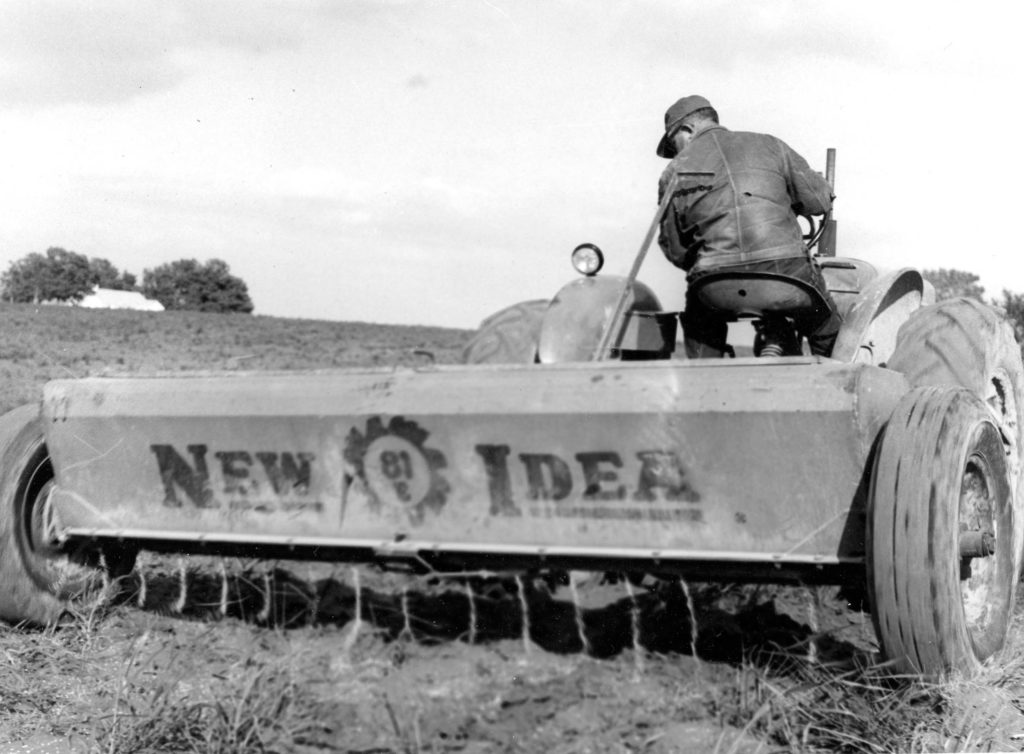
George Nelson McGrew
Eugene Earl Trimble
October 20, 2023
By Lola Guess
Recently, the Historical Society was honored to have Mr. Gary Trimble visit the Historical Society and tour the museum as well as other places in Livingston County. Mr. Trimble and his wife are both attorneys living in Las Vegas, Nevada. Gary’s father is Mr. Eugene Trimble of McKinney, Texas.
Eugene Trimble was born on April 28, 1922, in a log cabin near Joy, Kentucky. His parents were Foster Oliver and Lura Ellen Shouse Trimble. Both are buried in the Bethel Cemetery in Joy. The family also included a brother, Glenn Allen, and a sister, Lou Ellen. When Eugene was thirteen years old, the family moved to Smithland. Eugene graduated from Livingston High School in 1940 (picture on Facebook with his graduating class) and later attended Draughon’s Business College.
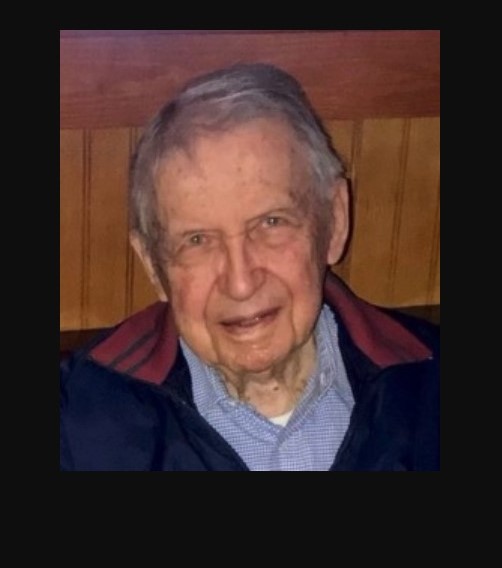
Eugene Trimble
McKinney, Texas
Two years after graduation, Mr. Trimble went to Washington D. C. to work for the FBI. In 1943 he was drafted and served three years with the 94th Infantry under the command of General George Patton. Soon the Army recognized Eugene’s ability to type 83 words a minute. He was assigned to the battalion office at a command post in Pilsen, Czechoslovakia, and later as an accountant in Bamberg, Germany. After being discharged from the army in 1945, he returned to his FBI job as a fingerprint analyst. He then learned about the GI Bill and enrolled at George Washington University, Washington D.C., and earned a degree and a CPA certificate. He married Betty Owen, from Vilonia, AR, in 1950. They had two children, Gary Allen, and Janet Lynn.
From 1950 to 1996, Eugene worked for the W. D. Campbell Furniture Company. He began as a company accountant and owned the company when he retired in 1996 and moved to McKinney, Texas, to be close to his grandchildren.
After 69 years of marriage, Betty passed away on July 6, 2019, at the age of ninety-three. Mr. Trimble recently celebrated his 101st birthday. He maintains a website, www.eugenetrimble.com, containing photos of Livingston County as well as personal historical accounts.
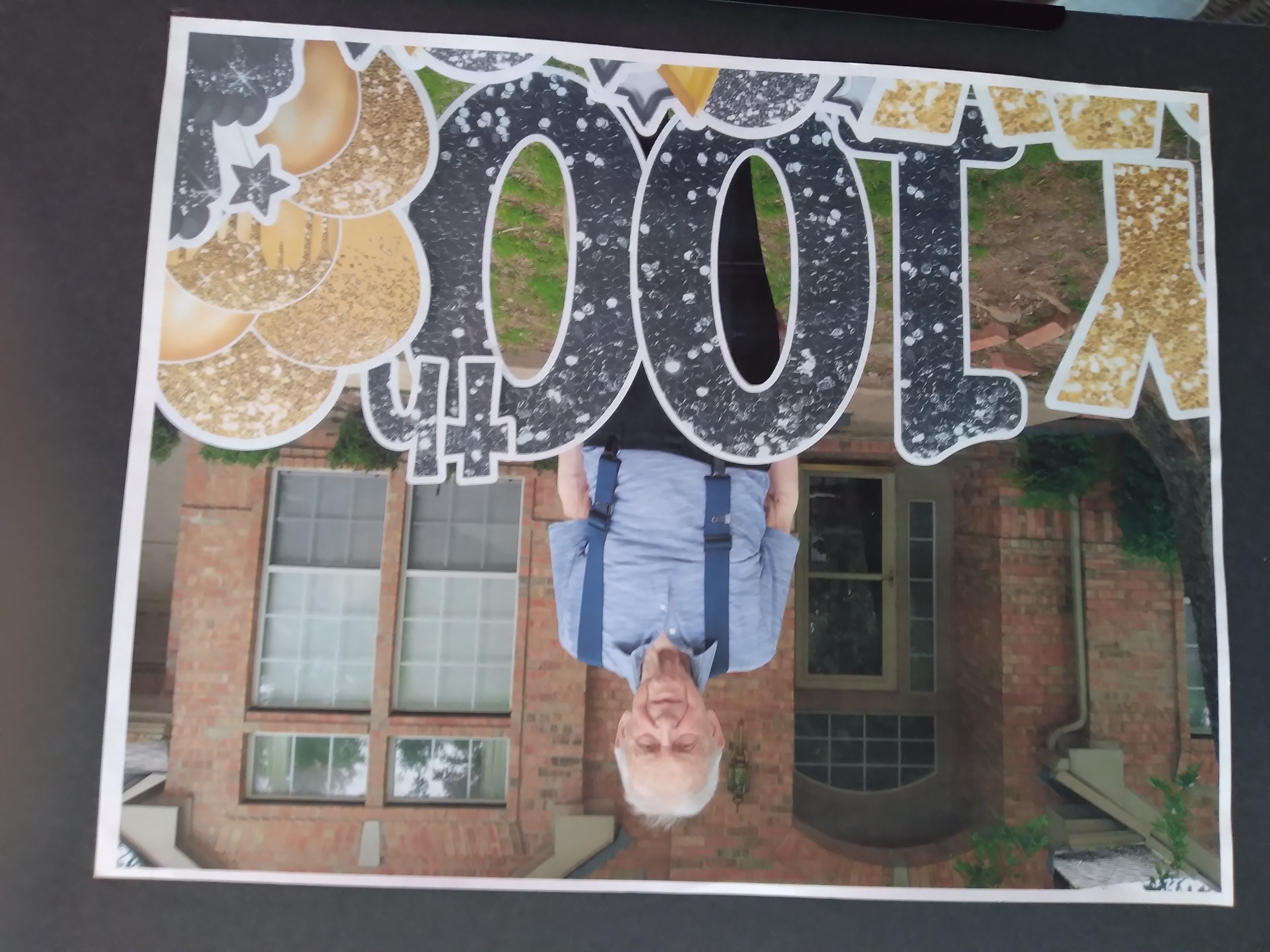
Celebrating 100 Years
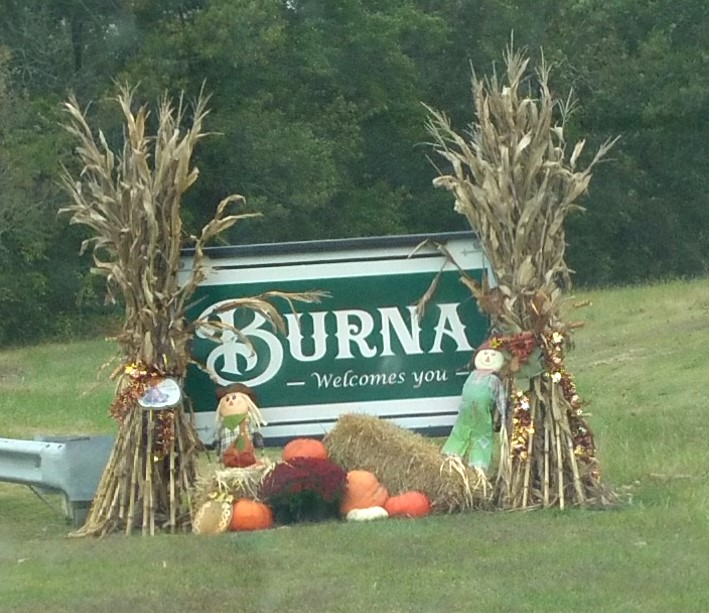
Come with me to Burna!
October 13, 2023
By Lola Guess
Burna, Kentucky, was established about 1890 and grew into a busy town in the first half of the 1900’s. There were grocery stores, blacksmith shops, auto repair shops, churches, farm stores, auction barns, and feed stores to name a few. On September 1st, 1936, the Paducah Sun-Democrat reported “three thousand persons attended the annual home coming picnic here Sunday.” Burna was also home to a successful baseball team in the 1940’s.
September 2, 1946
Paducah Sun-Democrat
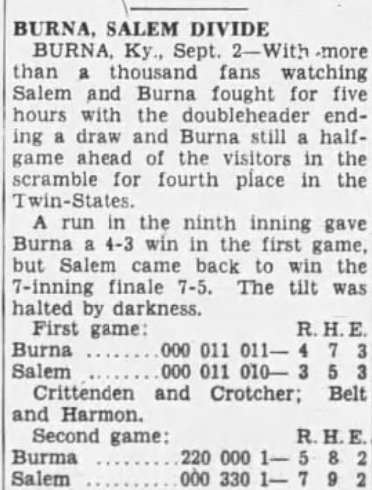
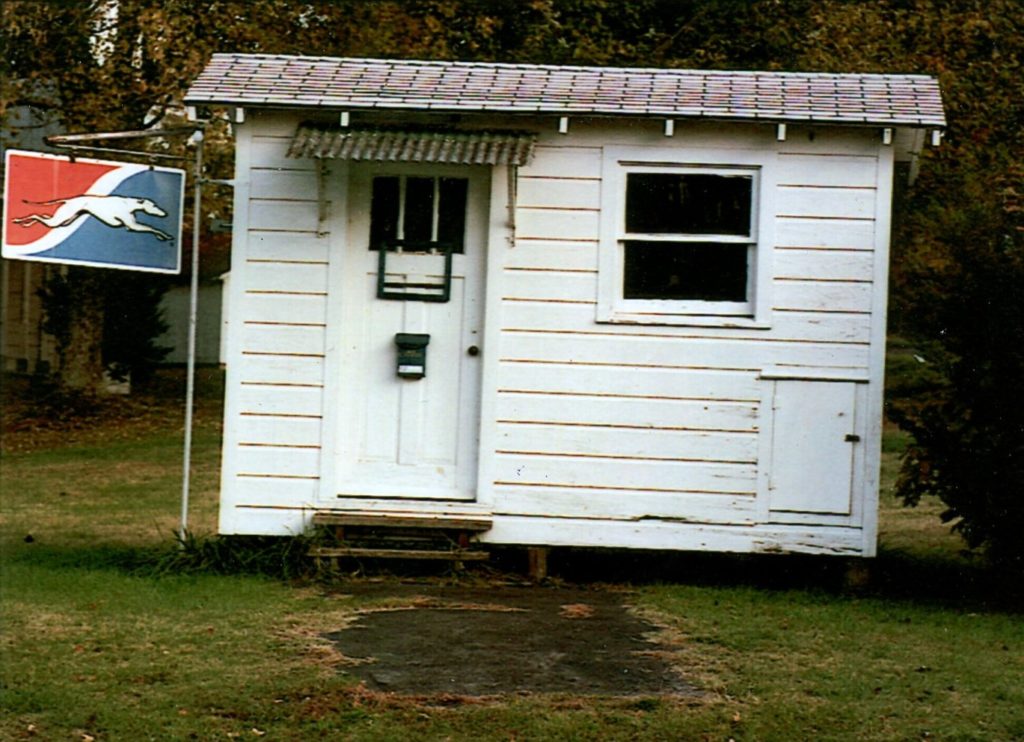
Burna Bus Stop
The Burna Bus Stop was the smallest Greyhound Bus Station in operation and is still standing.
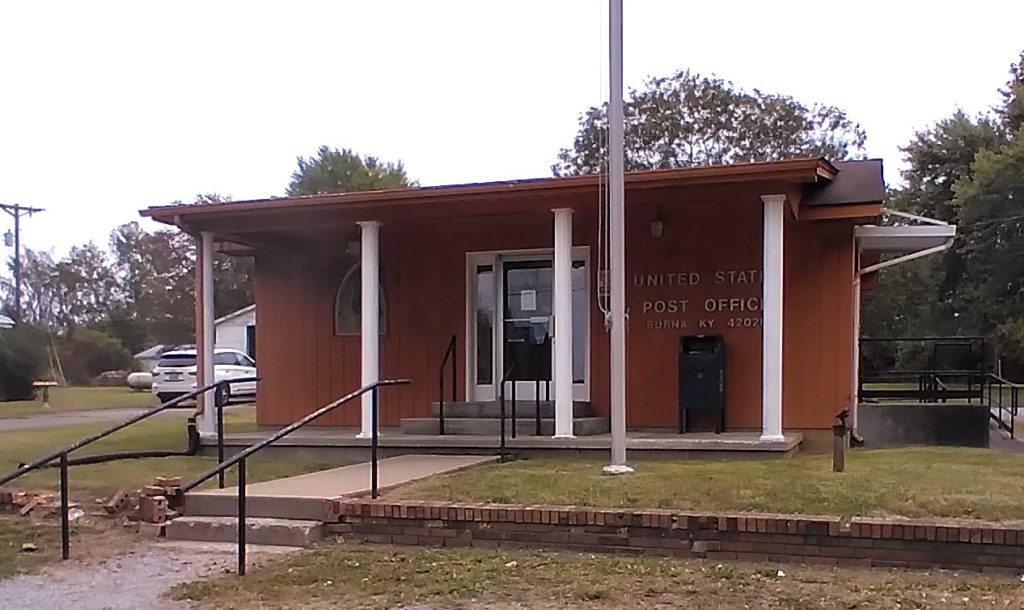
Burna Post Office

Burna Fire Station
Muriel Dickerson
October 5, 2023
By Lola Guess
“I loved my life. We knew how to work and God provided for us.” These are the words from Muriel Dickerson about her life of 102 years. Mrs. Dickerson also said she still has a lot of living to do and is enjoying every day of it. The Smithland Octoberfest on Saturday, October 7th, will host a parade with Mrs. Dickerson as Grand Marshall. Mrs. Dickerson said she is looking forward to it and all the people she will see.
Muriel Wilbanks was born on November 26, 1920, to Nell and Clarence Wilbanks. There were nine children. Muriel walked to school every day and the first school she attended was Lick Skillet followed by Blooming Rose School, Pleasant Grove, and then grade school in Livingston County. Muriel married Claude Thomas Dickerson on September 18, 1937. They were married at the Smithland Courthouse by Judge George Heater. Claude and Muriel had five children, Glenn Dickerson, Beulah Holt, Bonnie Hosick, Lesia Ruschmeyer, and Charlotte Belt.
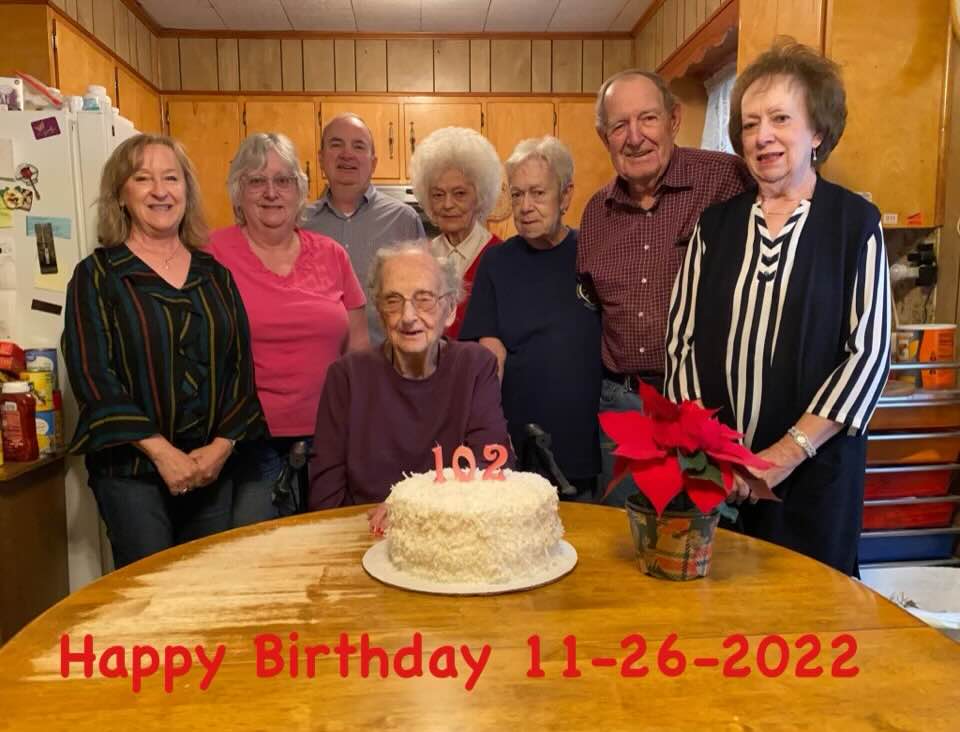
Mr. Dickerson (1907-1999) was a schoolteacher and PVA officer for Livingston County for forty years. Muriel worked as deputy PVA for several years and without pay. They worked out of their home until 1950 when they moved to an office in the Court House. Mrs. Dickerson stated that she loved “staying at home, taking care of my family, quilting, gardening, and canning.” She taught Sunday School at Old Salem Baptist Church and was active in the PTA when her children were small. She said, “I loved listening to older people when I was young. They taught me how to card cotton, make rag rugs, quilt, and do it right.”
Mrs. Dickerson attended the dedication of the new Jim R. Smith Memorial Bridge in Smithland on May 15, 2023. She also attended the dedication of the old Lucy Jefferson Bridge in 1931. An event occurring ninety-two years apart. The parade in Smithland begins at 1:00 p.m. Look for Mrs. Dickerson as she leads this year’s parade.
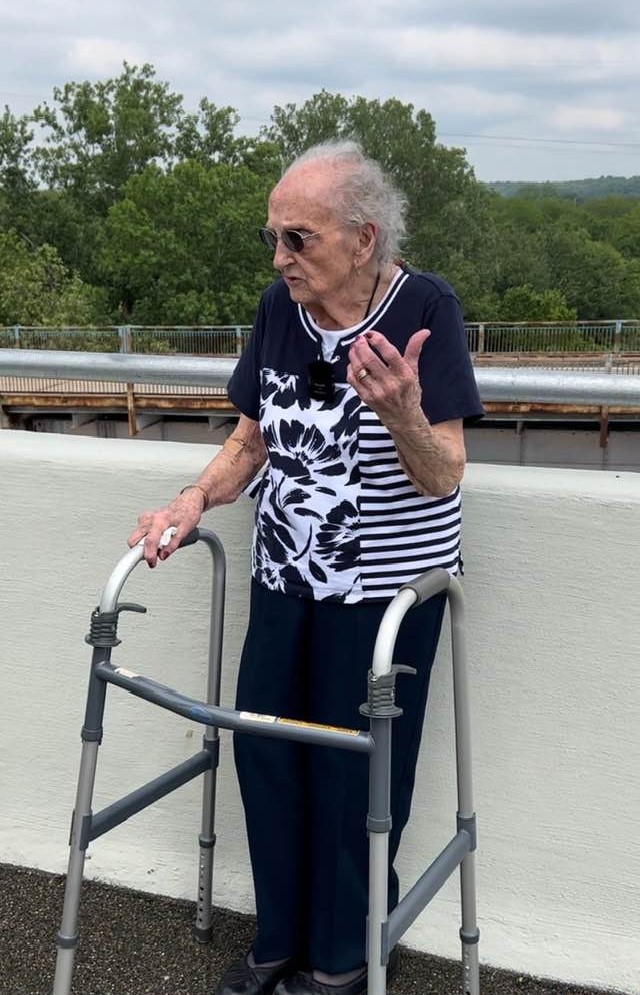
Did You Ever Ride a Mule?
I have not posted any stories the last two weeks because I spent a week in the hospital with Covid and pneumonia. This past week I have been recovering at home and I have watched TV probably more than I needed to. Gunsmoke is one of my favorites. Festus and his mule “Ole Ruth” can solve all the problems in Dodge City. Have you ever ridden a mule? Did your grandparents or parents break up the garden with a mule?
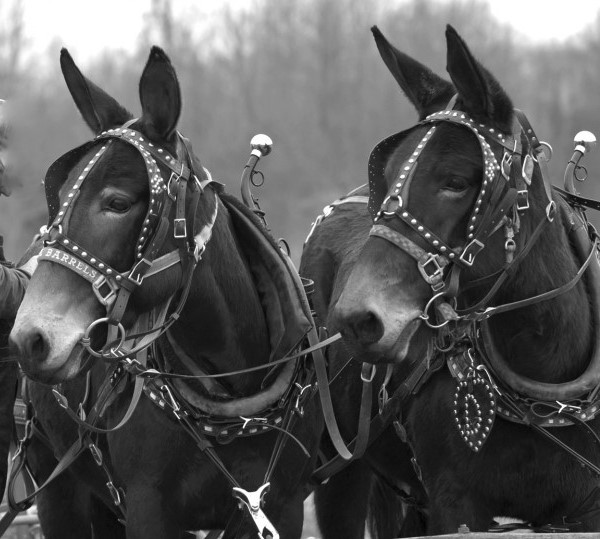
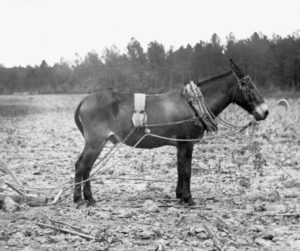
When settlers first came to Livingston County, they needed a mule, a plow, and a simple harness to put out a crop. Farmers relied on corn, tobacco, and hay to survive. Kate and Julie seemed to be popular names for a pair of mules. They were used instead of horses because mules were stronger, had more stamina, ate less, and lived longer. Farmers used “gee” and “haw” which is right and left to turn the mules. “Gee-haw” together meant straight ahead and of course “whoa” meant to stop. Mules teeth were checked to determine age. Census takers even listed the number of mules in the household on census reports. Then there is the fact that mules can be contrary. Mules can plant their feet in the dirt and balk and bray and there is not much anybody can do about it.
The lowly mule cannot be discounted. At the end of the Civil War the freed slaves were offered forty acres and a mule, which was a failed promise. Later mule trains settled the west by carrying loads of cargo over the mountains and into the mines. Mules have played a big part in winning wars throughout history by transporting weapons, food, and supplies to places not accessible by any other means. The “Crittenden Press” reported that 1000 mules and horses were in Marion on Mule Day in 1906 with the average price ranging from $75.00 to $100.00.
Trail rides have always been popular in Livingston County. Mules are better suited for trail rides because they are more sure-footed than horses. Tiline residents, Barnell and Alice Doom, enjoyed trail riding along the beautiful trails and roads in our county. (Barnell passed away in July of 2020.) These pictures of Barnell and Alice on their mules allow us a peek into their adventures.

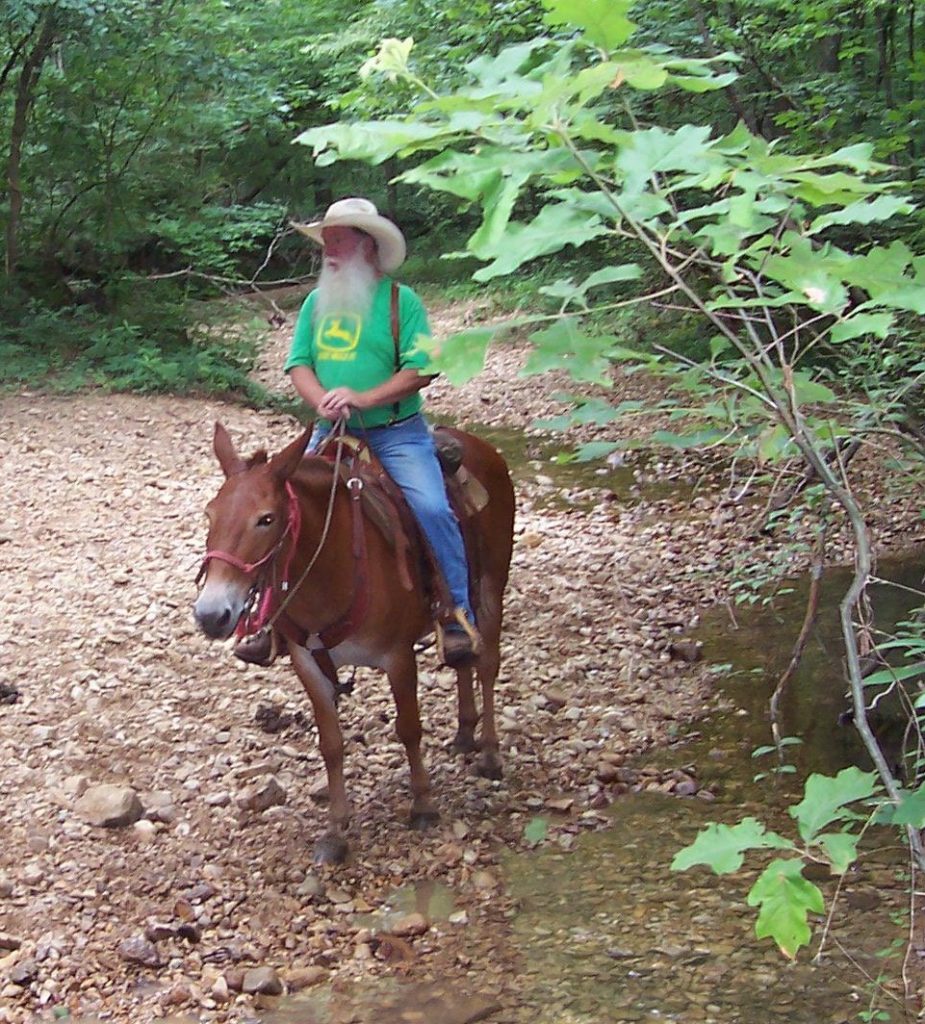
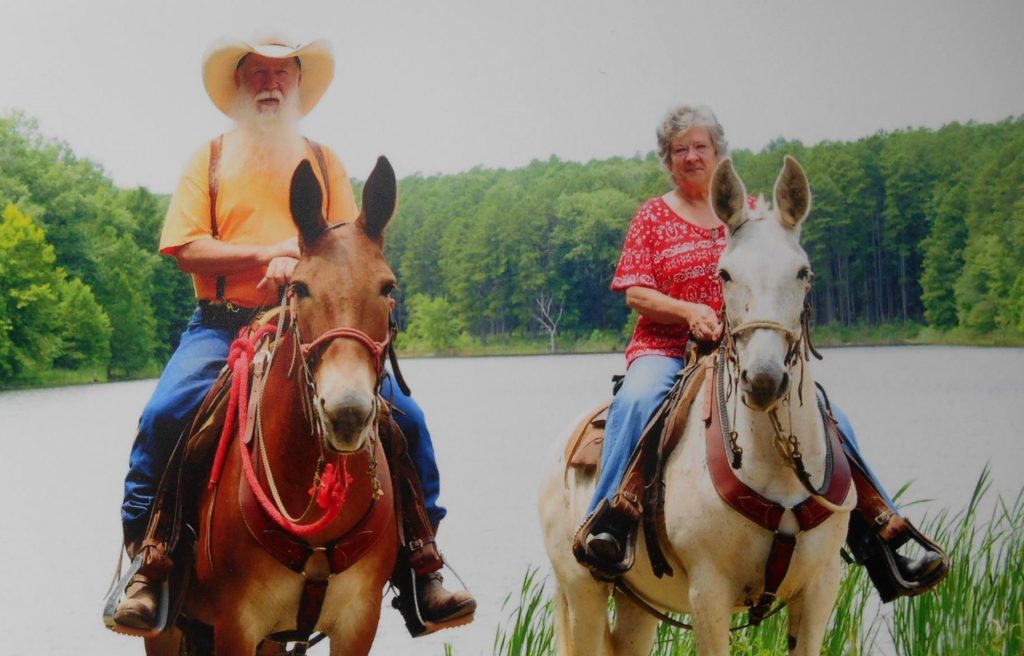
Breakdown at the Buzzard Roost
The video was recorded by Norwood Wright on June 7, 1991, at Smithland, Kentucky.
Livingston County Churches
Livingston County Churches” by Linda Phillips Fox. Spiral bound. Published in 2023 by Livington County Historical Society. $15.00 plus $4.50 shipping. The book contains stories and pictures of churches in Livingston County both past and present. Excellent for Christmas presents and those researching the County.
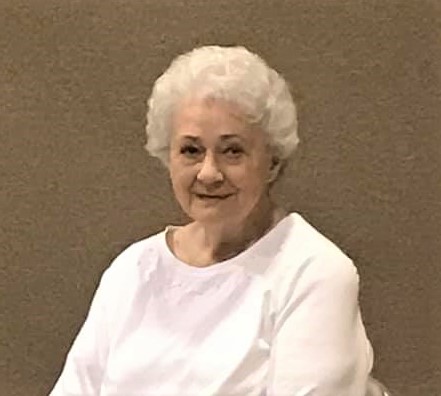
“
The following is an excerpt from the book about Good Hope Baptist Church.
“Good Hope Baptist Church was organized in 1842. There was a meeting at the Mount Pleasant Meeting House on April 30 and May 1 of 1842. It was at this meeting that Good Hope Baptist Church was organized in the presence of Elder William Bandean, James W. Mansfield, and Joel E. Grace. They represented the United Baptist Association of Livingston County.
The church was built with nine members, one being a black woman. Joel E. Grace was the first pastor.
In 1882 the church known as Old Good Hope moved to a site near the Hampton and Joy Road on Hwy. 135. In 1962 the old building was torn down and rebuilt. Bro. Z. M. Downs was pastor at that time. Other pastors have been Rev. James Sullenger, Rev. Will Ed Nance, Rev. Buddy Keeling, Rev. Virgil Diel, and Rev. Mike Templeton.”
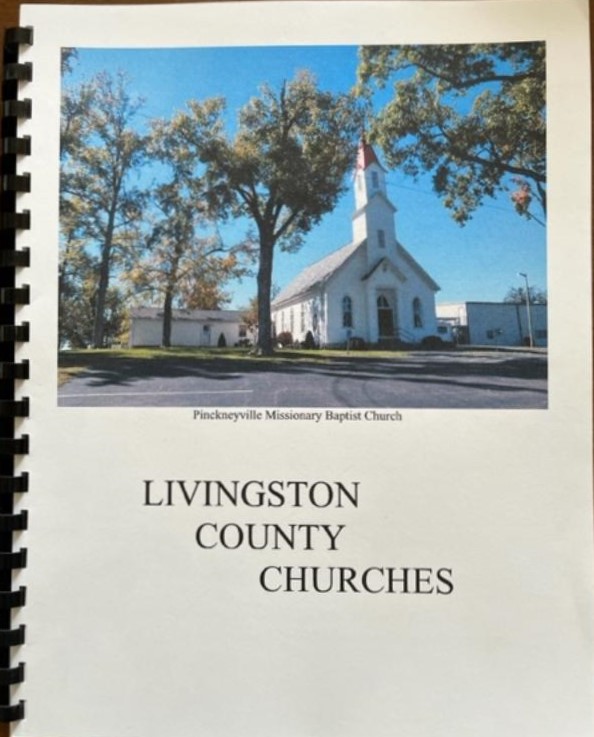
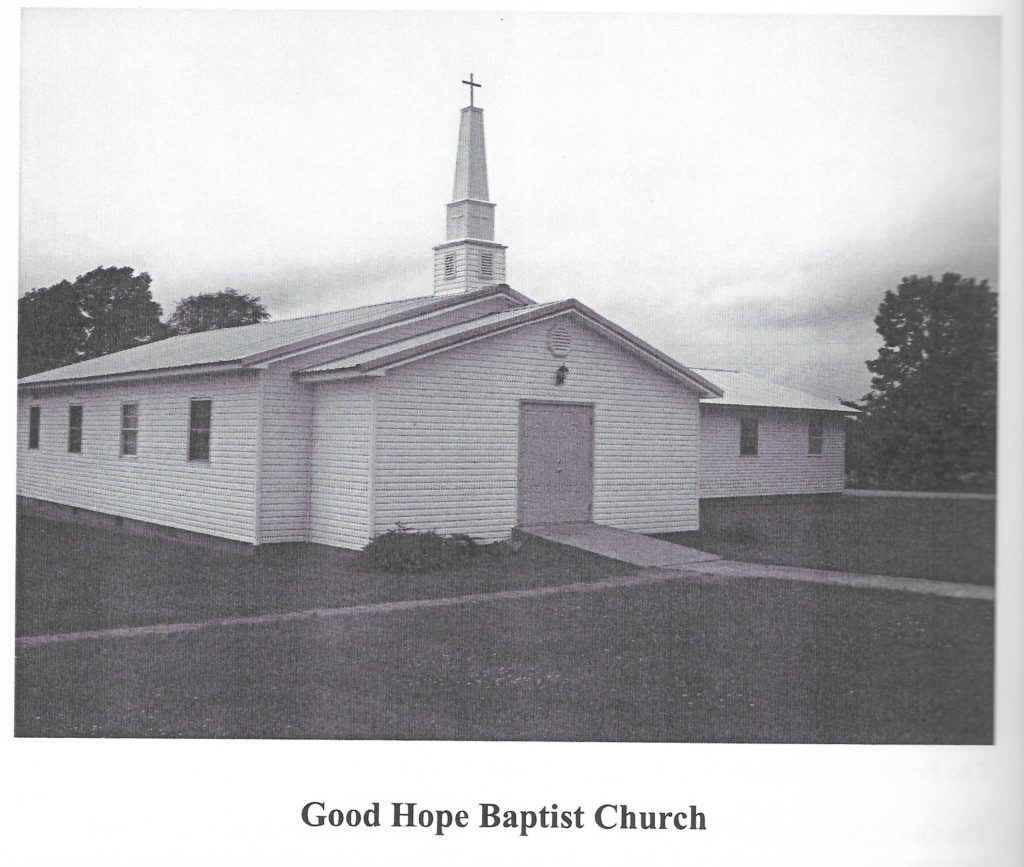
Renovation of the Old Livingston County Courtroom
By Justice Bill Cunningham
August 25, 2023
The court room in Smithland was built in 1845 – the same year Andrew Jackson died. One can still see it today, as it remains as a museum in the hands of the Livingston County Historical Society. There was no air conditioning, and at one time it was heated mainly by a large pot-bellied stove in the corner. A rope came down through the ceiling right behind the jury box. It led up to the bell in the cupola atop the courthouse. Each time court was convened, the one-armed jailer, Orville Cox, would ring that bell as the bailiff announced the opening of court and the judge took the bench.
Trials in the summer were insufferable. In a double murder case, I prosecuted one blistering August week, I lost 15 pounds. The judge’s office was located all the way to the rear of the court room and was falling apart. One day I heard a scratching above my head as I was working at my desk. I looked up and saw the bottom of the feet of a pigeon on the plexiglass covering the neon lighting.
But we soldiered on, thinking that we were not really any different from the lawyers and judges plying our trade in the other 119 court rooms throughout the state. By the early 1990’s, the 150-year-old court room in Smithland had become unsightly and dark. It was still serviced by the original wiring that had first brought electricity to the building. I finally had enough. One day I brought an old fashion oil lamp from home and mounted it on the back wall and lit it. I took a picture of it and sent it to the Chief Justice with this cryptic message: “We are the only court room in Kentucky still lighted by oil lamps.” It was for a demonstrative purpose. But I was tempted to keep it. The lamp actually helped.
The picture did the trick. Almost immediately plans were made to rewire the whole courthouse. Now that we had Frankfort’s attention with the lamp trick we decided to push forward with a total renovation of the old courtroom. In that historic old courthouse, the office shared by the judges was off to the right after one entered the front doors to the court room. It did not have access to either heating or cooling. Thanks to County Judge Executive Joe Ward, that changed.
Joe was made a quadriplegic from a car accident. He heroically moved about in his motorized wheelchair and with the loyal assistance of his wife. I admired them both greatly. He had a gas heater installed in our judge’s office for winter comfort, and a window unit air conditioner for the summer. I was very grateful. At some point, the knob was lost off of the AC. So, I went to the
Dollar General and purchased a cheap pair of pliers with which to operate it. When I passed the gavel to my successor, Judge Woodall, I also handed over to him those pliers.
The much more far-reaching improvement Joe Ward did for the court facilities was the installation of a much-needed elevator. Up till that point, the sheriff deputies had to pack crippled people needing access to the courts up the long flight of steps. In many instances if the person was a witness, or even a party, the court would try to accommodate them by moving a hearing downstairs somewhere.
Tinker Lister was the courthouse custodian and janitor. One afternoon he came to my office and inquired if court was finished for the day. I assured him that it was. “Okay,” he said, “I will cut off the elevator.” This piqued my curiosity. “You mean you cut the elevator off at night?” I inquired. “Yes,” answered Tinker. “If you don’t people from town come over here at night and ride it.” Indeed, not much to do in Smithland when the sun goes down.”
This is a condensed version of an article Justice Cunningham wrote about the old and the new courthouse. In the interest of space, the timeline about the new courthouse was not included. If you would like to read the complete story, please contact us and we will email you the entire article.
Judge Cunningham still presides over the courtroom in Smithland. Livingston County artist, Dana Kolb, created a life-sized mannequin of Justice Cunningham. Judge Cunningham donated one of his robes to dress the mannequin. Visit the museum and see Justice Cunningham in the courtroom!
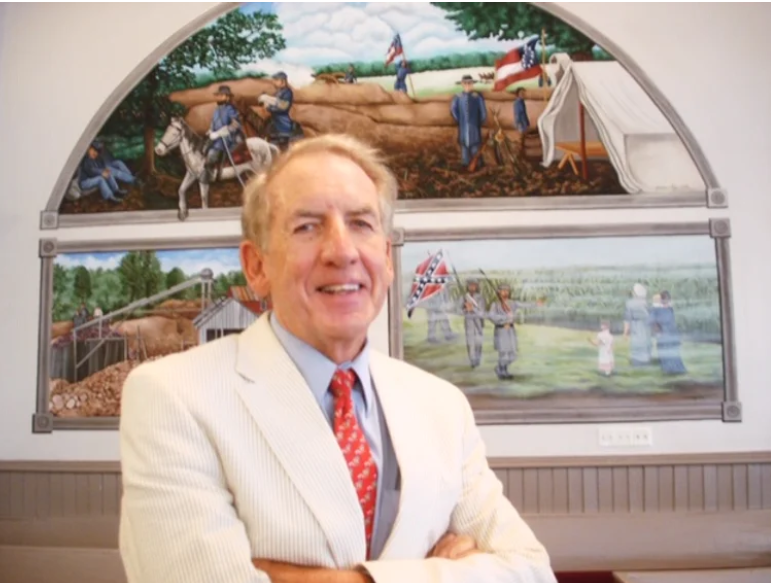
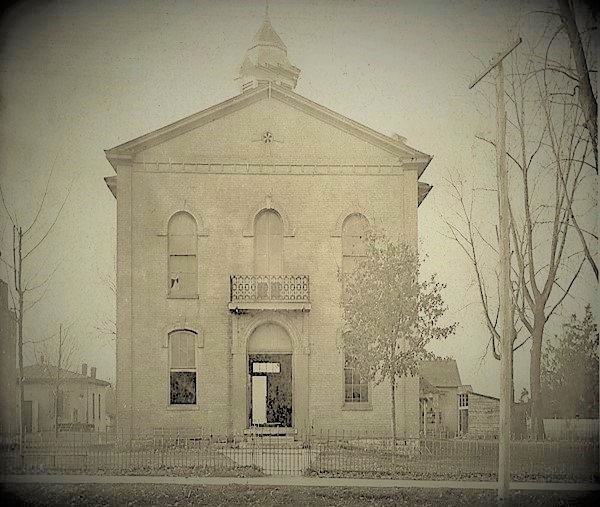
Discover Historic Carrsville
August 18, 2023
By Lola Guess
As I drove through Carrsville, I could see a busy river town in my mind. Many of the old homes and landmarks are still there, some beautifully restored, some forgotten. Carrsville is peaceful and calm on this sunny day in August. The river is a beautiful sight. This story doesn’t provide a lot of information. Only a few facts. Enjoy the scenes of unique Carrsville.

Stanley Walker
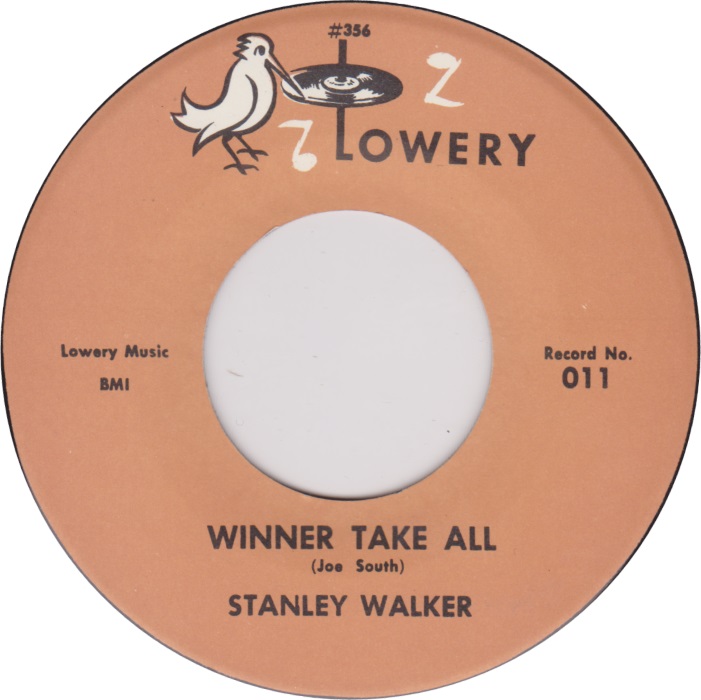
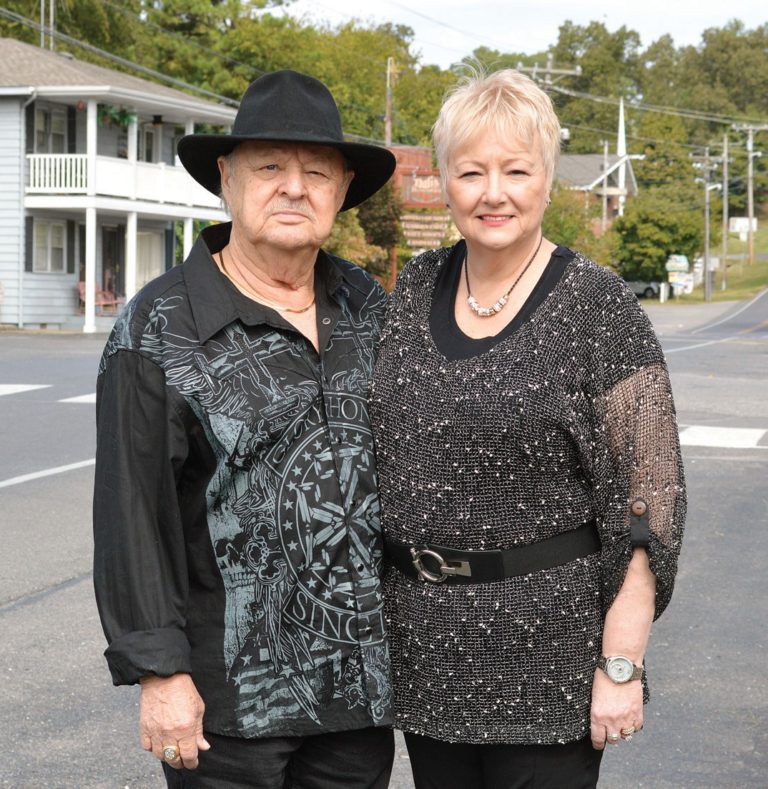
Stanley & Kay Walker
August 11, 2023
By Lola Guess
His voice has been described as deep, soulful, and emotional. His guitar picking is incredible. His is Livingston County’s own, Stanley Walker. Stanley began picking a guitar at the age of six. First in his career, he played with gospel singers Dottie and Bucky Rambo. At the age of 17 he joined Melber native and country music star Ray Smith’s band. He auditioned in a skating rink in 1956 in Metropolis, Illinois, for Smith and spent the next thirteen years with him touring and recording. He earned $3.00 a day on this job. Walker was lead guitar on Smith’s 1961 hit “Rockin’ Little Angel.” Walker worked with other legends of country music such as Jerry Lee Lewis, Lefty Frizzell, Hank Williams Jr., and Roy Clark. He toured with country star Jean Shepard and appeared on the Grand Ole Opry and was on the popular TV show HeeHaw.
Stanley quit life on the road in 1985. He had had enough of riding on a bus. He came back to settle in his home in Livingston County with his wife, Kay. Earlier in his career, Stanley was a popular attraction at the Time Out Lounge in the Executive Inn, the Cabana Club, Continental Inn, and many other venues. After a decades-long career, he remains popular and is sought after to play and sing with his band around the area. Grand Rivers, Kentucky, sponsors “Stanley Walker” day where he performs at the Badgett Playhouse to raise money for Kosairs Charities. This video shows his extraordinary guitar-playing ability and his amazing voice. Stanley Walker recently celebrated his 84th birthday.
The Livingston County Historical Courthouse Museum is proud to have a display featuring items Stanley has donated to the Museum.
The Day the Bull Went Berserk
August 4, 2023
Reprinted from the Livingston Ledger
Published in the Mid 1970’s
A bull which escaped slaughter at Smith’s Meat Processing Plant attacked and injured Mrs. Velda Johnson and her daughter, Faye Johnson, who reside at Wilson Avenue. Tuesday morning Mrs. Johnson suffered lacerations and bruises as we go to press. Her condition is considered fair at Western Baptist Hospital in Paducah. Miss Faye Johnson was knocked down but suffered no broken bones.
The bull was one of the new mixed breed of Hereford and Angus, bred for stamina. The owner, Raymond Phelps of Fredonia had warned that he was extremely dangerous. It is the practice of Smith’s to shoot such animals in the truck they come in, according to Ralph Smith.
Ralph Smith did not think this bull looked too dangerous. They decided to unload him. Noticing that the truck wasn’t backed in the platform too straight, the bull broke through the loading chute and darted at Ralph Smith. He escaped and ran to the top of Cemetery Hill.
Billy Downs was mowing the cemetery lawn when he saw the bull pawing and snorting toward him. He left his mower in panic and sprinted away as fast as he could. The bull went back down the hill to Mrs. Johnson’s back yard.
There, they were having a cookout. The bull charged Mrs. Velda Johnson and Miss Faye Johnson. Several tried to rescue the elder lady and she was rushed to the hospital immediately by the Livingston County ambulance.
Ralph Smith went downtown in Smithland to warn all elderly women who were calmly visiting with one another to take cover, but no one seemed to realize the gravity of the situation.
Meanwhile the bull took “rounders” on the Long Farm and made for Highway 60. Smith’s men tracked him to the cemetery and soon spotted him. “Little Jug (Neville) Robertson kept shooting him.
After the mad bull had been shot about a dozen times, he was still wild. He rammed his head in the grill of Deputy Encil Johnson’s truck and left a swath of skin and hair deep in the grill. He tried to get at the radiator.
Then the mad bull attacked a woman in a station wagon, almost upsetting the car, but she speeded up and escaped him. This tourist will remember Smithland!
“Little Jug” pumped about three more shots into the bull before he was killed. He has been skinned and will soon make some gorgeous steaks!
Epilogue: Written by Billy Downs:
July 24, 2023
I will never forget the incident! The writer apparently didn’t interview me before publishing the story. My encounter with the bull did not happen as reported.
I was using a push mower, heading uphill parallel with the road, below the Branstetter lots. Suddenly I was hit in the back and knocked to the ground. I did not hear the bull coming because of the noise of the mower’s engine. I was shocked.
I picked myself up and saw the bull continuing up the hill at a run, kicking up his heels and bucking like a rodeo animal. My stunned reaction wasn’t very rational. I was instantly indignant and furious. I took off after the bull, yelling in anger. When he turned back toward me, I realized my mistake and stopped running toward him, but I continued to yell. I didn’t realize that the animal was unusually crazy. For some reason, thankfully, he turned back toward the top of the hill and ran onward, still occasionally kicking up his heels.
After a short time, Ralph Smith came driving up the hill. I told him what had happened, and he asked if I was okay. I learned later about the Johnson ladies and their encounter with the bull. Things were certainly a lot more exciting and lively in Smithland in those days!
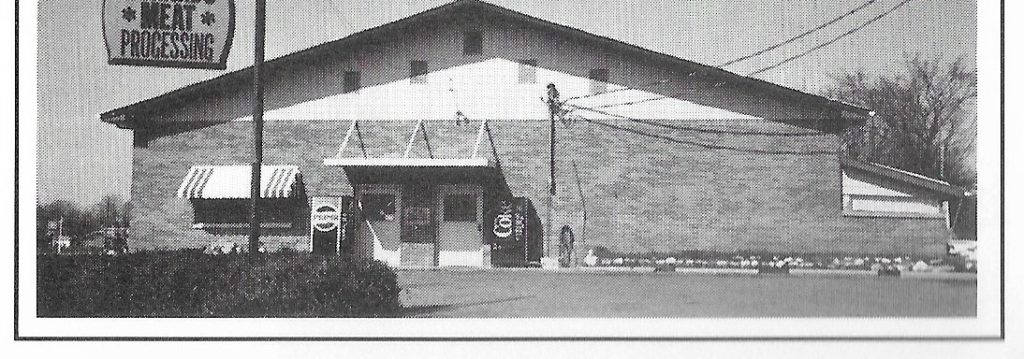
Ralph Smith's Meat Processing Plant
Norris McElmurry
The Backwards Relleps
July 28, 2023
By Lola Guess
Jay Leno with the “Tonight Show” once contacted Norris McElmurry and asked if he would fly to California and be on the show to feature his backwards spelling. but Norris declined. He was a simple man, lived a humble life in Burna, and was loved by the community. He was a high school graduate, a self-employed painter, a deacon of North Livingston Baptist Church, and a bible scholar. Norris lived in a ninety-year-old house with no indoor plumbing. He never had a phone, never married, and never drove a car.
Norris McElmurry had an incredibly special talent. He could spell words, phrases, and sentences backwards without hesitation. The Courthouse Museum is certainly fortunate to have two well-studied dictionaries belonging to Norris on display. Norris stated the longest word he could spell backward was a 45-letter word which is the name of a lung disease, and he could also spell “supercalifragilisticexpialidocious” (from the Mary Poppins movie) backward which is a thirty-four-letter word.
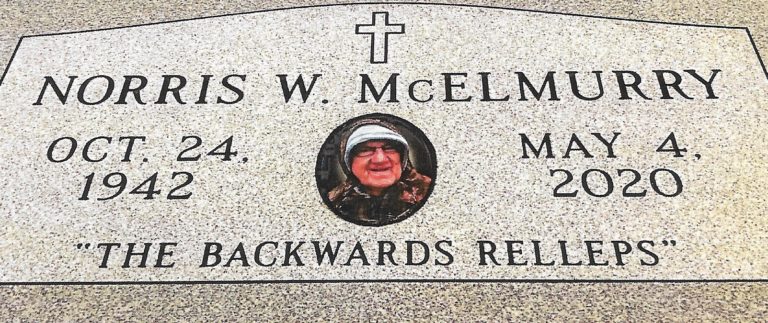
In the interview, he went on to tell that he gave up working at the radio station because he had to hitchhike to Paducah. He walked a mile or so to Burna most days to meet with his friends. Neighbors picked him up twice each week and took him to church. Although he was well-known in Livingston County, he remained true to himself and his faith his entire life…another Livingston County treasure.
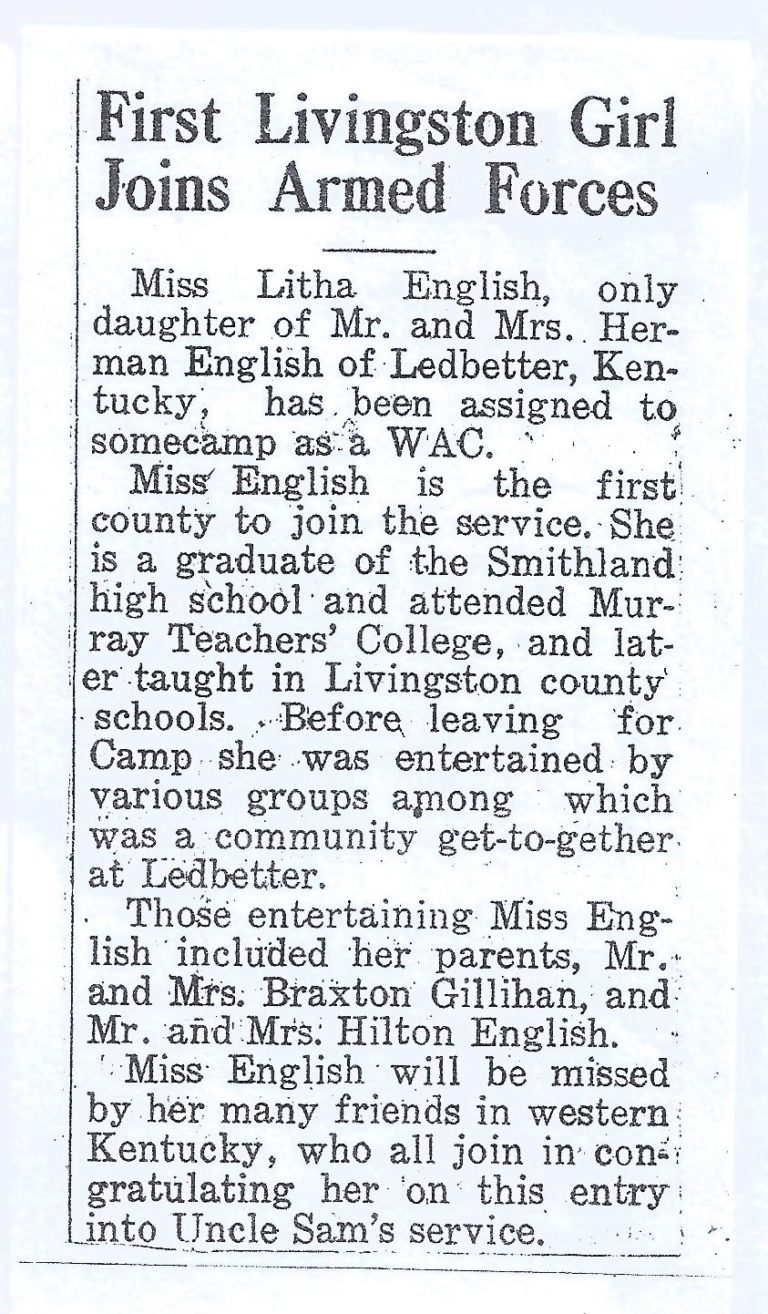
Litha Lavannia English Bass
July 21, 2023
By Lola Guess
Litha was the daughter of Herman English and Lottie Gillihan who first lived at Rappolee’s Landing on the Cumberland River. The family, which included Litha’s older brother, Clyde Hilton, moved to the Ledbetter community about 1928. Litha graduated from Livingston County High School in 1938 and attended Murray Teachers’ College for a short time. After the war began, Litha moved to Michigan. While living in Michigan with relatives, she worked at the Willow Run B-24 Liberator bomber plant where she helped build the heavy bomber for the war effort.
On April 28, 1944, Litha English joined the U.S. Army Air Corps and served until the end of the war as a Link Trainer Instructor. The article on the left was published by the Livingston Ledger and described the going-away parties given to Litha as she prepared to leave on her first assignment at an air base in Reno, Nevada. There she met Robert Earl Bass of Armstrong, Illinois. Litha and Robert were married in 1945.
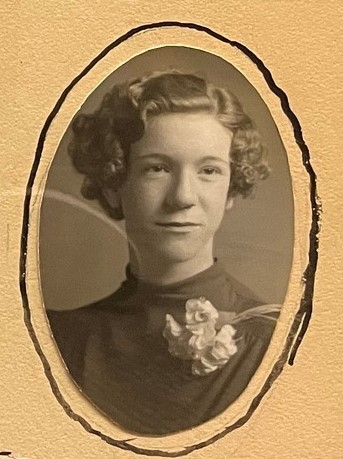
1938 Graduation Picture
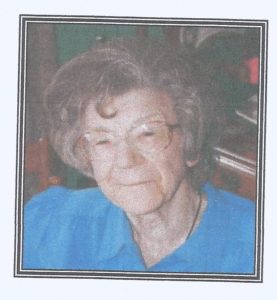
Litha Bass
Have you Visited all the Cemeteries in Livingston County?
July 14, 2023
By Lola Guess
Mary Lynn Smith Driskill is a treasure in Livingston County in many ways. For one she is a valuable member of the Livingston County Historical Society. Mary is a tireless worker collecting obituaries and information from not only local sources but also from places outside the county. She follows leads that will take her to anywhere she can gather newspaper clippings, web pages, track down telephone calls…whatever it takes to find people connected to Livingston County that have passed away. In doing this, she has visited most if not all of the cemeteries in the county. If Mary has not been there, then the cemetery is probably not accessible. Mary is then ready to publish the next cemetery book listing all the deaths in the county in the last five years. The next book is scheduled to be published in 2024.
Mary took on this task after Lovertia Stegall retired and has been working on these cemetery books for several years. She is also a regular volunteer at the Log Cabin in Smithland, greeting visitors, helping with newsletters and mailings, doing research, answering the phone, and cleaning. In other words, Mary is ready to do what the day brings.

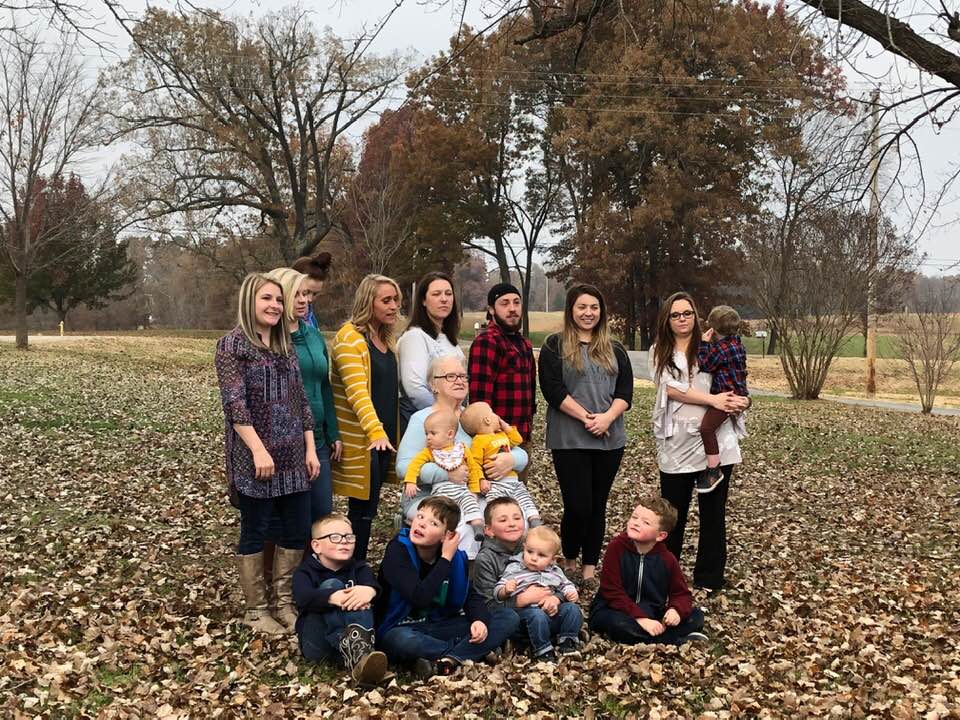
Mary was born on January 22, 1938. Her parents were William and Lillian Smith. Mary had three sisters, Edna Louise, Goldie M., Wanda Gail, and one brother Walter Beverly. Mary was a June bride as they say, marrying Charles Driskill on June 18, 1955. Their three children are Carol (1961), David (1966), and Jimmy (1969). Charles passed away in 2013 and is buried in Paradise Cemetery.
Mary is much loved by her family and spends time with her three children as well as nine grandchildren and fifteen great-grandchildren. Her hobbies are quilt making, embroidering quilts, and reading.

Charles Driskill
1934 – 2013
Buried in Paradise Cemetery
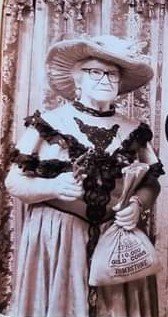
Mary Driskill
All dressed up!
Bo Moodie - Fluorspar Video
July 7, 2023
By Lola Guess
A new type of extremely powerful bomb was developed at the Oak Ridge, Tennessee, uranium production facility in the 1940’s. This facility is near Knoxville, Tennessee, and employed approximately 82,000 employees at its height during World War II. Only a handful of key people knew what was really being produced at Oak Ridge. The bomb making program was named the Manhattan Project and was said to be “the best kept secret during the war.”
The nuclear bomb production process requires spar (fluorite or fluorspar). This is the same fluorspar that was taken out of the numerous fluorspar mines around this area at that time. After years of research, study, and experimentation, the bomb was perfected and declared ready for use. On August 6, 1945, the first atomic bomb was dropped on Hiroshima, Japan. A B-29 named the “Enola Gay” was the name of the plane that flew on this mission. Then, on August, 9, 1945, another B-29 named the “Bockscar” bombed Nagasaki, Japan, subsequently ending the war.
The following is a recent video clip from Mr. Bo Moodie’s program at the Livingston County Historical Society’s meeting. Mr. Moodie and his wife, Terri, live in Livingston County. Mr. Moodie comes from a mining family that spans generations. He was gracious enough to share his wealth of information about mining, and how Western Kentucky fluorspar was instrumental in turning the tide of World War II.
Jumbo Scarbrough and His Big Fish
June 29, 2023
By Lola Guess
In the spring of 1925 , an impatient fisherman, Jumbo Scarbrough, set off a stick of dynamite in the Cumberland River. A gigantic fish surfaced and chased Jumbo’s boat to shore. Fellow fishermen Charlie Davis, Beck Bonds, and Ollie Charles helped trap and incapacitate the nine-foot-long alligator gar. They were able to tie a mule to the gar and pull it into a field. The fish was a prime tourist attraction for miles around. Phillip Smith and his sister, Isabelle Smith Thompson are in the background.
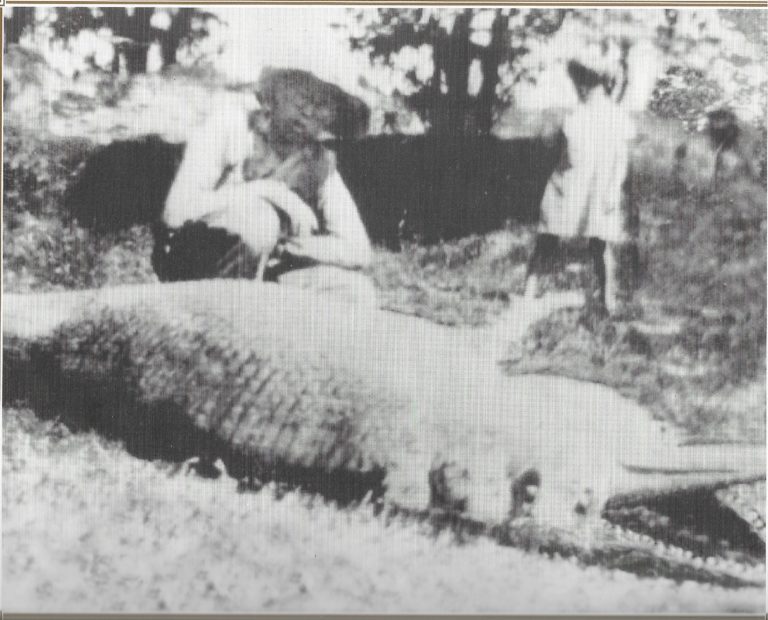
It is unknown what ultimately happened to the gar. Since alligator gar sells for about $3.00 per pound, today a catch that big would be an incredibly good day of fishing. According to Kentucky Wildlife records, an alligator gar is capable of reaching lengths of over 9 feet and weights of over 300 lbs. The largest reported size of an Alligator Gar is 9 feet, 8 inches and weighed approximately 302 lbs. The last Alligator Gar to be verified in Kentucky was in 1977 when a dead gar was found floating in Kentucky Lake near Cypress Creek. Jumbo Scarbrough’s fish was certainly one for the record books in 1925.

My Story of Mr. Bill Leffler
Smithland Memories
Paddle Wheel Boats & Stories
June 23, 2023
By Wanda Trail
I like the beautiful older boats. I have collected pictures, postcards, and lots of books on these boats. Smithland was a booming town back in the day with all the three rivers and boat traffic around the county. If the rivers could tell their stories, it would be unbelievable.
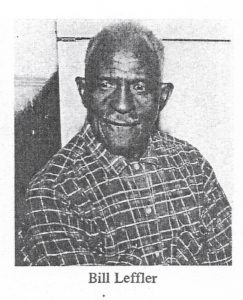
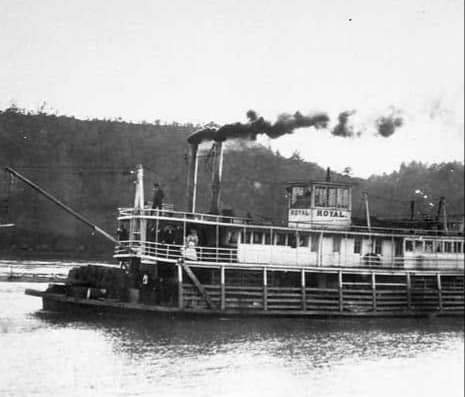
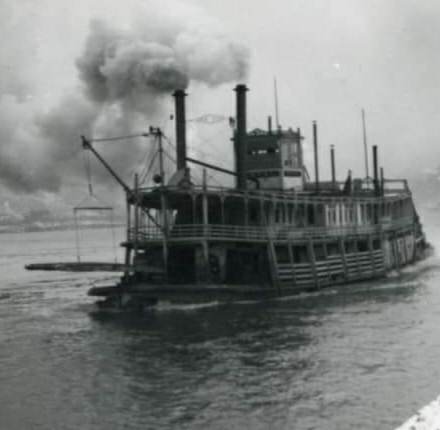
I only knew Mr. Bill in the 1960’s to 1981 when he passed away. He would show me the one special boat he made every time I went with Daddy to his house. I thought it was a very nice handmade boat. I would go every Halloween to his house. He gave me and my sisters a big nice red apple. I thought that was the best apple I had ever eaten. I can always remember him as a nice, kind, respectful gentleman to me. When he passed away his house was torn down and gone. I often wondered what happened to his boats he had made.
When I started going to the Historical Society…guess what? His boat was there and I was so excited to see his boat again. I have such good memories of him working on it and showing it to me. Mr. William “Bill” Leffler was born on January 15, 1891 and died September 20, 1981. His memory will live on forever because we have added two more of his boats with this one to our Historical Courthouse Museum. All three boats are on display for everyone to see.
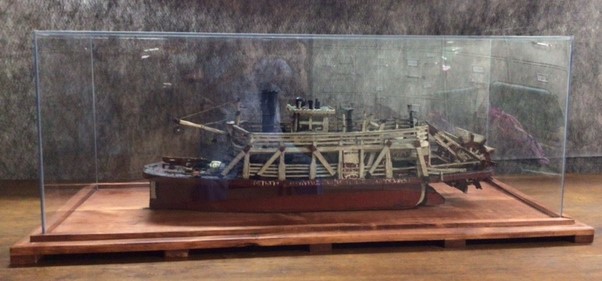
Have You Seen the Goat Man?
June 16, 2023
By Lola Guess
In the 1970’s a student dressed up as the Goat Man during the pep rallies at Livingston Central High School to help lead the cheerleaders. According to an article in the Paducah Sun dated, November 21, 1984, “Dianne Stallion, Livingston Central Middle School secretary recalled, it was all for fun.”
There have been Goat Man sightings reported around the County. According to legend, it all started at the Old Red Hole. An old iron ore pit near Tiline was claimed to be bottomless and filled with quicksand. The Ole Red Hole got its name from the reddish soil around the pit.
The Goat Man has been described as a man with a goat-like head who lived at the Red Hole. He supposedly ate people and threw their bones in the pit. He would appear only one week a year, but nobody knew when that week would be. People would drive their horses and buggies quickly by the pit. There were reports of glaring eyes and startled horses as they drove by. Something unseen near this site frightened a man’s horse so much that it threw him off, saddle and all. Children were warned not to go near the pit especially after dark.
(If there was a picture of the Goat Man, it would be here!)
In later years, the Goat Man was reported to be living in a barn. The Red Hole has all but dried up. Is that why the Goat Man chose to move to another location? Another article states that a half-man half-goat like creature was sighted in Livingston County and that an albino deer was seen and killed near where the Goat Man appeared.
Although there aren’t many stories being told nowadays about the Goat Man, who knows…he may go on a rampage again someday.
Murder at the Monument
End of Watch - Badge #4
June 9, 2023
By Lola Guess
Sunday night, September 9, 1984, was a pleasant 68 degrees with partly cloudy skies in Smithland, Kentucky. Deputy Carnie Franklin Hopkins left the dispatch office after checking in with Marvin Warren, the dispatcher on duty. He told Warren he was going to drive toward Salem to continue searching for an escaped convict from Illinois. The convict was named Edward Charles Cox an escapee from the Hardin County Correctional Center. Cox was serving a seven-year term for burglary when he escaped.
At 11:20 Deputy Hopkins called in on his two-way radio to the dispatch office that he was going to exit his vehicle to check on a “suspicious” hitchhiker. Approximately ten minutes later, Warren had not heard back from Hopkins and couldn’t reach him on his radio. This was not unusual since the area is hilly and contact was sometimes difficult. He decided to contact Deputy Orville Gilland who was on his way to work and have him check on Deputy Hopkins. Jack Day was sheriff at that time.
Deputy Gilland pulled in at the intersection of US 60 and Highway 137 about two miles east of Smithland which is known as the site of the “Monument.” He discovered Deputy Hopkins lying in front of his own cruiser. The lights were still on and the motor running. This was at approximately 11:30 p.m.
According to several newspaper reports, Deputy Hopkins, age 56, was shot in the upper chest with his own standard issue service weapon which was a .357 magnum. The gun was left at the scene and there was evidence of a scuffle. Although he was still alive, he was unable to speak to tell what had happened. Deputy Hopkins was pronounced dead at 12:45 a.m. on his way to the hospital.
A witness reported seeing a pedestrian walking toward Burna at approximately 11:10. The witness described the person as a white man approximately six feet tall dressed in a white T-shirt and jeans. Dogs were brought in to search the area, but no leads were discovered.
Scene at the Monument
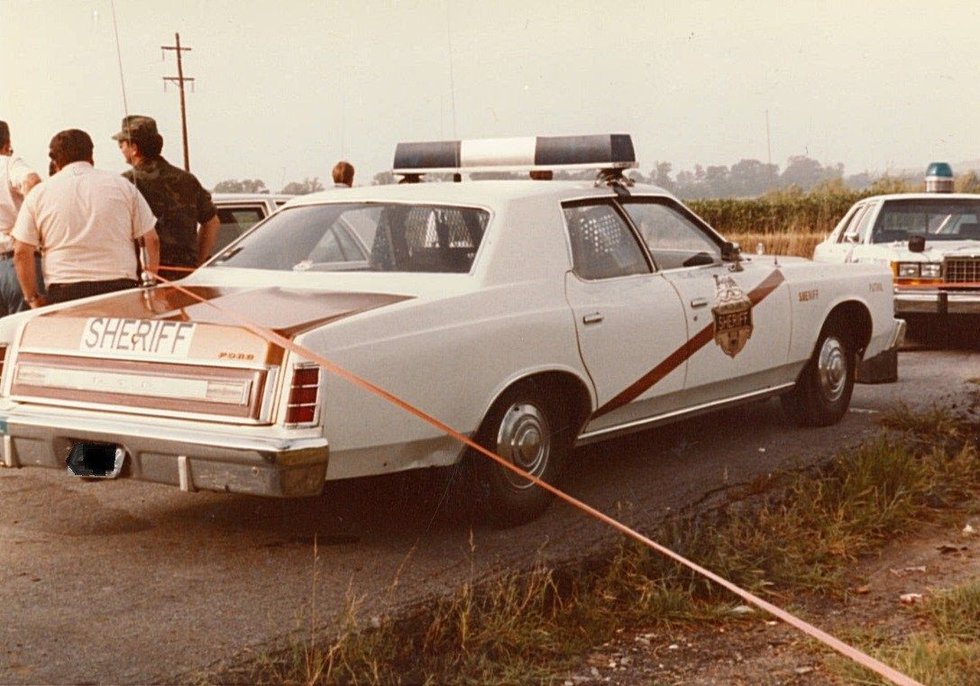


On June 2, 2023 a memorial ceremony was held in Smithland honoring the fallen officers in Livingston County. A beautiful memorial located in the Livingston County Museum Courtyard was unveiled. Sheriff Bobby Davidson and other dignitaries paid tribute to Deputy Carnie Hopkins along with four other fallen officers. They are Deputy Roger Lynch, Officer John Gooch, Officer Brian Jones, and Trooper Eric Chrisman.
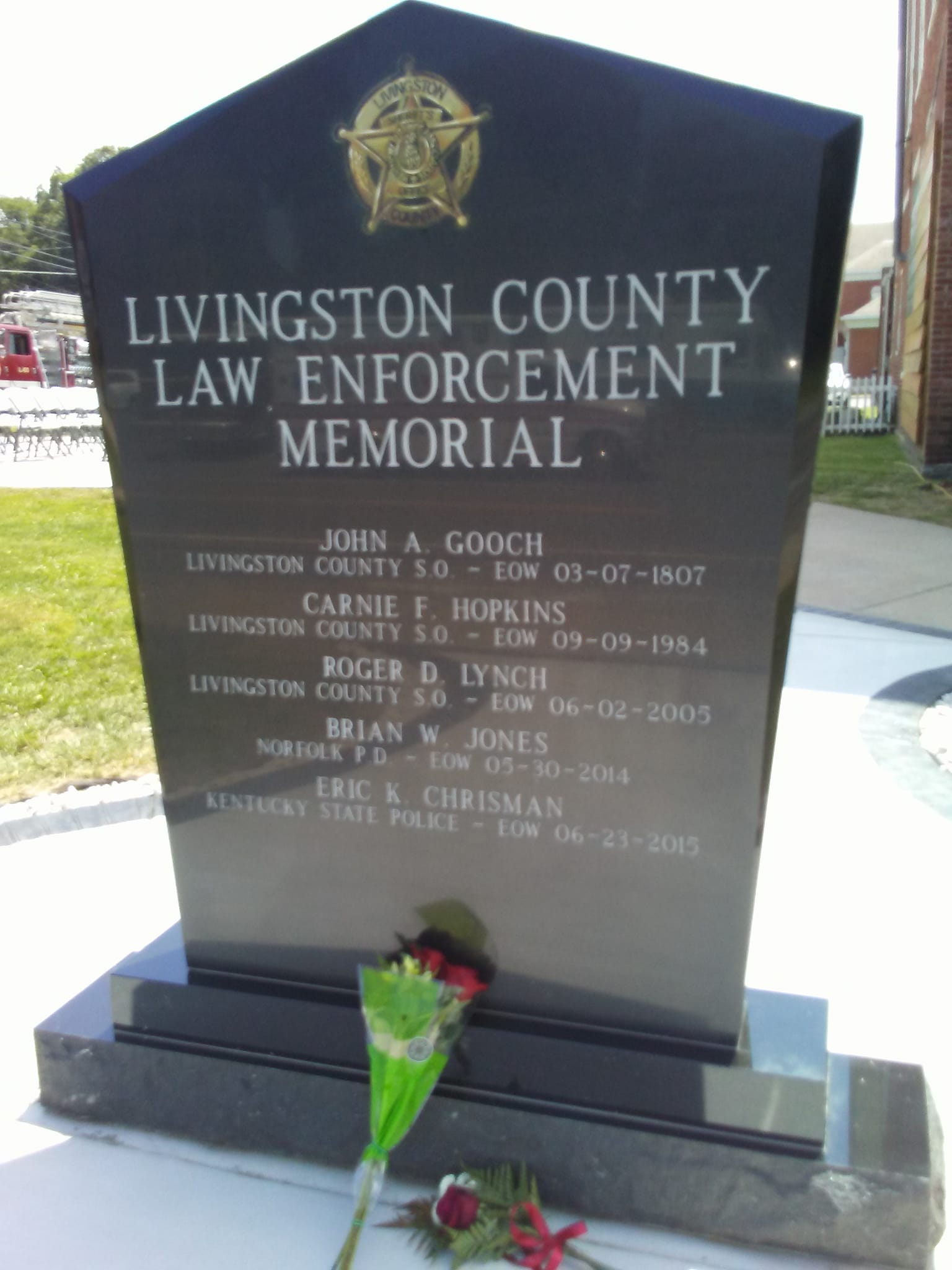
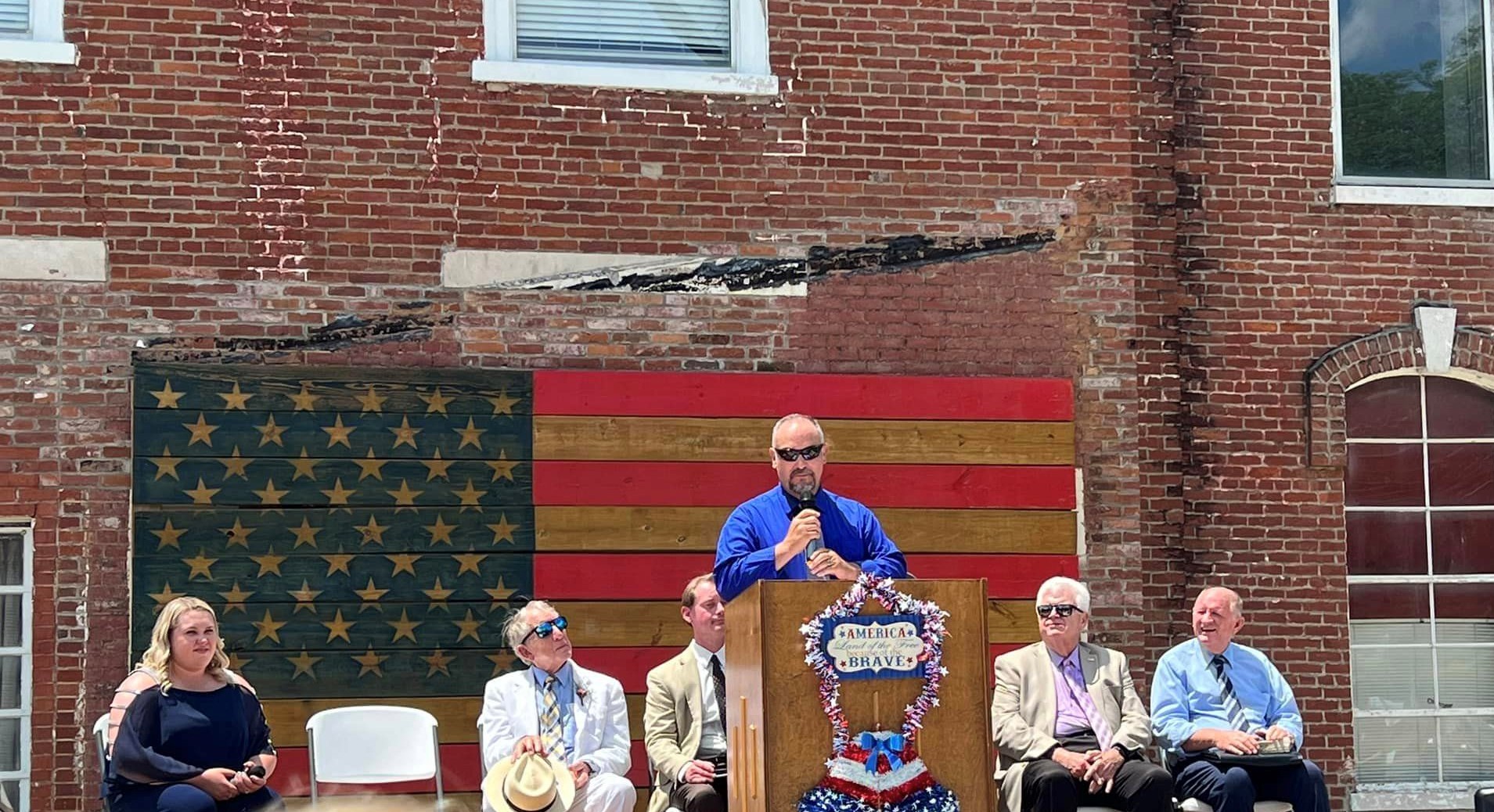
Carnie Hopkins was born on June 30, 1928. He enlisted in the Air Force during WWII. He was a trustee for the Ledbetter Fire Department, a member of the Ledbetter Optimist Club, the Smithland Masonic Lodge, the Ledbetter Church of Christ, and a member of the Board of Directors at the Bank of Livingston County. He was the first deputy to have been killed in the line of duty in Western Kentucky. Hopkins was survived by his wife, Rose Mary, and three children. He was the son of Frank and Fennie Dunning Hopkins. The service was held at Roth Funeral Chapel in Paducah with burial in Oak Grove Cemetery in Ledbetter.
In March 24, 2017 the case was reopened due to new information and technological advances. The Kentucky State Police asked for help from the public. There have been no arrests in the murder of Carnie Hopkins. The case remains unsolved as of this date.
In Remembrance of all Veterans Who Served
June 6, 1944 D-Day
Red - Letters from WW2 Soldier Bud Threlkeld
By Alexa Black
June 2, 2023
One veteran who fought during WW2 and survived The Battle of the Bulge was late Private First Class Harry (Bud) M. Threlkeld, Jr. who was a resident of Carrsville; a small river town in Western Kentucky. The family later relocated to Memphis, TN after his parents divorced and his mother remarried. Bud was the son of Harry and Mamie Threlkeld and was the brother to Charles Threlkeld. Bud left behind him with his family a series of WW2 memorabilia, v-mails, (veteran mail), letters and etc. written out to his parents, friends back home and his brother Charles who was also a WW2 soldier. The letters detail the beginning to the very end of his service.
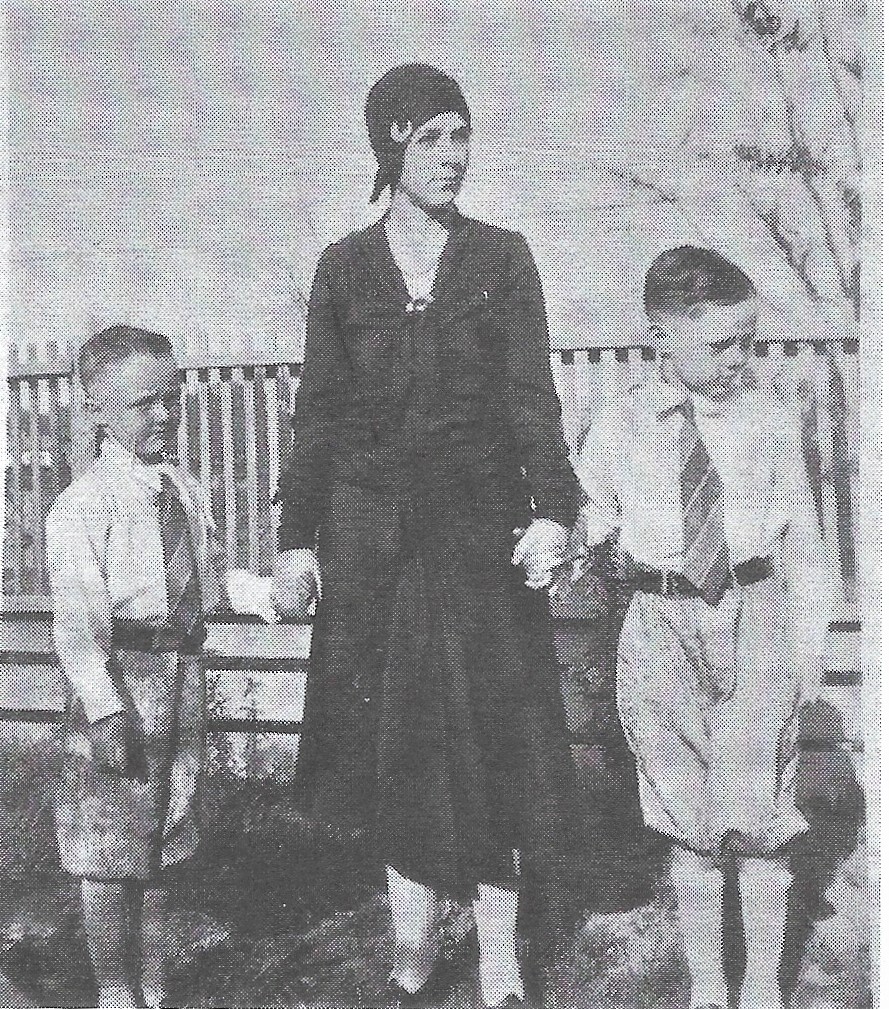
Bud (left) Mamie (middle), and Charles (right).
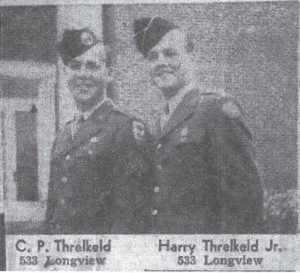
Newspaper clipping. Charles (left), Bud (right).
“You see I have traveled quite a bit. One of these days I’ll be back in the living room with you, Dad and Charles will have long forgotten these unpleasant things. I just sit and dream of home day and night and I can almost taste those good eggs, his biscuits, steak, and beef gravy you used to cook us for breakfast. I would even settle for some buttered toast. It is getting closer to Thanksgiving and I know I sure do have a lot of things to be thankful for though.”
“Dear Mom and Dad, it is about 11 now and I am sitting in my foxhole writing. My hands are very stiff from the cold but you can probably make it out. I was using my helmet as a writing table but the Germans started throwing the artillery in too close so I had to put my helmet on and just use a piece of cardboard to write on. I have to stop and duck every now and then, but I will get it finished before very long. Sometimes I think the Germans don’t like me so much because they keep shooting at me! They just need to see that I am a nice, loving man.”
“I have my rifle slung across my shoulder now loaded, and it seems a little unnatural. I can’t say I’m not scared now. Maybe it’s only the premonition of what is going to happen, it is supposed to be bad. I’ll know more about that sooner than I want to. Anyways, the French and Belgian people seem very friendly towards the Americans. I sure would like to be in the states with you all and maybe it won’t be too long until I can. “
Bud had written a few more letters to his mother and father over the course of November, none seemed as though he could give too many details about the combat he had been involved in. However, according to Bud on December 1st that had quickly changed in the last week. He had yet again found himself in another foxhole.

Alexa Black is an author, illustrator, and a musician. Alexa has won a variety of local competitions for her artwork and writing…She is looking to publish her other works. For a copy of this book contact Alexa Black.
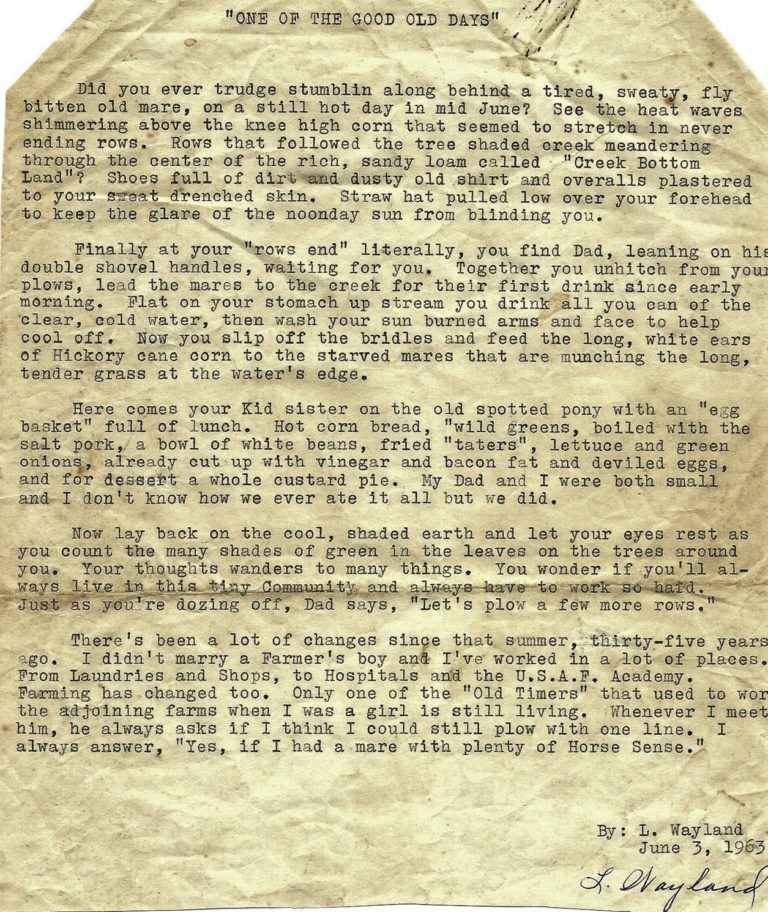
Linnie Esther Alsobrook & Alfred Clement Wayland
May 26, 2023
By Linda Phillips Fox
Linnie Esther Alsobrook was the first child of Martha Lee Bateman and Edgar Alsobrook. She was born on October 27, 1912 near Salem, Kentucky. Linnie married Alfred Clement Wayland on December 21, 1932. Their five children were Edgar C. (E.C.) born in 1936, Alvin B. and Alvie C. (twins) born on July 28, 1938 and both died in October of 1938, followed by Perry Andrew (Drew) in 1941, and Martha Lee in 1946.
Alfred worked in the Klondike mines where he contracted tuberculosis. They moved to Colorado Springs, Colorado where he soon recovered. Alfred was a top-notch mechanic and could easily find a job. They lived in many places, including Illinois, Kansas, California, and New Mexico. Alfred passed away in 1994.
Linnie was a very talented artist and published poet. She was in her nineties when she painted a picture that sold for several thousand dollars at an auction for Alzheimer’s Research. She was also an excellent seamstress. Linnie worked at the Air Force Academy where she altered uniforms for the cadets. She loved young people and would tell us about how many of the young cadets were so homesick when they first arrived. She would bring them some of her home baked bread and cookies to cheer them up. Linnie lived to be 100 and died on December 2, 2012. There are many advantages to being the oldest child but also a lot of responsibilities. Linnie describes a typical day in a story she wrote.
The People with the Big Scissors
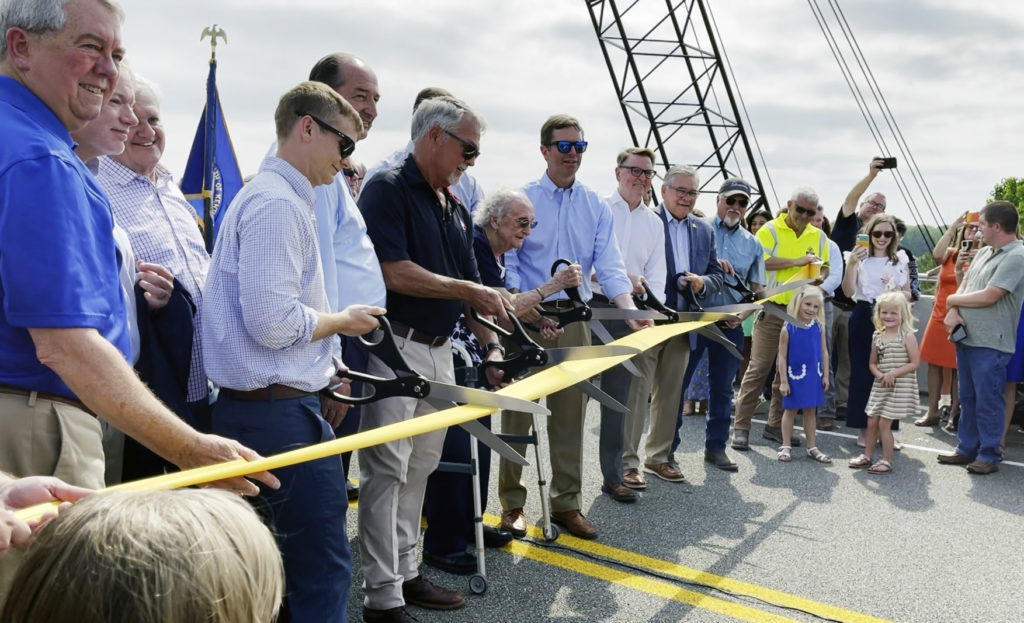
Usually, Livingston County is a quiet, peaceful place, but when the Jim R. Smith Memorable Bridge in Smithland, Kentucky, opened on Monday, May 15th, 2023, people were allowed to walk across the bridge before it opened to traffic later in the day. Politicians, students, residents, workers, historians, and the curious turned out for the walk and the ribbon cutting ceremony.
Ribbon cutting ceremonies date back to 1898 when the first ribbon cutting ceremony was believed to have been held at the opening of the Louisiana Railroad Line. The use of ribbons originated in military ceremonies and symbolize awareness and support. The big scissors and giant ribbons were introduced by Walt Disney and used at the openings of the Disney theme parks. Ribbon cutting ceremonies themselves symbolize a significant moment, or to mark a new beginning.
Livingston County celebrated this new beginning with five people holding the big scissors. Starting on the left, residents were proud to have our own Livingston County Judge-Executive Garrett Gruber in the ribbon cutting line. Judge Gruber is a second-term judge and keeps the business of Livingston County running smoothly. The next person ready to cut the ribbon is Rex Smith, President and CEO of Jim Smith Contracting. Smith Contracting was awarded the contract to build the $63 million bridge in 2020. The bridge was subsequently named in honor of Rex Smith’s father. Next in line is Ms. Muriel Dickerson. At 102 years of age, Ms. Dickerson resides in the Salem community and was present at the opening of the old bridge in 1931. Kentucky Transportation Secretary Jim Gray is next to Governor Beshear followed by Randy Bridges, Third District Representative. On the far right is Mike Smith, also a son of the late Jim R. Smith.
Livingston County is proud of the new bridge and honored to have these people in Smithland to celebrate with us. What happened to the scissors? The only thing I have been able to find out is the “keeper of the scissors” collected them after the ceremony to be used again at the next ribbon cutting. Which, as they say, is a good thing.
A Ghost Story in Livingston County
By: Carroll D. Walker
Carroll D. Walker began his career as Cashier of The Bank of Livingston County and later was elected to the office of County Court Clerk. Sadly, Carroll passed away in 2021 at the age of 78.
Among many of his hobbies and interests, he also enjoyed a good ghost story. He loved to talk to people and if they knew a ghost story that had been handed down, he was ready to write down the tale. He collected several stories through the years. This is one of my favorites.
Silas was a hard worker. His corn crop was proof of that. It was 1902 and Silas was in the field late in the day as usual. He was watching an approaching storm. Dark clouds were building and the corn stalks were rustling as the wind began to build. Silas needed to get the last few rows of corn plowed before the rain beat down and packed the dirt. He turned his team and began plowing the next row as the storm continued to move closer.
Ida prepared a late supper that night knowing Silas would use all the daylight he could in the corn field. It was well after dusk when Silas, covered with sweat and dirt, finally turned the mules loose and made his way to the house. He washed up and turned the coal oil lamp higher. Lightning flashed and then the distant sound of thunder sounded as the curtains in the kitchen window fluttered.
“Looks like a good un.” Silas told Ida as he sat down to eat. “We need the rain but this storm has been building for a long time today.”
Ida merely nodded and soon began to clear the table and wash the dishes. The front porch ran the length of the house, and Silas went out to smoke his pipe and sit in his favorite chair.
Their son, Amos, was sitting on the porch steps and the dog, Jack, came out from under the house to join them. Amos began telling his father that Jack had chased a rabbit that day.
“Did you get him?” asked Silas.
“Naw, answered Amos. “ Jack got tired and gave up. The rabbit ran under the wood pile and Jack just lost interest.”
A loud clap of thunder sounded in the sky as the storm moved closer and the wind picked up straw and dust. Silas and Amos decided to go in the house. Silas needed a cup of coffee.
“Listen! Did you hear that?” Silas asked. “Sounded like a whistle from a steamboat.” The room became quiet as they strained to hear above the thunder and the rain pelting down.
“Yes, I heard it.” Ida said. “Sounds like it’s coming from down around the creek.”
“Wait, I hear a different whistle coming from the other direction.” Silas said.
As the family listened in the kitchen under the dim lantern light, the storm continued to rage. Thunder and lightning drowned out the whistles from time to time. Finally, they could hear a steady blast of intense whistles. Then they hear a loud crash. Silas jumped from his chair and ran to the window unable to see anything other than the rain.
“I believe there was a steamboat crash out there on the Cumberland River just now.” Silas stated. They continued to look out the window and as the lightning lit up the yard, they saw a lone figure approaching the house carrying a lantern. The stranger was wearing a black raincoat and boots that came up to his knees. He wore a black hat and rain was dripping off the brim as he climbed the porch steps. The man knocked and Silas slowly opened the door and asked him to come on in out of the storm.
The stranger did not reply and merely stood on the porch. Silas asked him if there was a boat crash. Again, there was no answer and the figure slowly faded away as the family stood watching in the doorway.
When daylight came, Silas walked to the neighbor’s house to see if they heard all the commotion down on the river during the night. They had not heard or seen anything. No whistles, no crash, no lone man carrying a lantern.
This was not the last time Silas and his family heard the steamboat whistles, the crashing sound, and the stranger on the porch. Silas never answered the door again after hearing the crash and the frantic knocking. The incident always happened during a summer thunderstorm.
Other families that lived in that house and in another house that was built on the same site also experienced the ghostly appearance and the sounds of steamboats just as Silas, Ida, and Amos did many years ago.
Salem - The Big Spring Meeting House
May 4, 2023
By Lola Guess
The following is an excerpt from Leslie McDonald’s book titled Echoes of Yesteryear, published in 1972. Mr. McDonald tells about one Sunday in 1826 when Reverend Peter Cartwright, a Methodist minister and a traveling evangelist preached at the Big Spring Meeting House. It was an all-day meeting with “dinner on the ground.”
” Within half an hour after the service, the big spring, which was but a short distance from the meeting house was surrounded by groups of men, women and children. Many were seated on benches brought from the schoolhouse, which was nearby, and others were seated on the ground. Before them was spread upon clean, white cloths such an abundance of cold provisions that all could be supplied. There was cornbread, light bread, biscuits, broiled and boiled ham, broiled chicken, dried beef, venison, dried peach and apple pies. pickles, etc. The company had a most sociable and enjoyable time.
The Reverend Peter Cartwright was one of the most outstanding pioneer preachers and later ran for Senator in Illinois against Abraham Lincoln. Cartwright’s listeners were often afflicted with the jerks, a nervous affection which according to him seized the non-sympathetic and the sceptic, along with the enthusiastic. Saints and sinners alike would rise up and dance while so affected to obtain relief. Once he told a man to pick up his cross and follow Christ and was amazed when the man picked up his big, f– wife and started carrying her away on his back! Cartwright told the man that he didn’t think that was exactly what the Lord had in mind…The Reverend Cartwright’s father was a veteran of the Revolutionary War. He lived on Bissell Bluff and lived to be a ripe old age. He is buried at Bissel Bluff.”
This book is available in the Store. There are 232 pages of information, stories passed down through the years, and memories of Mr. McDonald.
Carl Talley - Mint Springs
April 28, 2023
By Lola Guess
There is a community in Livingston County named Mint Springs. It is located on Highway 70 and was so named because mint grew abundantly around the springs. Through the years, Indian artifacts have been discovered around the spring. The Indians were undoubtedly attracted to the clean, clear, natural underground water source. The following is a picture of the Mint Springs Baptist Church and the two Kentucky highway markers beside the church.
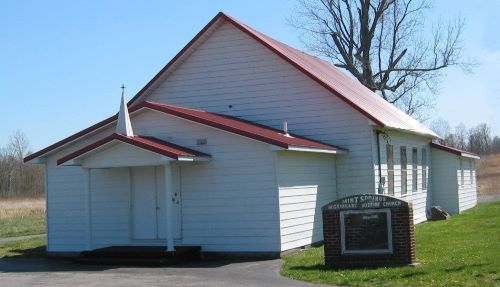
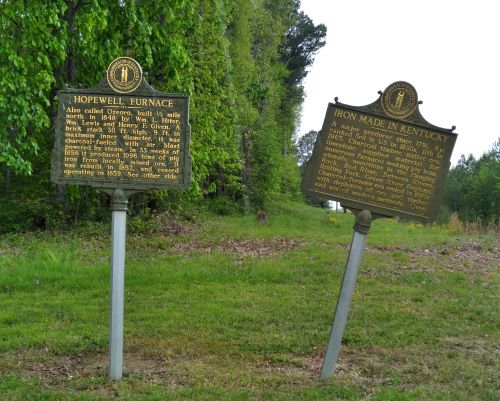
In the 1800’s, Effie Champion and her brother Fred inherited a farm at Mint Springs from their father and mother, John and Julia Champion. Julia was responsible for giving the land from this farm to Mint Springs Church. Effie married John Edgar Talley. They lived and worked on the farm for several years and it was also home to their nine children, Everett Reed, Mary Etna, Ora May, John Elbert, Olive Ollie, Carlton Matthew, Julia Alberta Pearl, Opal June, and Nina Daphne Talley. Carlton or “Carl” was the sixth child and was born on September 22, 1910. These pictures show Carl working in the field on the farm at Mint Springs. He is also shown holding his great-niece, Benita McDonald Jones.


Carl’s dedication to his work is proof that he loved the farm and relished working in the fields. But fate would interfere in his activities in the form of polio. The horrific disease did not stop Carl. He contacted Dearborn Motors in Detroit, Michigan, and ordered a custom-made tractor that he could drive after polio crippled his legs. The letter from Dearborn is dated 1948, so he contracted polio sometime before his 38th birthday. This shows Carl’s strength and courage. He did not give up. He found a way to do what he loved and lived his life in spite of the hardships that came his way.


Carl died on August 24, 1964, at Salem Hospital and is buried in Paradise Cemetery, in Grand Rivers, Kentucky. His death certificate states he was attended by Dr. Roscoe Faulkner and passed away from pulmonary tuberculosis at the age of only fifty-three. There are, of course, descendants of Edgar and Effie Talley and their children living in Livingston County today. If anyone has additional information to share about Carl, please use the contact button or post on Facebook.
Pictures courtesy of Benita McDonald Jones
Livingston County, Kentucky
April 15, 2023
An Introduction
Thirteen counties were established by Kentucky lawmakers in 1798. This was the most counties ever created in Kentucky in one year. The Legislature authorized the formation of Livingston County on December 13, 1798, which was six years after Kentucky became a state. Since Lyon County was a part of Livingston at that time, Eddyville was the first county seat. In years following the selection of Eddyville, the county seat was moved several times which included Centerville, Salem, and finally Smithland in 1841. Subsequently, a courthouse was built in Smithland. It was completed in 1845 at a cost of approximately $6,000.00 and still stands today.
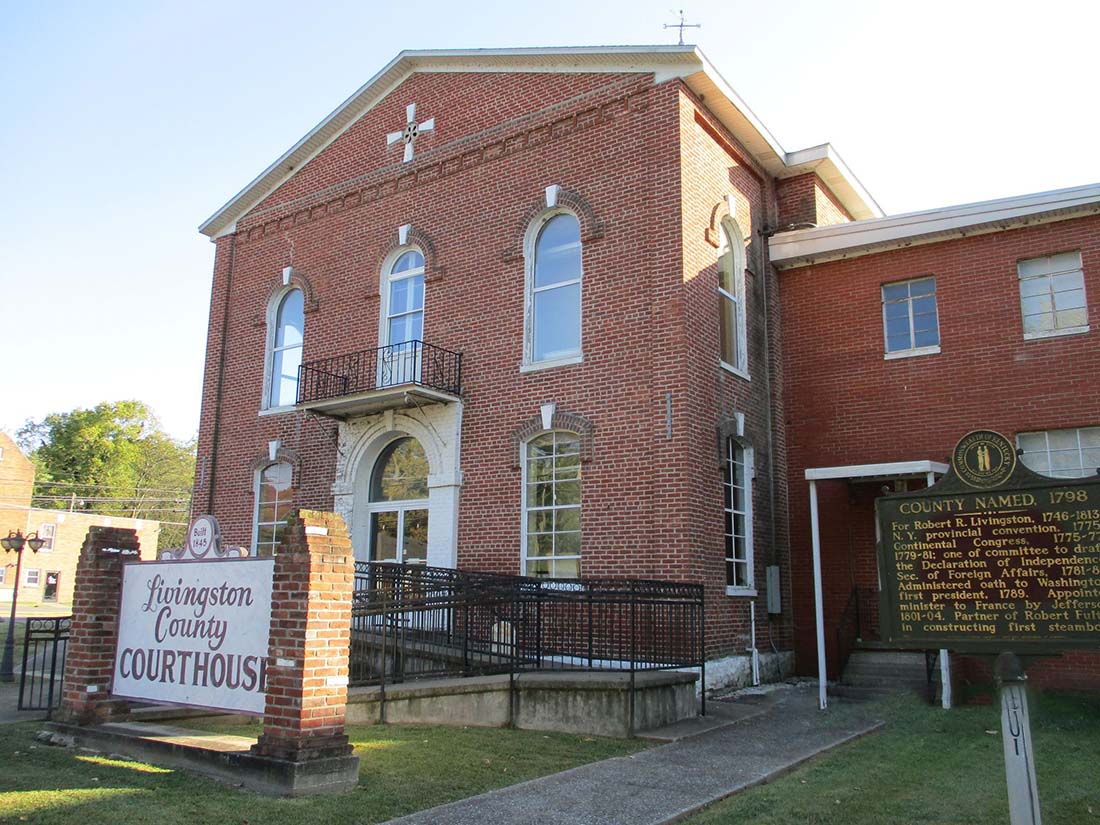

Livingston County is beyond comparison when it comes to natural resources, scenery, and impressive landscapes. Local fishermen enjoy the numerous creeks with names like Sugar Creek, Paddy’s Creek, and Bayou Creek. Thousands of tourists visit Kentucky Lake and Barkley Lake every year for recreation, fishing, hunting, camping, and sail boating. The rivers surrounding the county are dotted with tree-filled islands and sand bars can be spotted along the banks. Caves with intriguing pasts, deep limestone quarries, and famous rock formations such as Mantle Rock and Mandy Falls are popular attractions to explore. Several hundred Cherokee Indians stayed at Mantle Rock in the winter of 1838-1839. Many of them perished as they waited to cross the river on the “Trail of Tears.” Bissel Bluff and Newman’s Bluff are steep limestone and sandstone bluffs that were formed thousands of years ago. There are fertile river bottoms for growing crops and rolling green hills that provide pasture for livestock. This land in the region of the lower Ohio Valley along with the Cumberland, Ohio, and Tennessee Rivers is unique and rich in history. The Livingston County Historical Society is dedicated to exploring Livingston County, capturing the diversity of the region, and preserving the articles that are important to our heritage. Our goal is to provide a place for everyone to visit, research, enjoy, and be a part of our journey.
